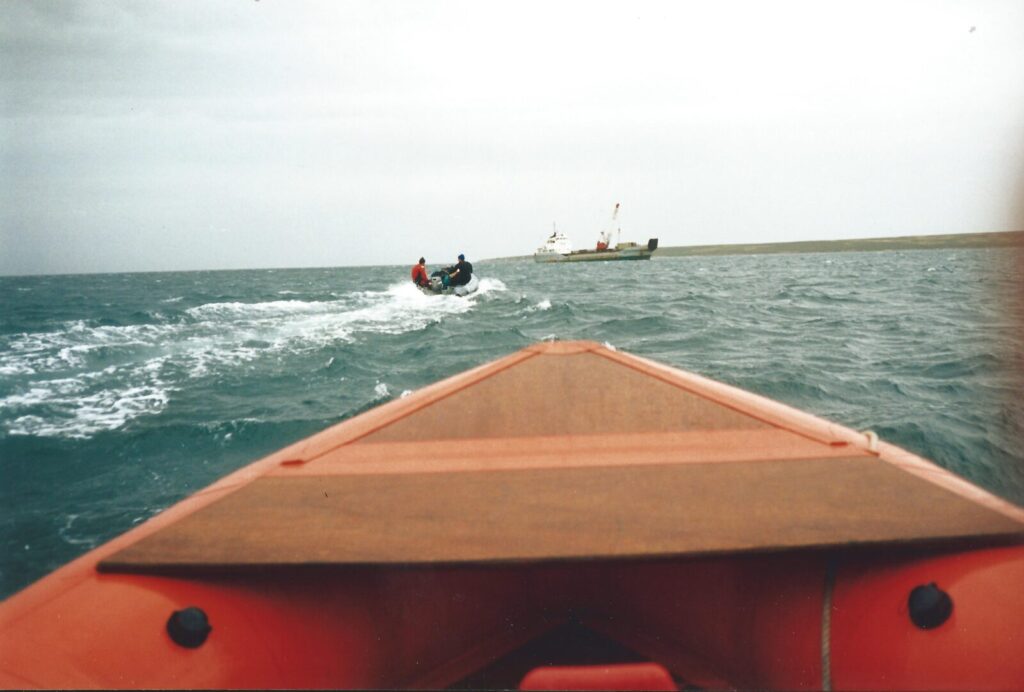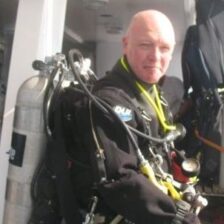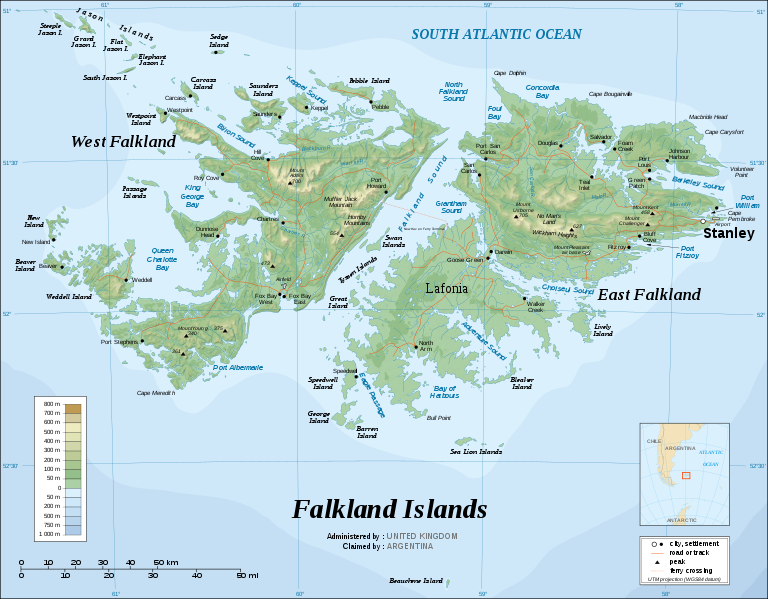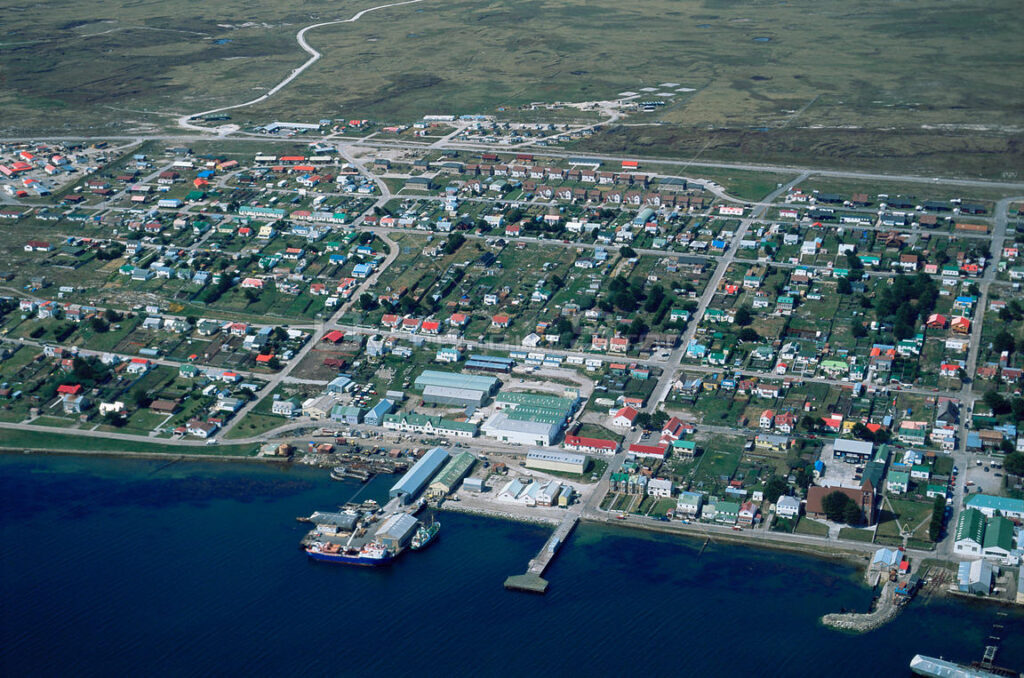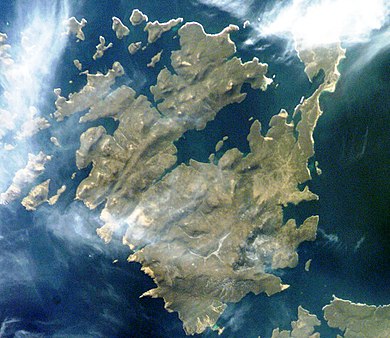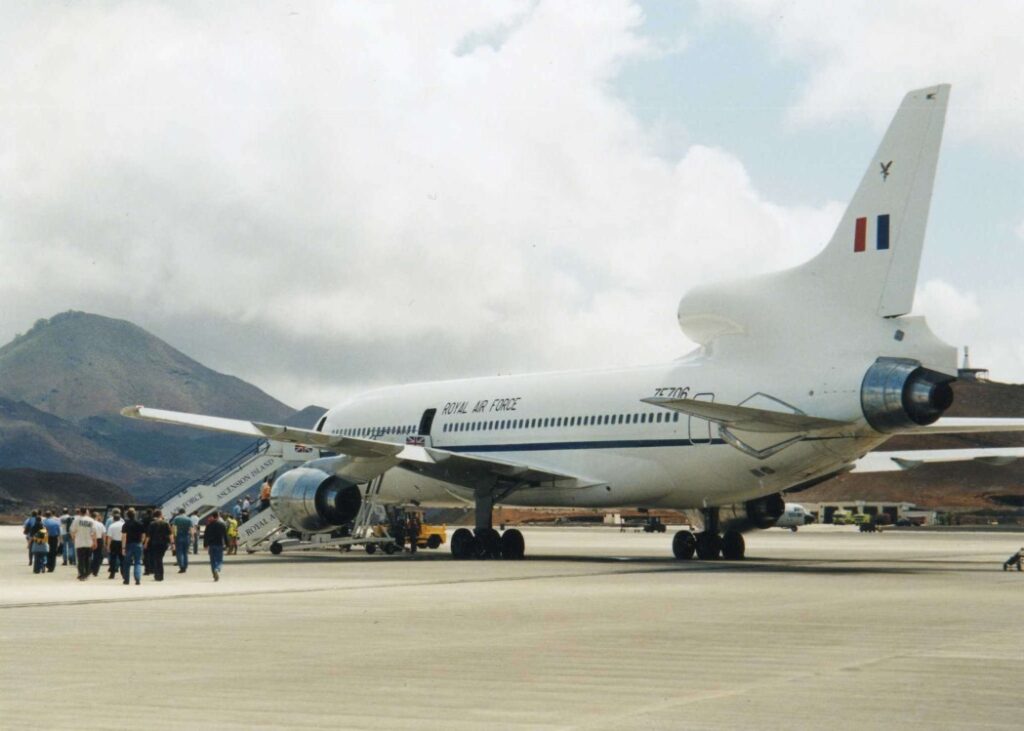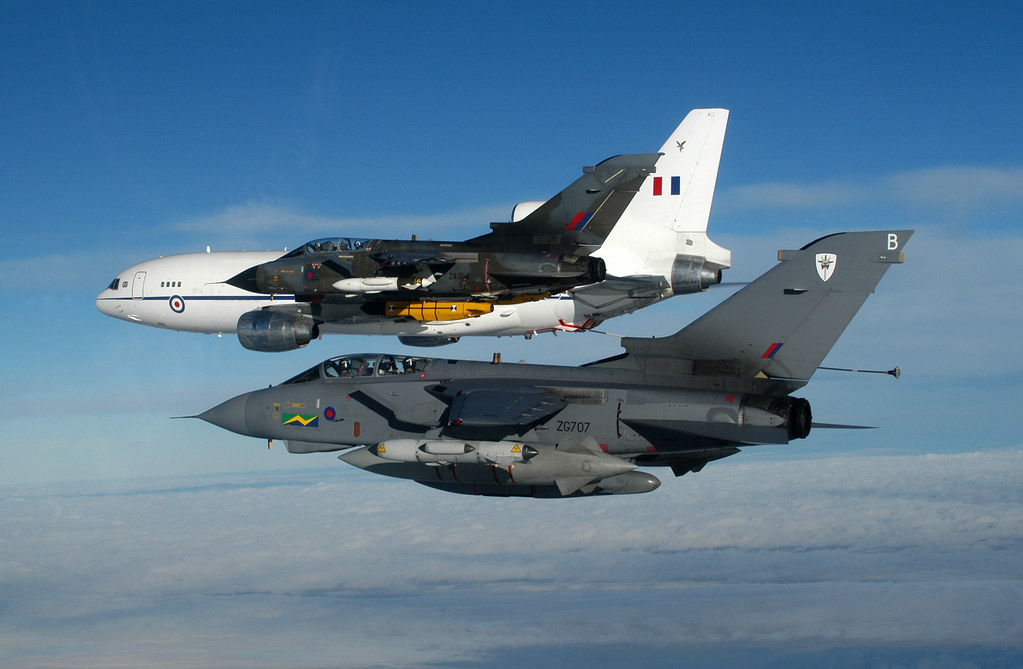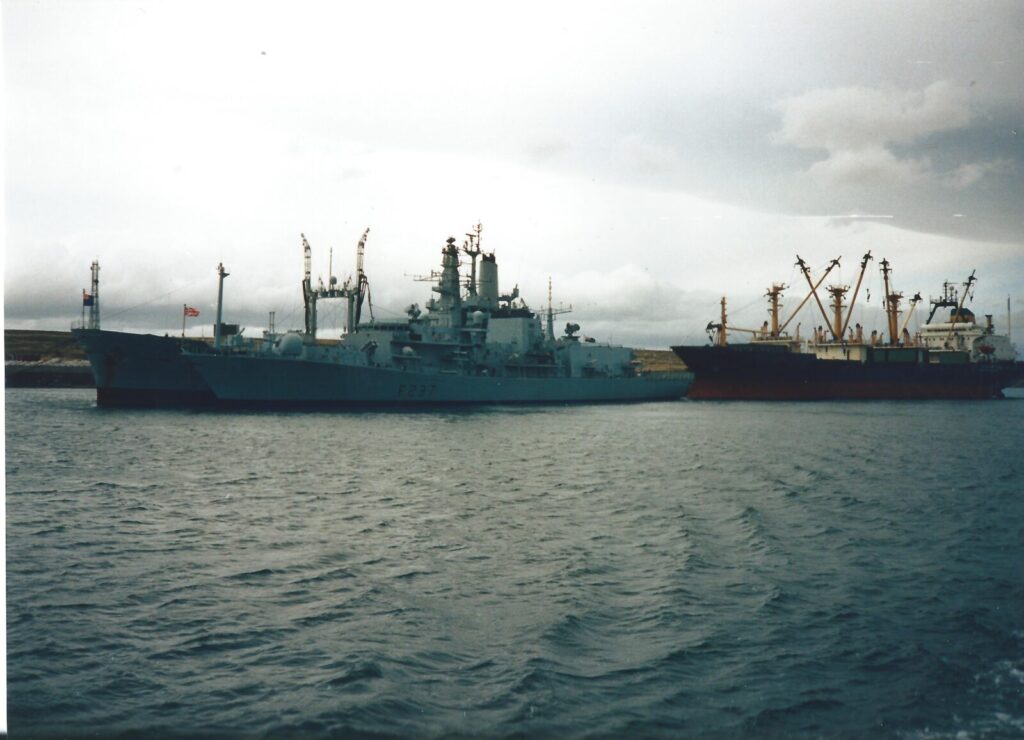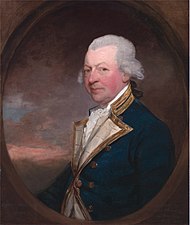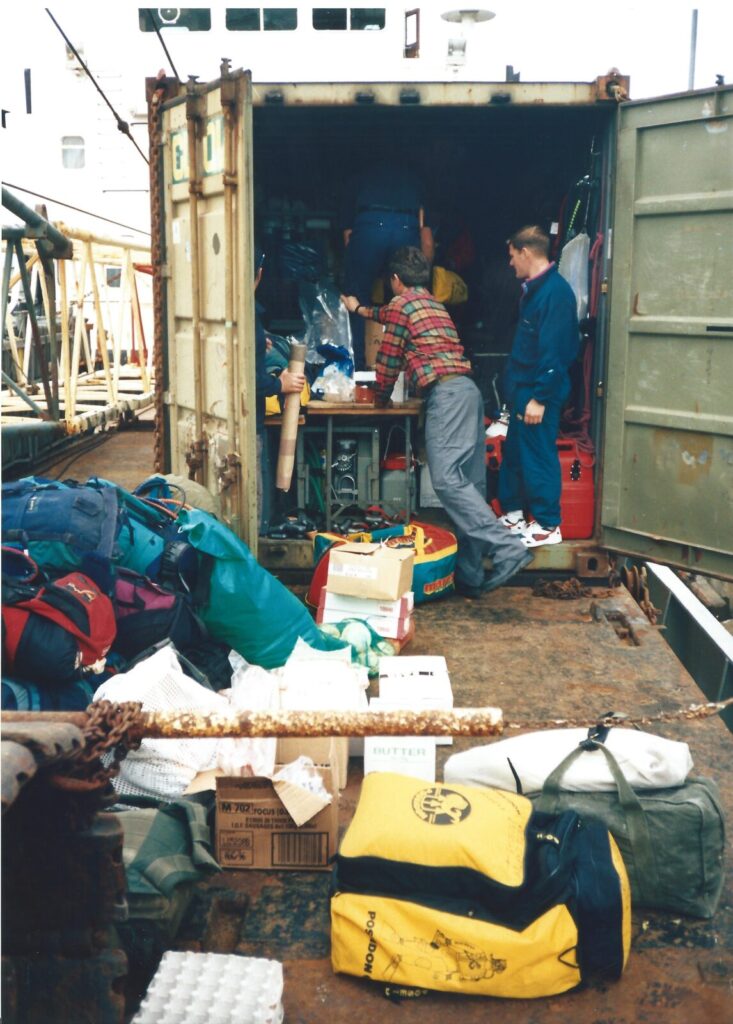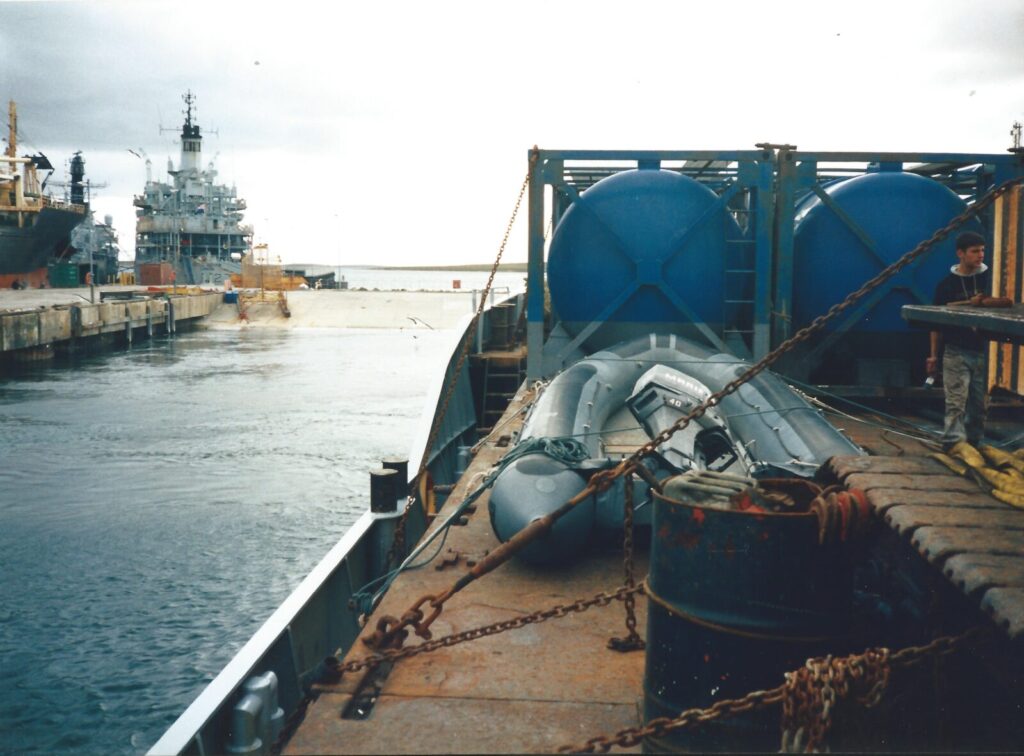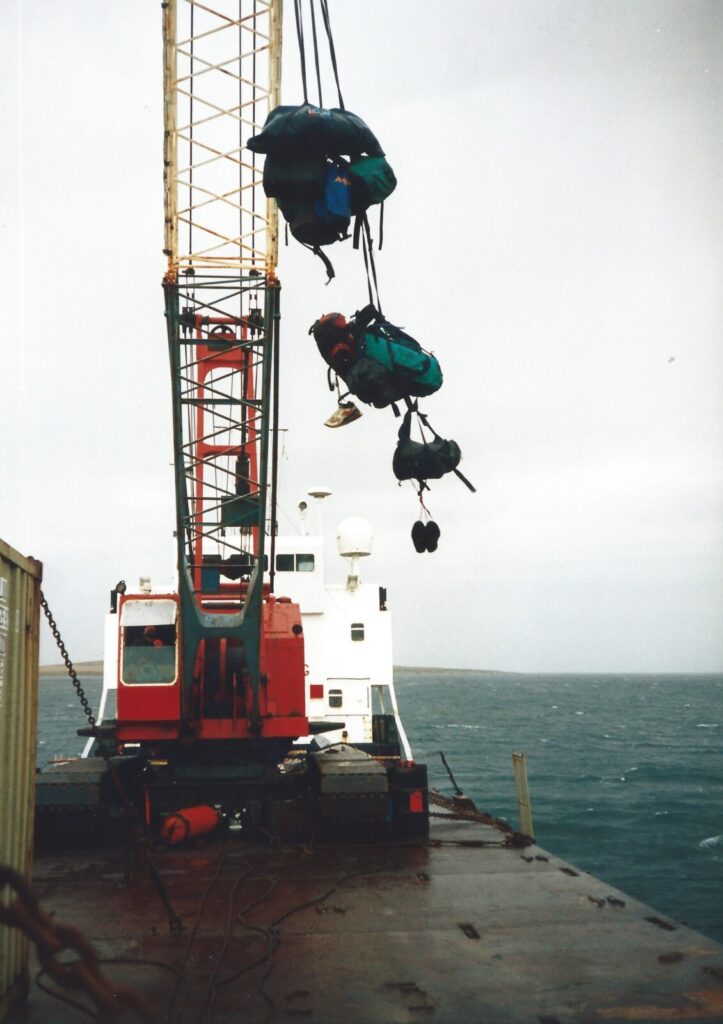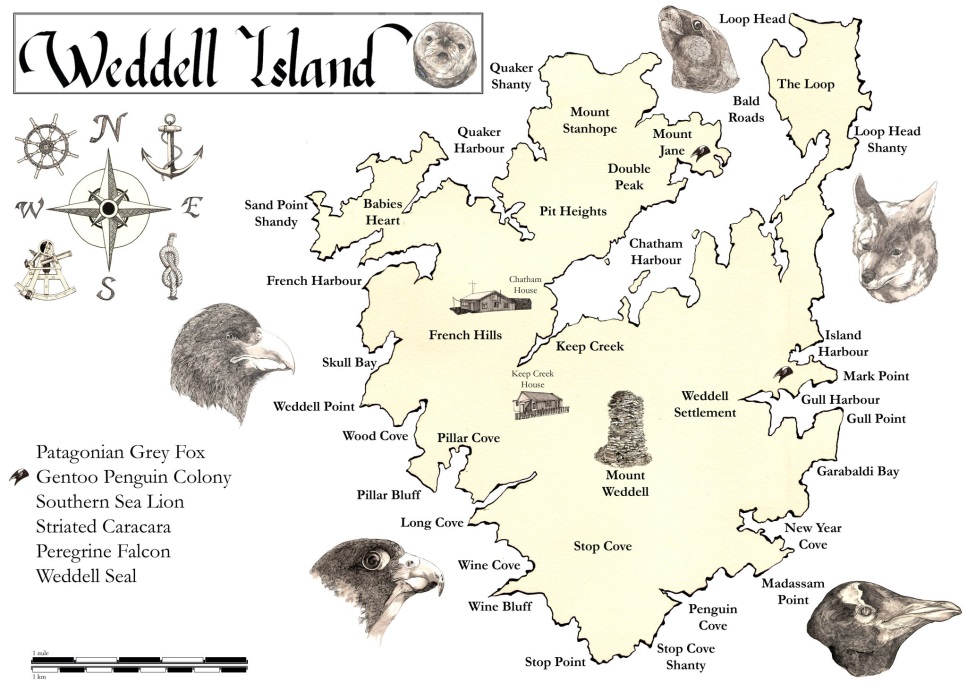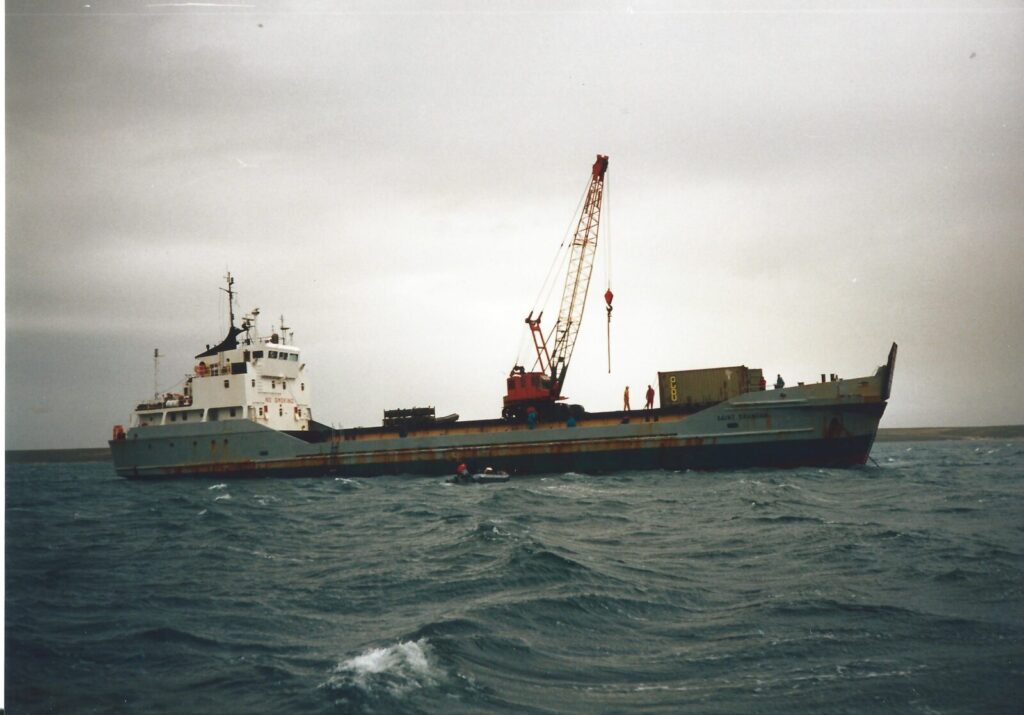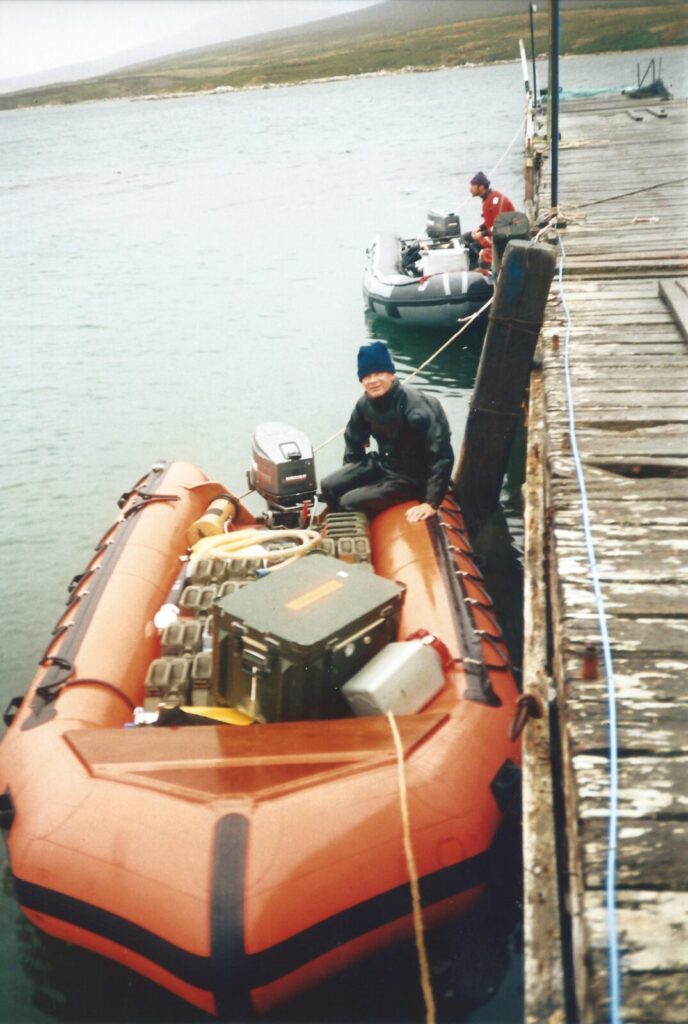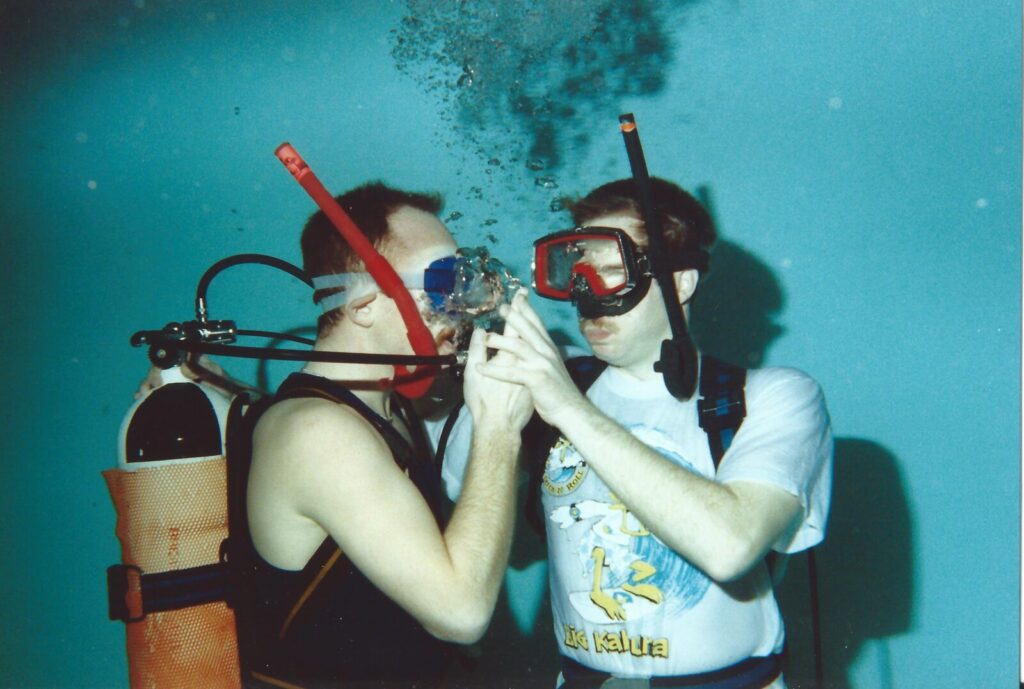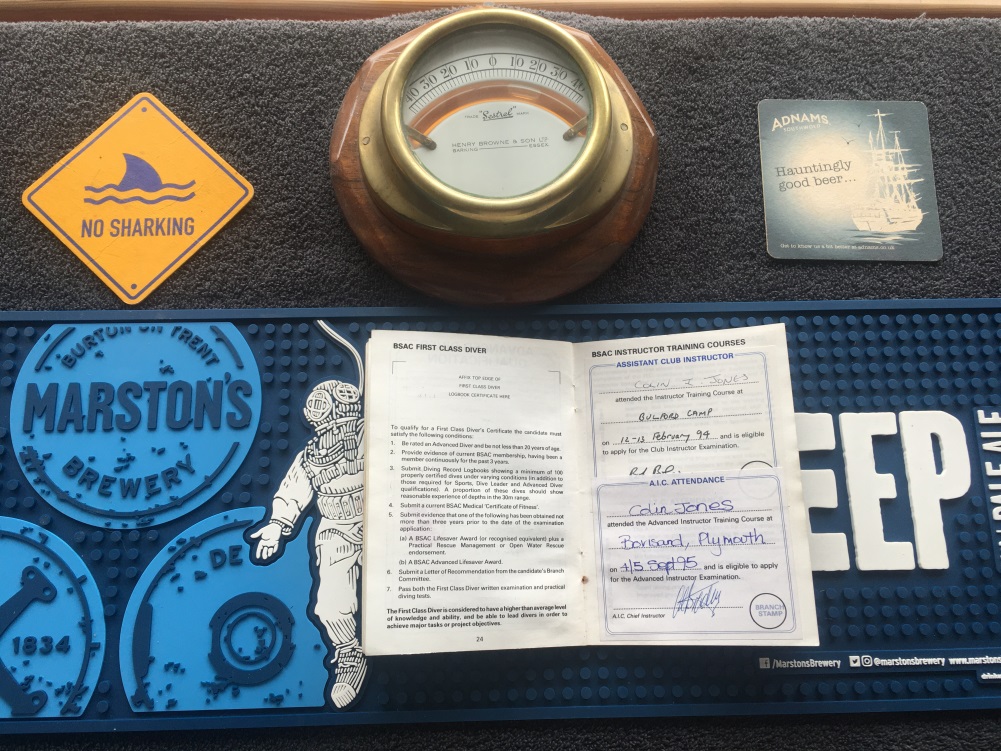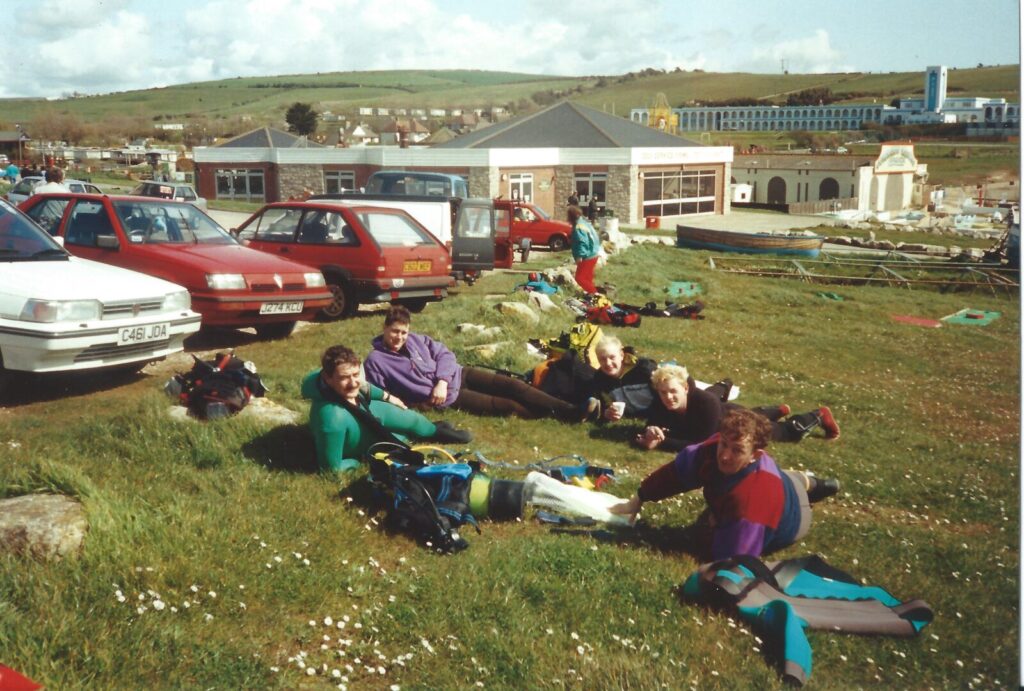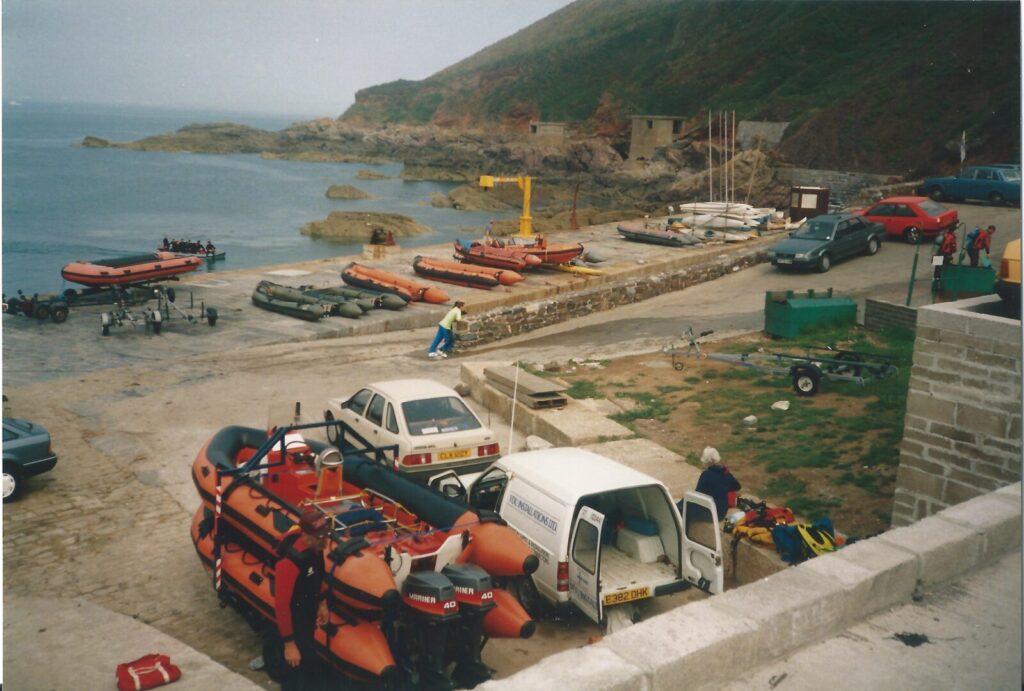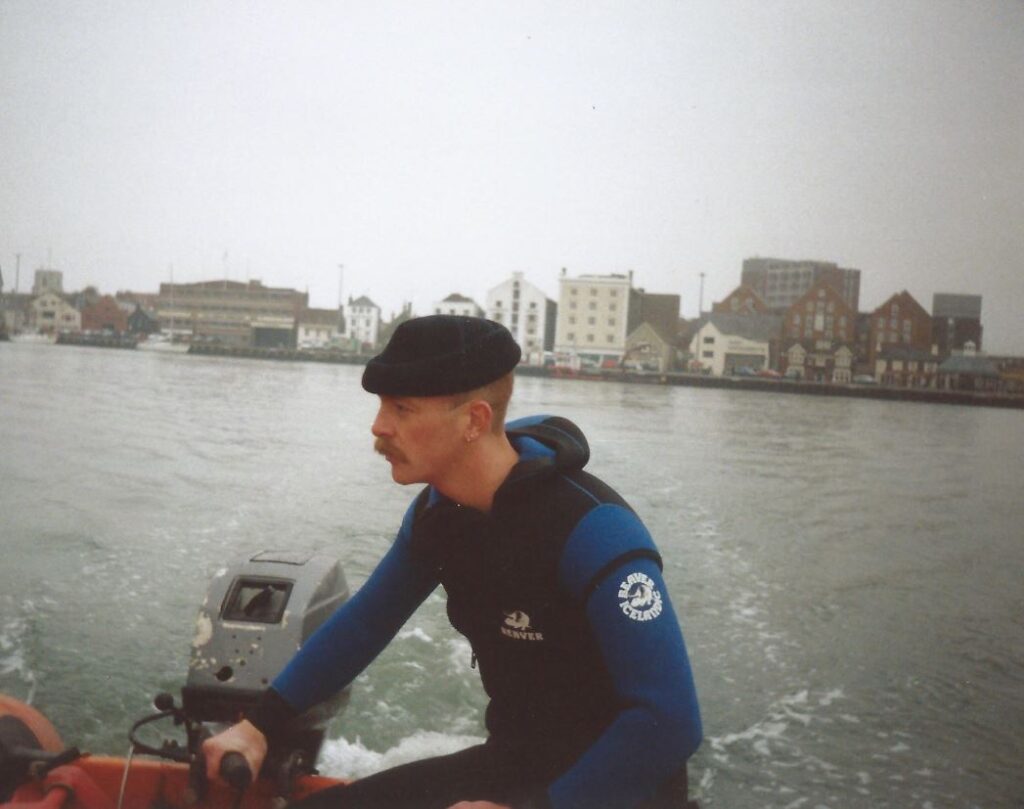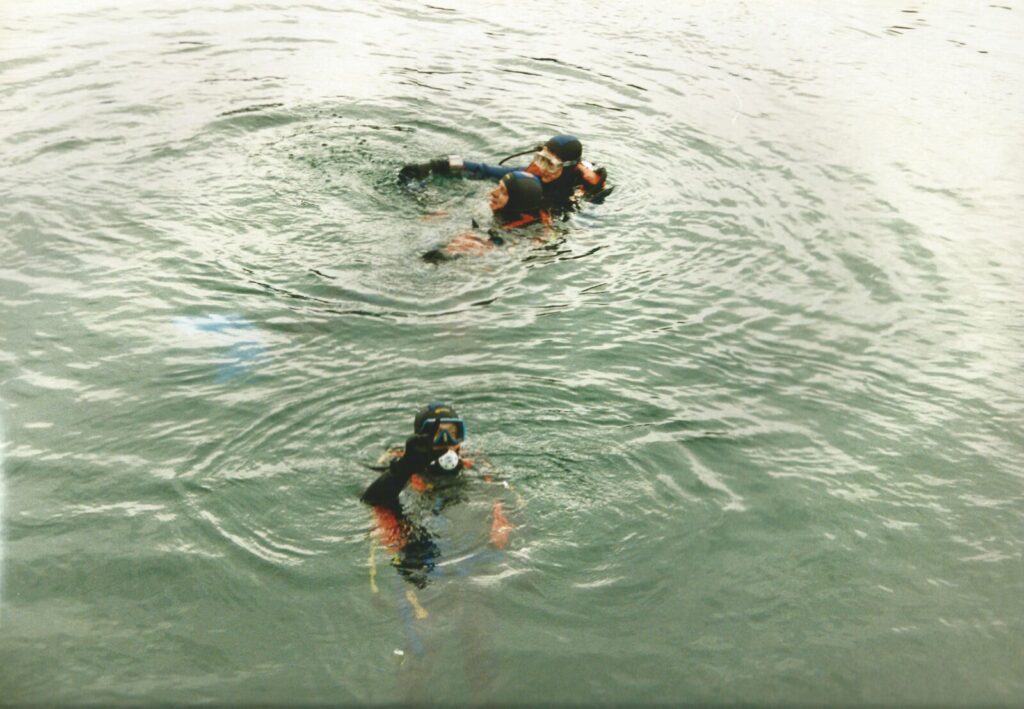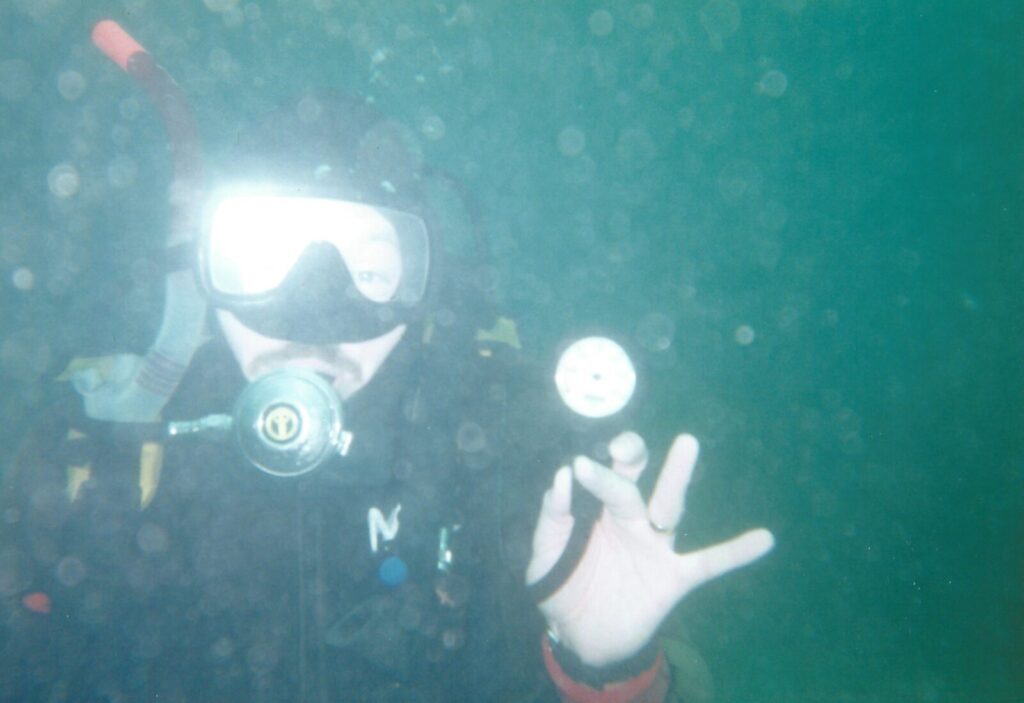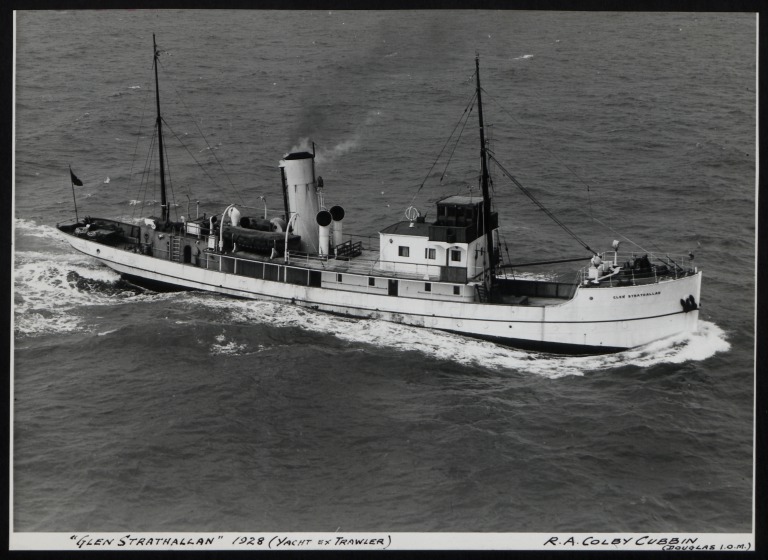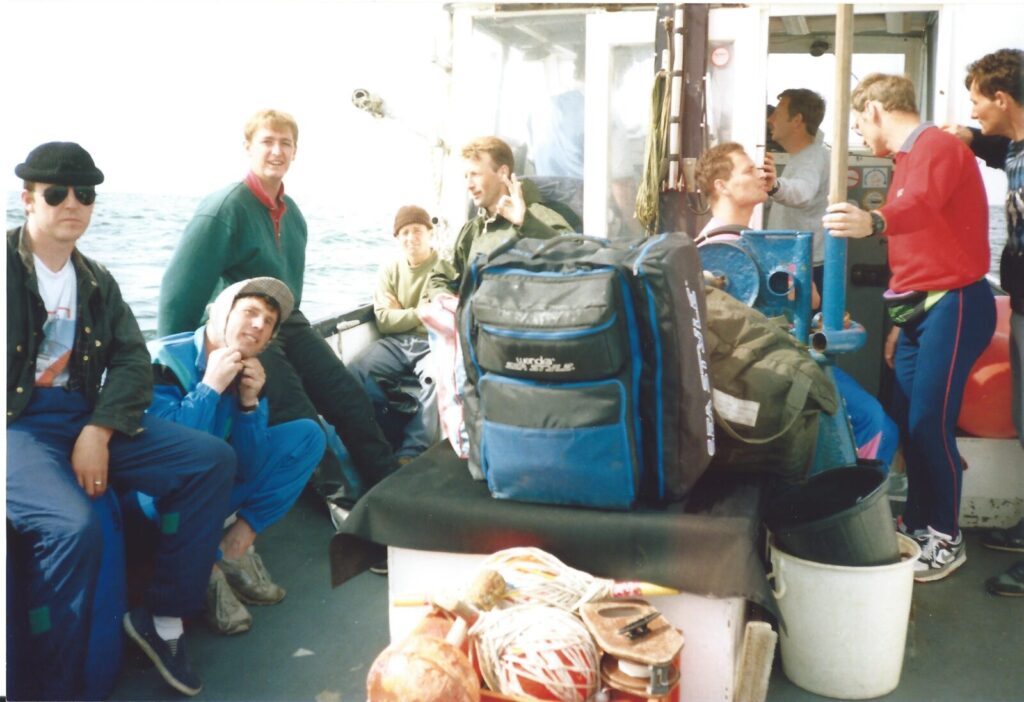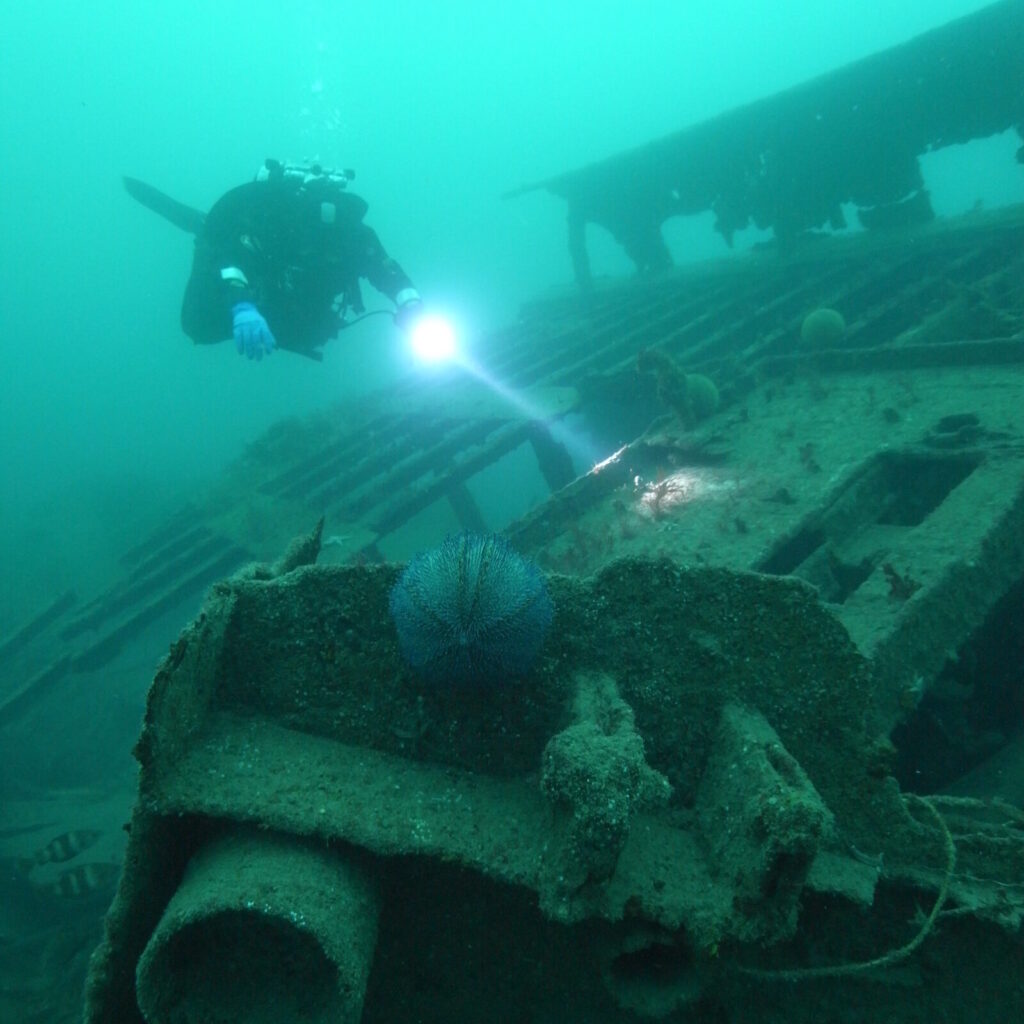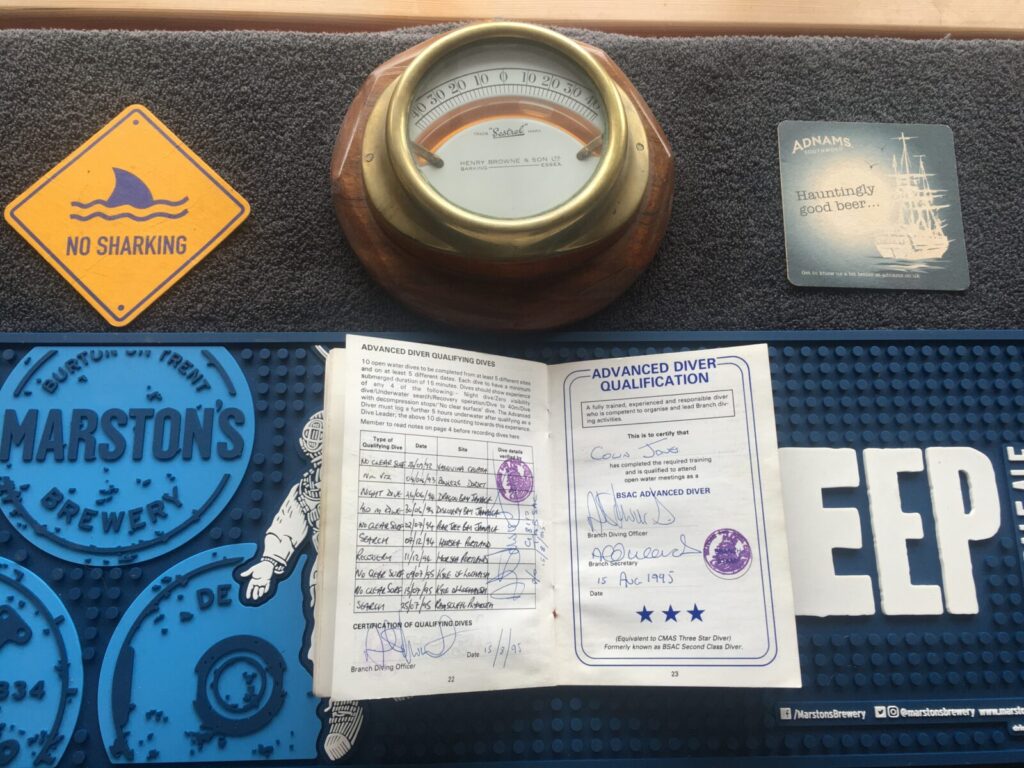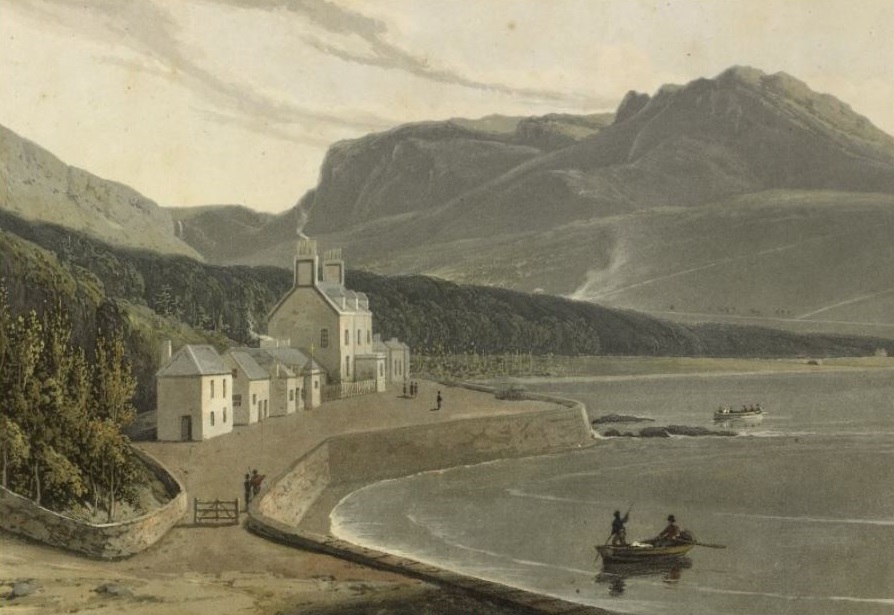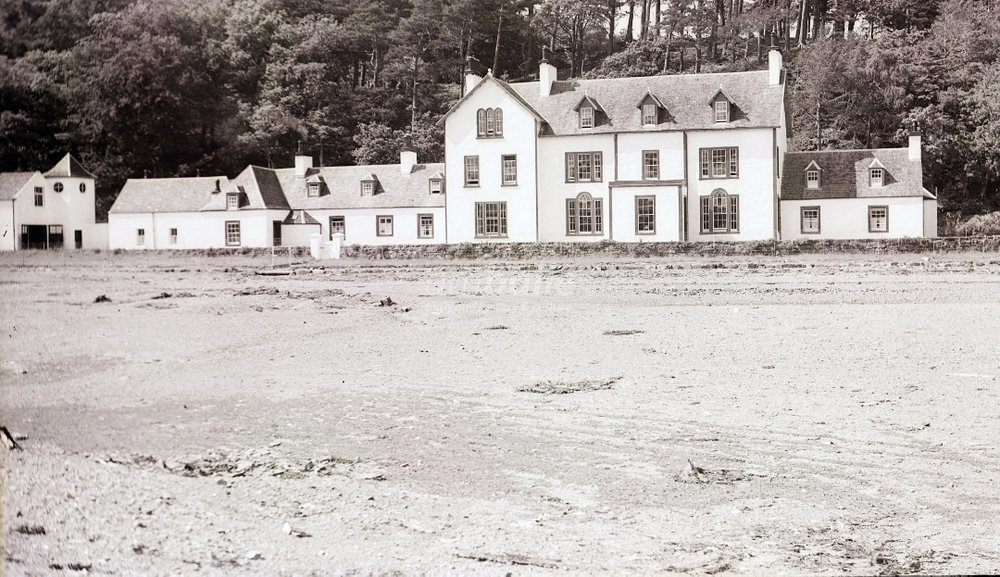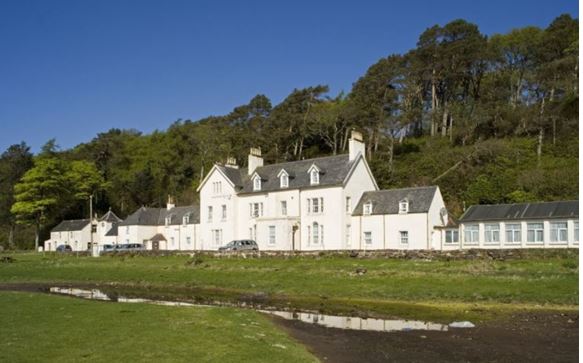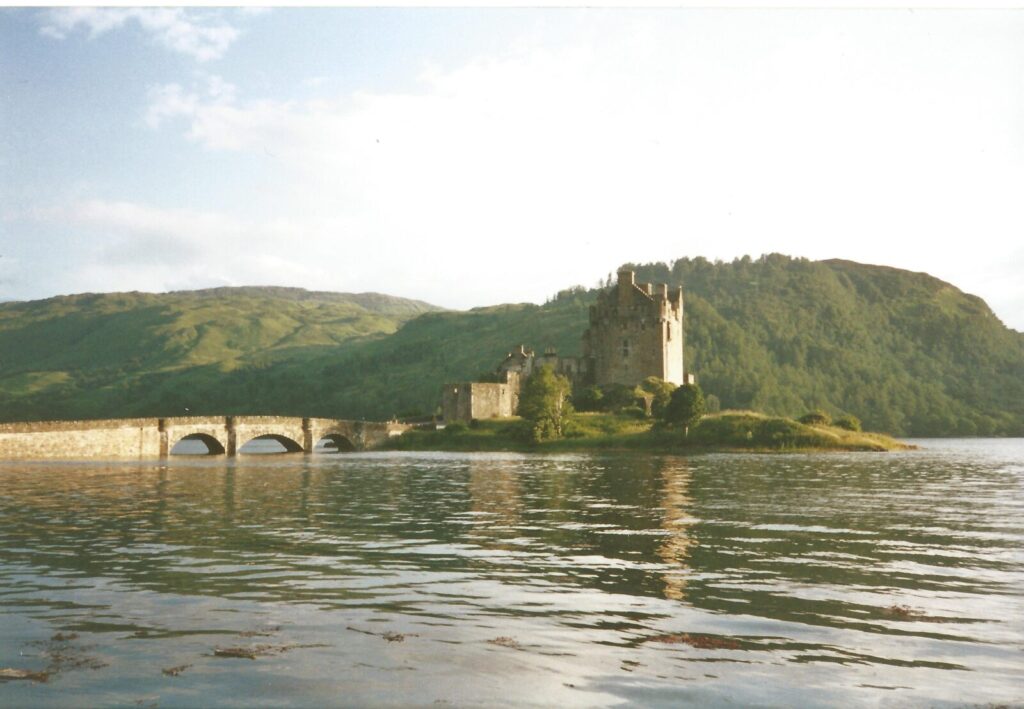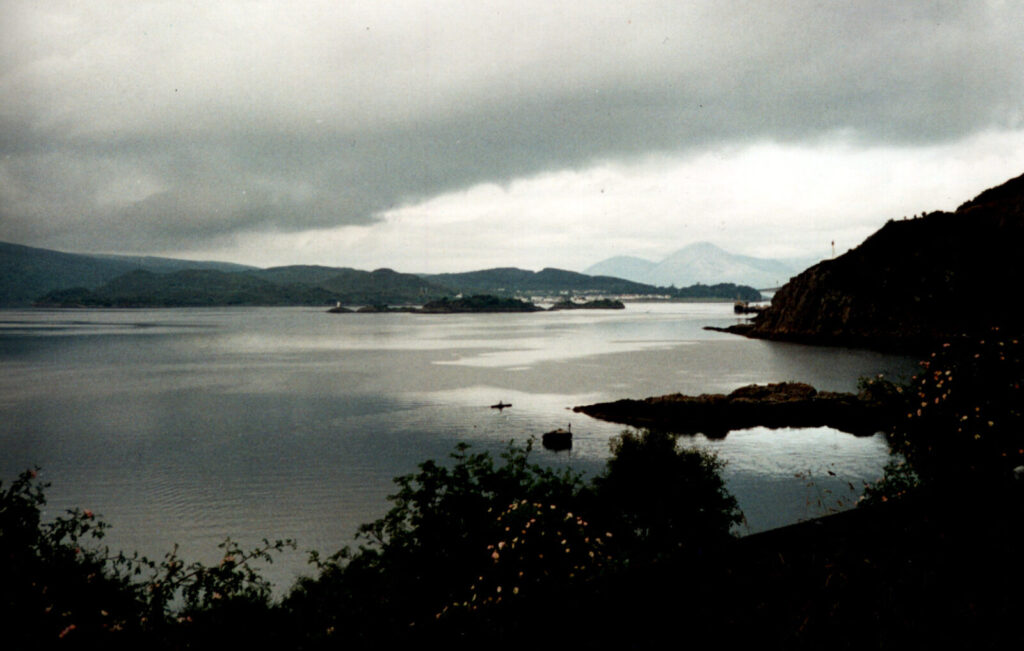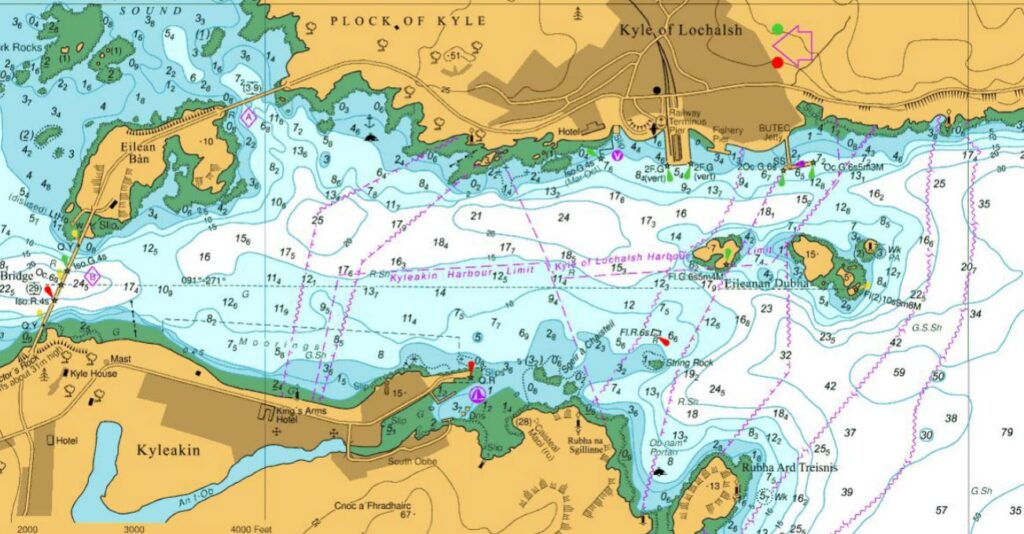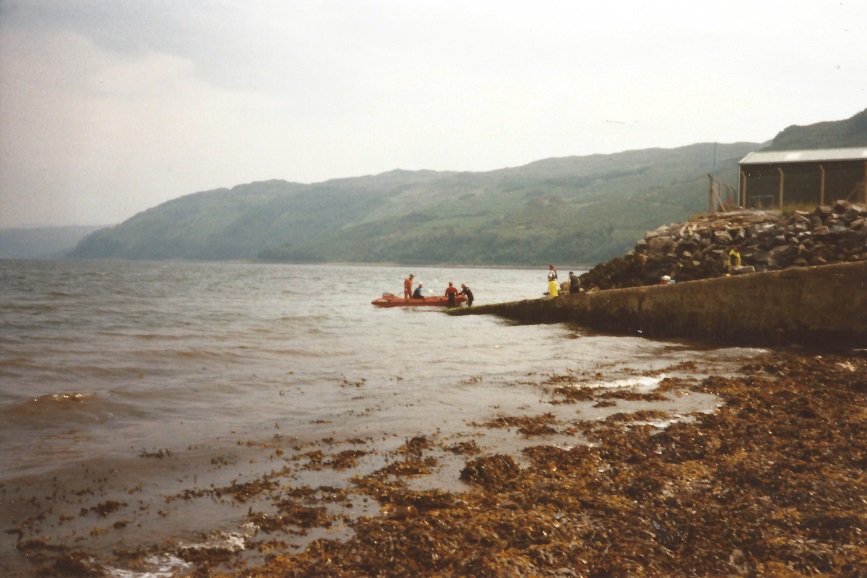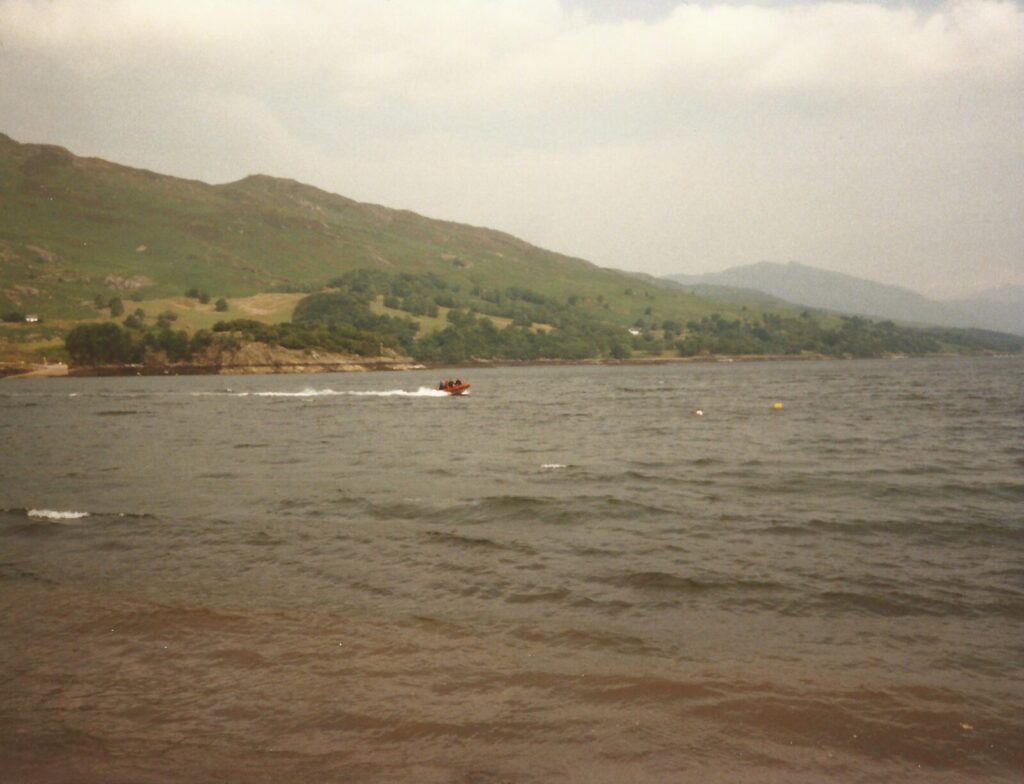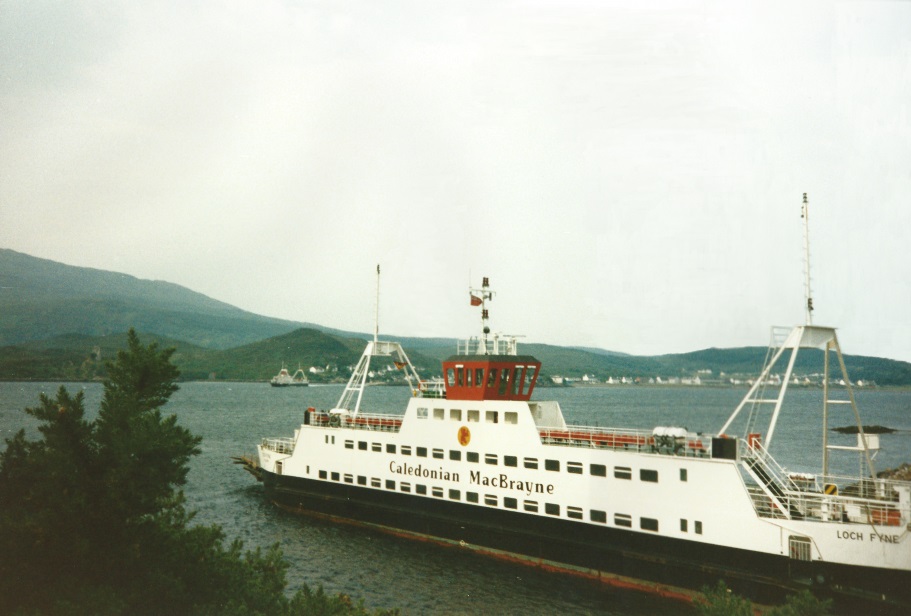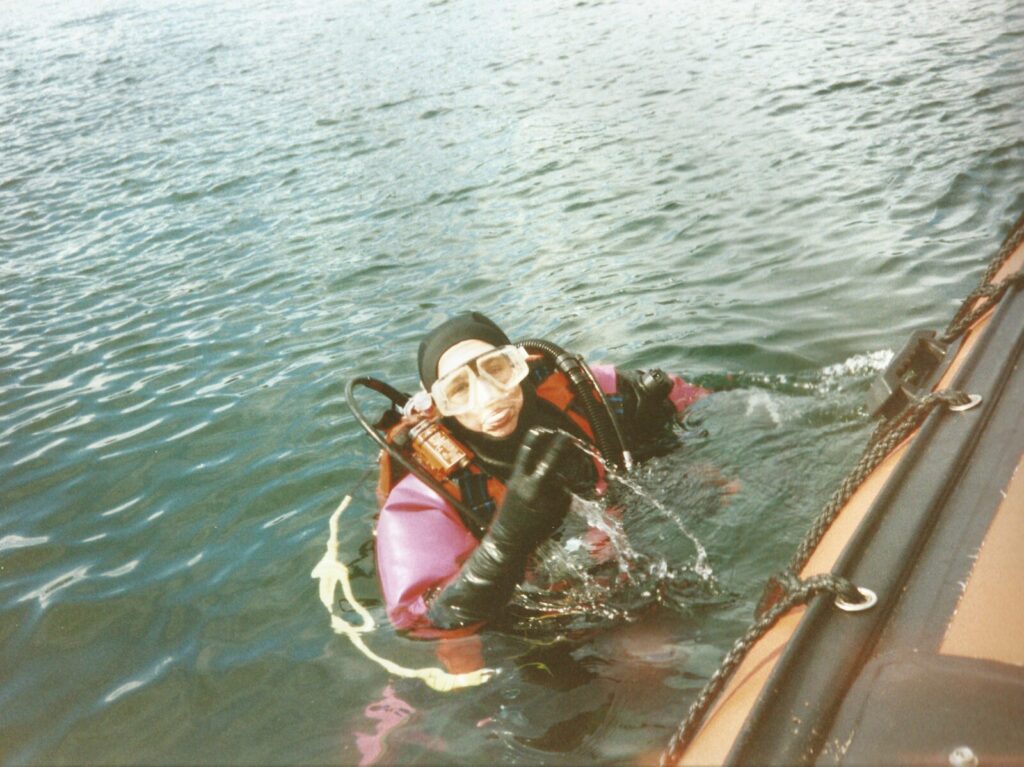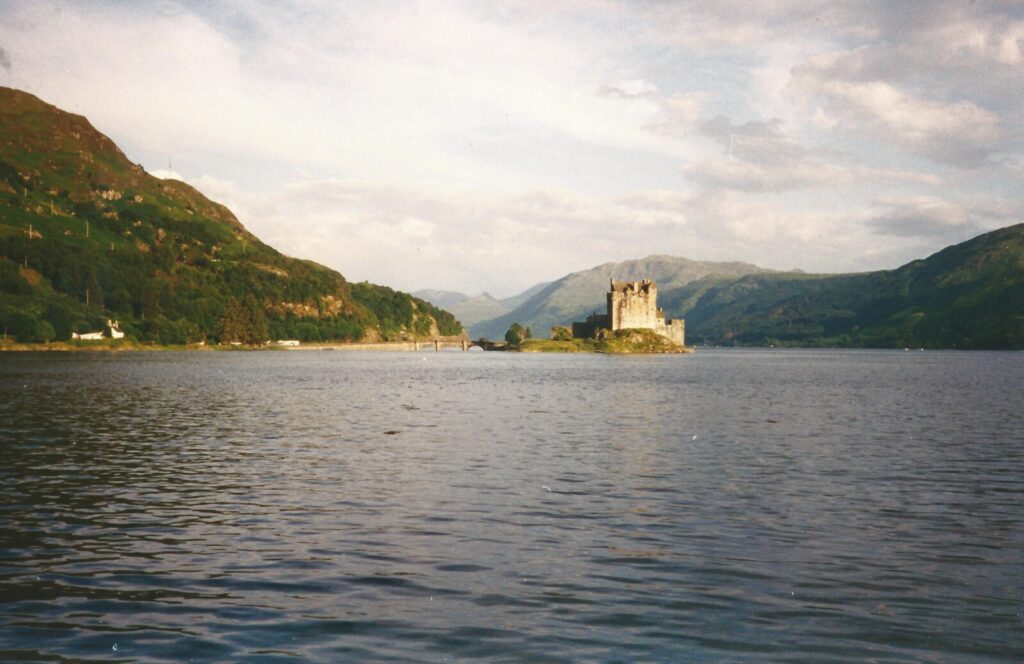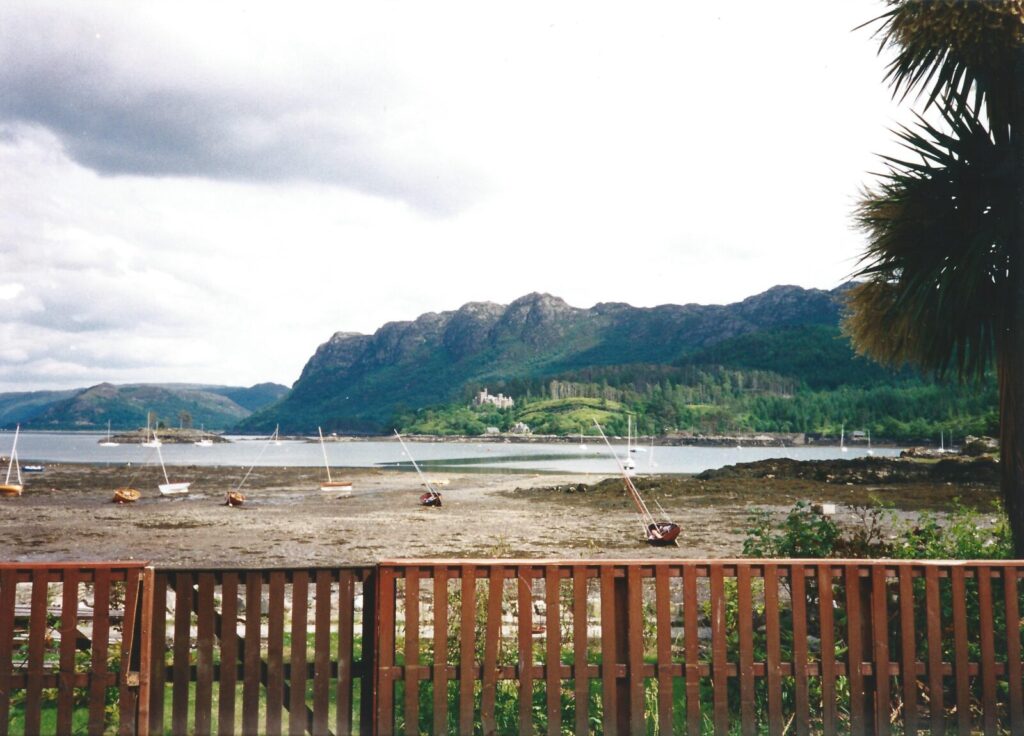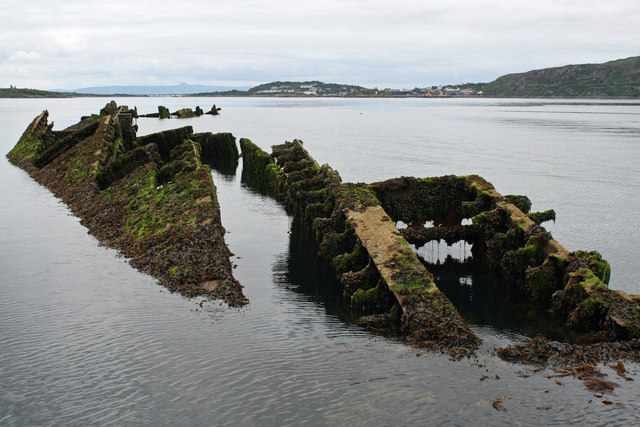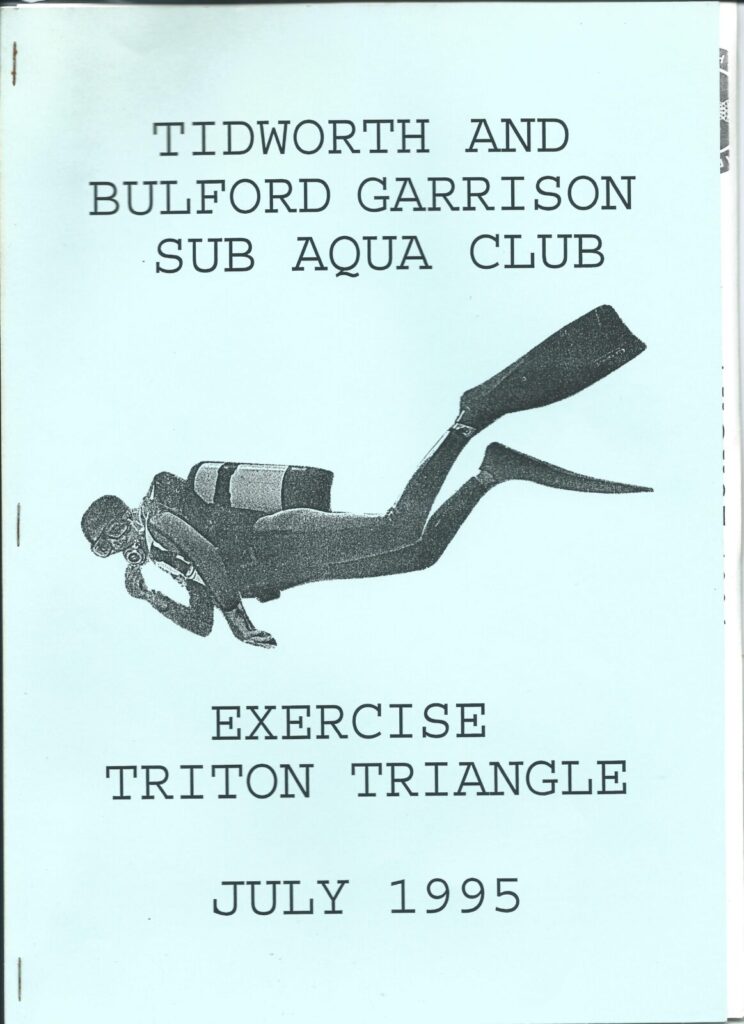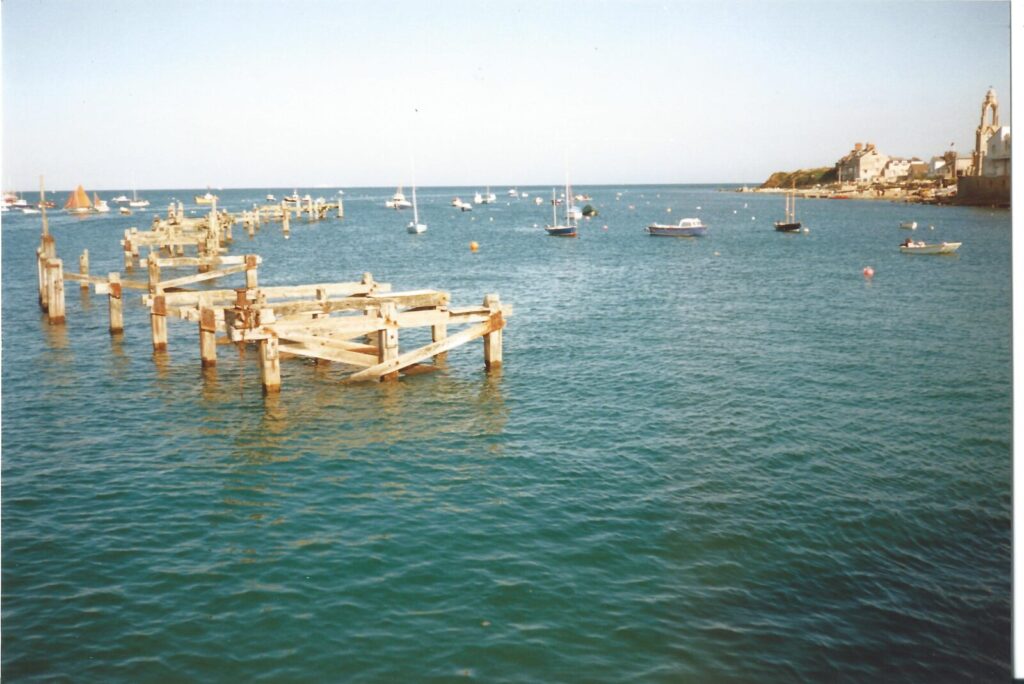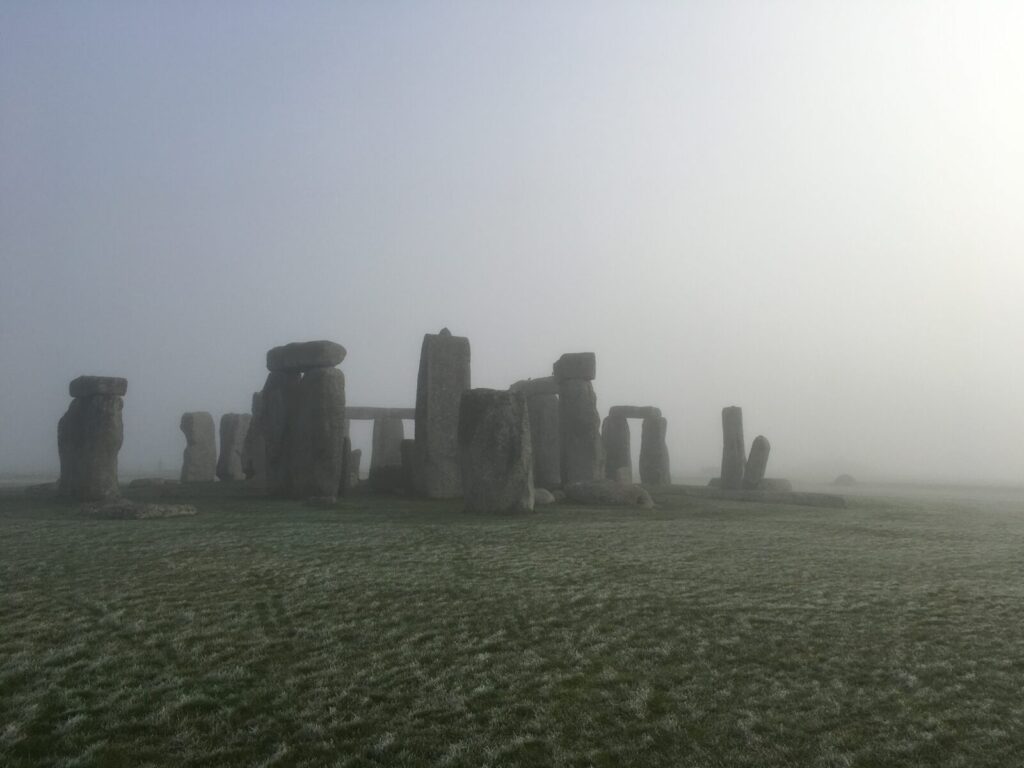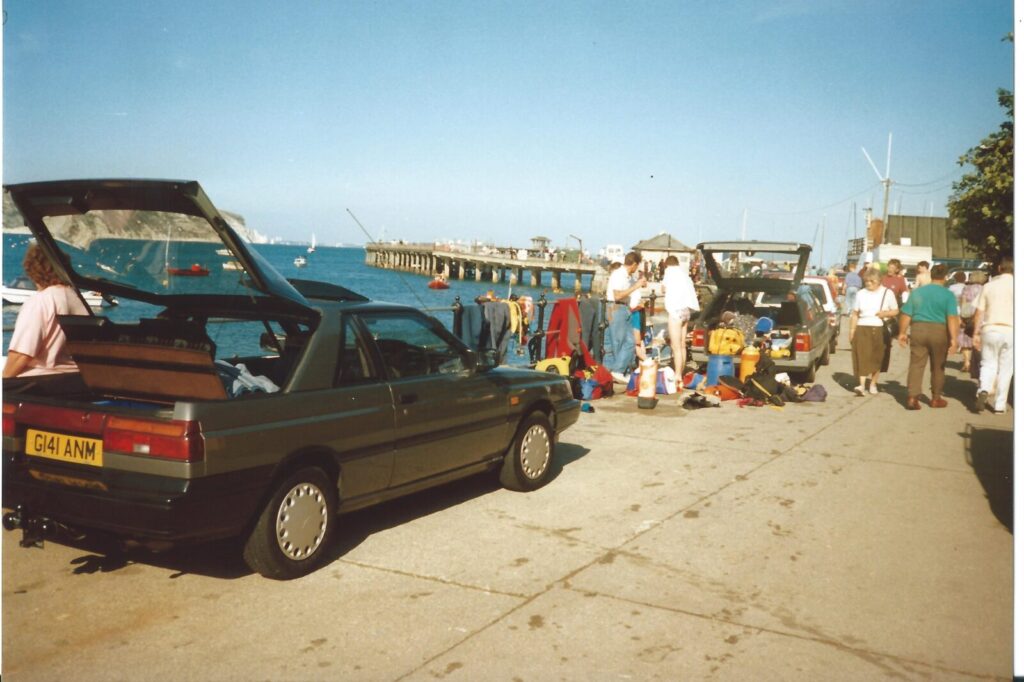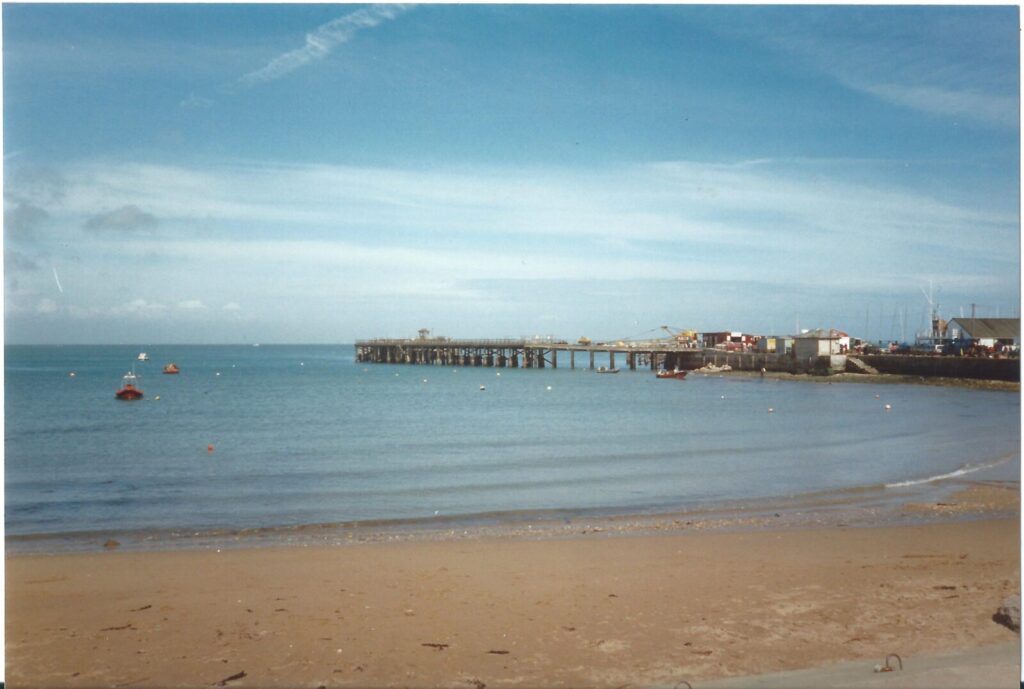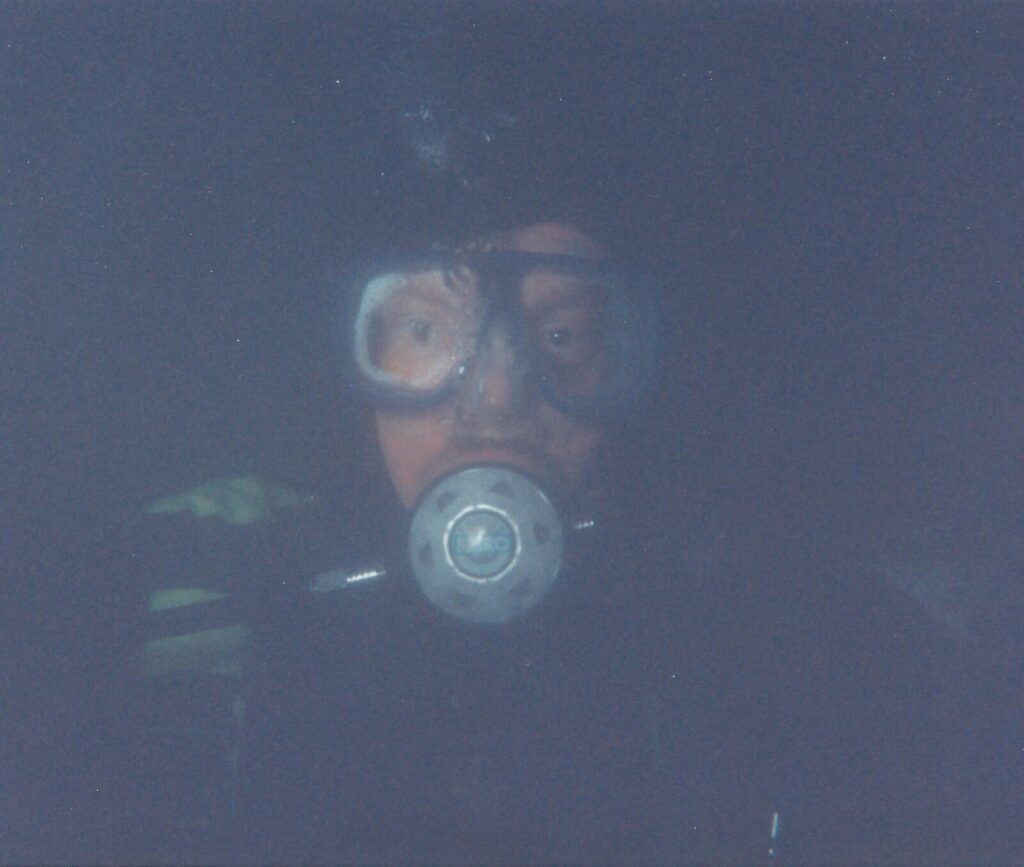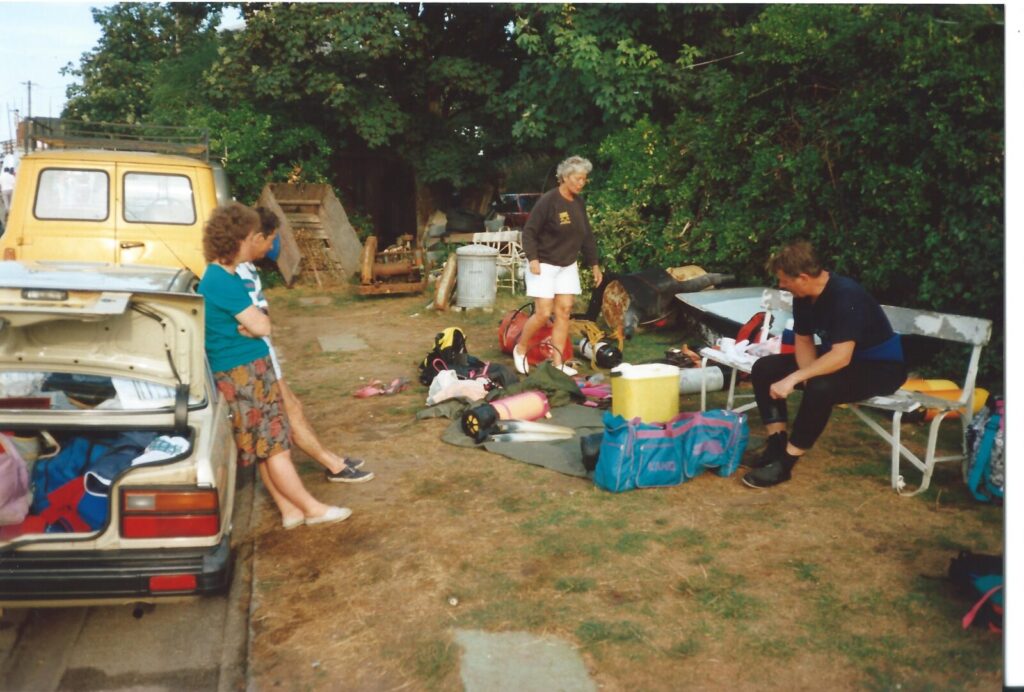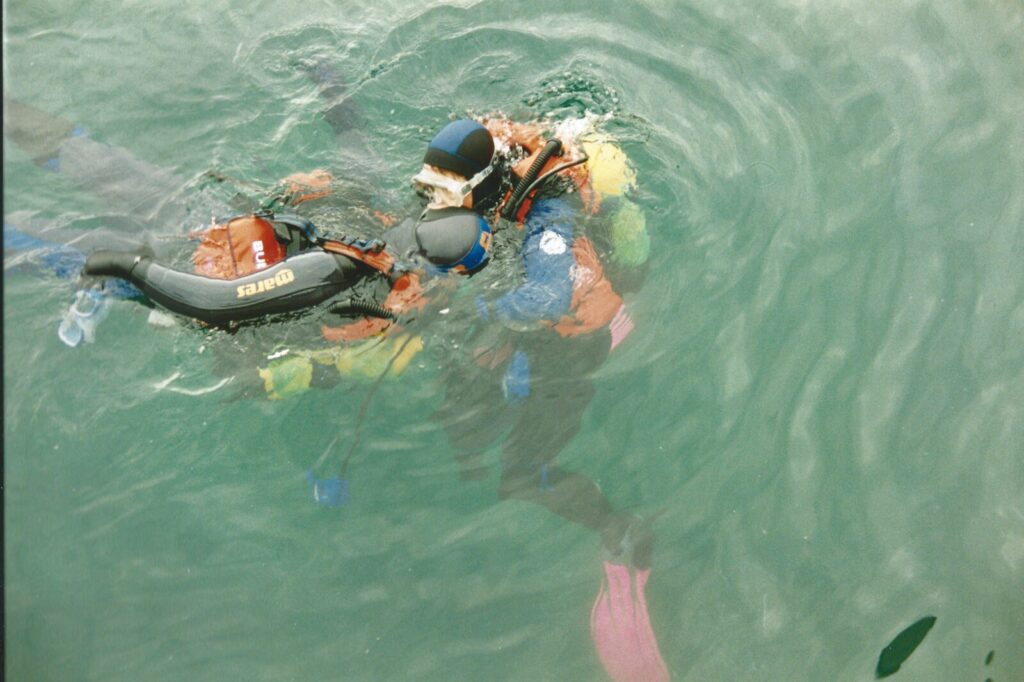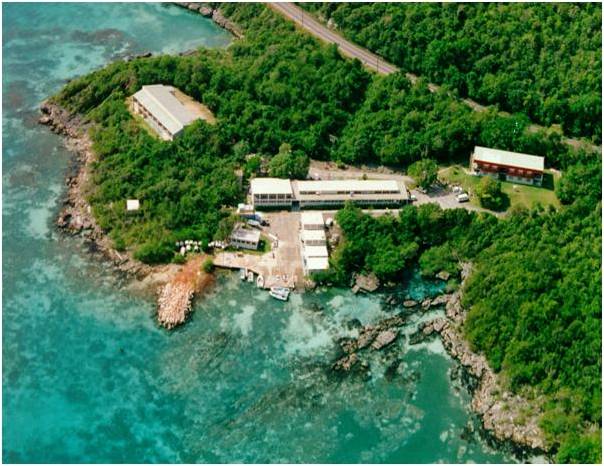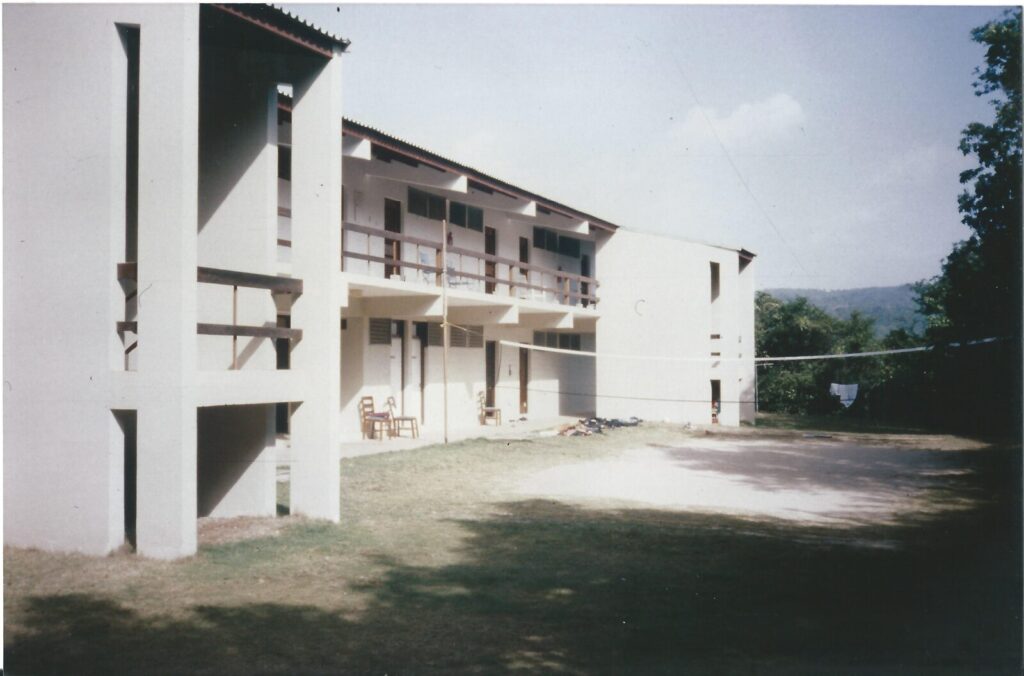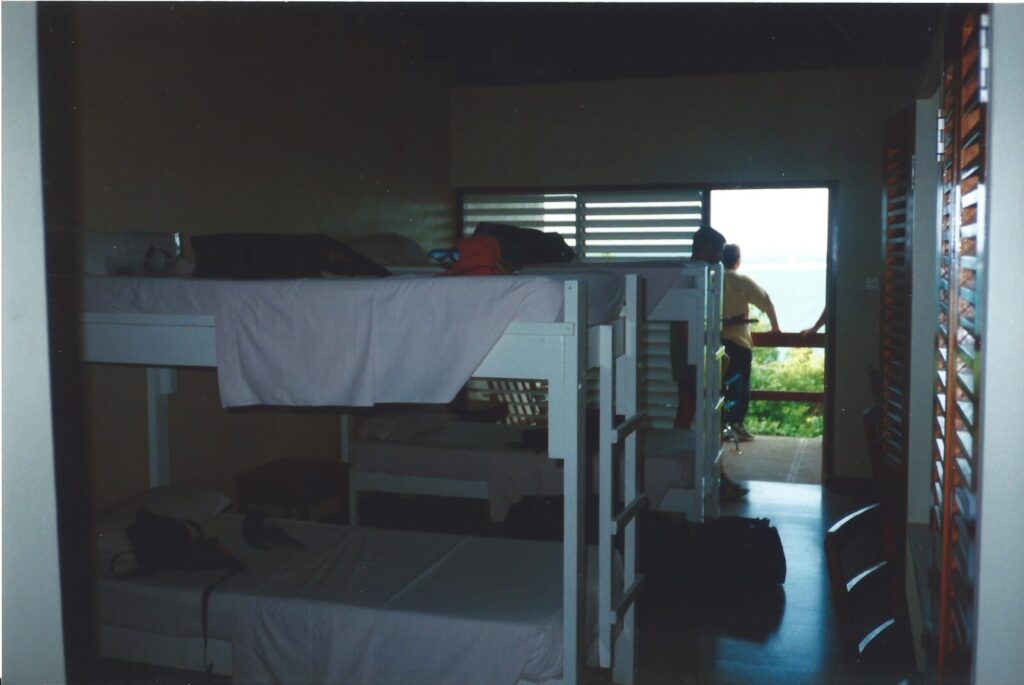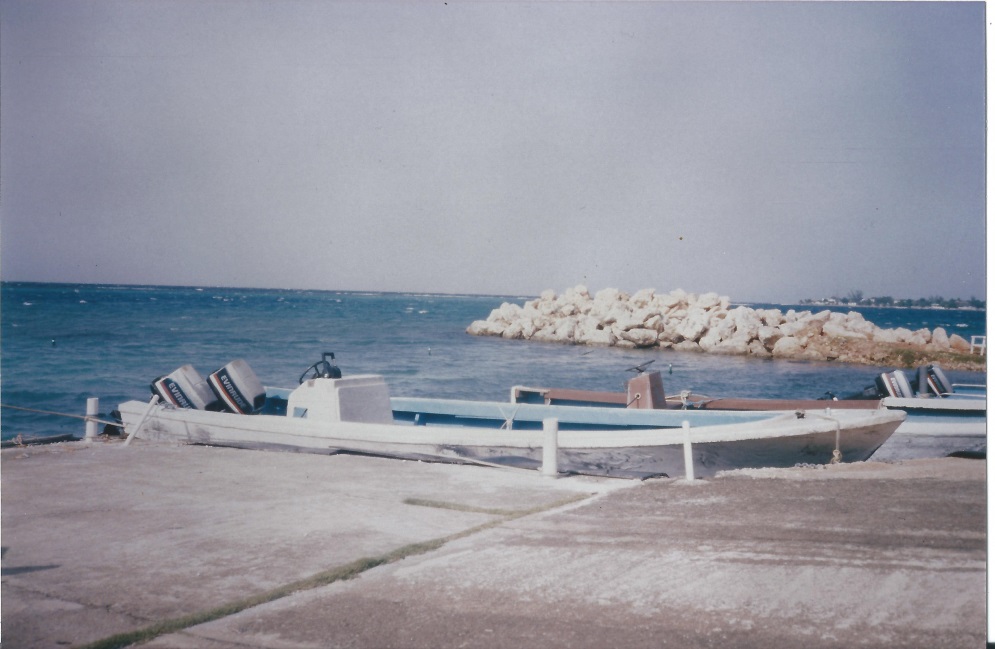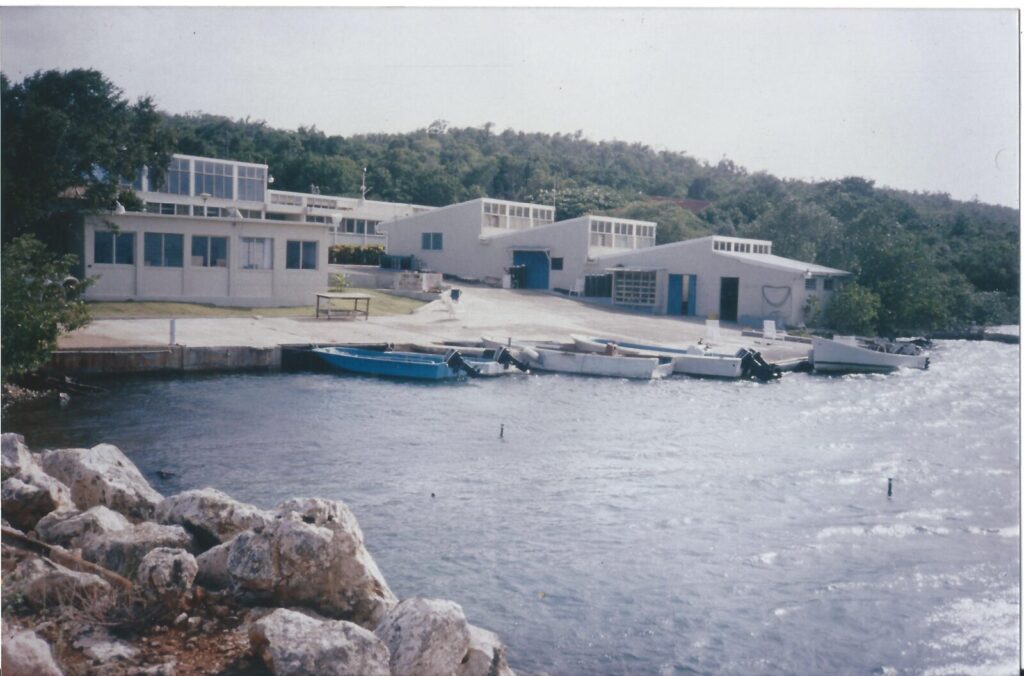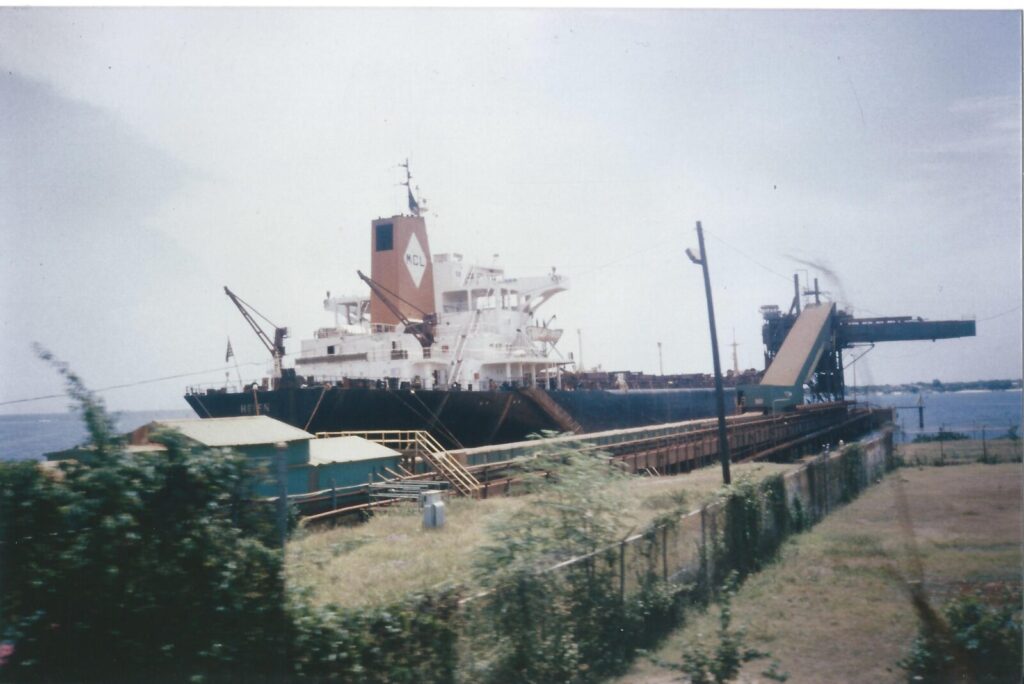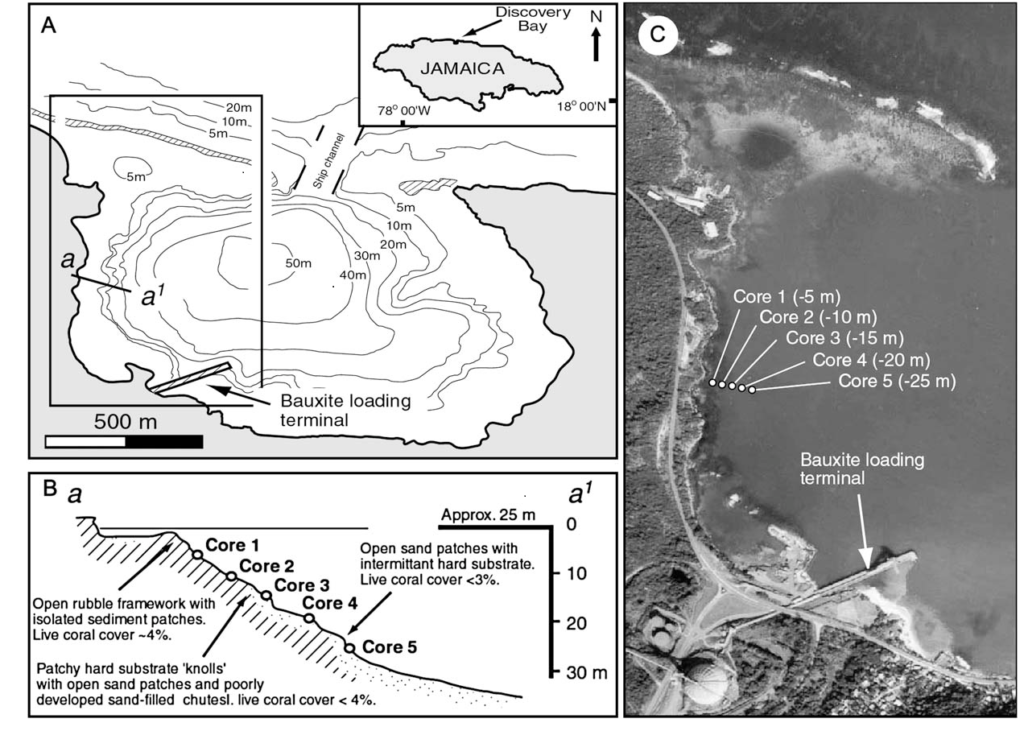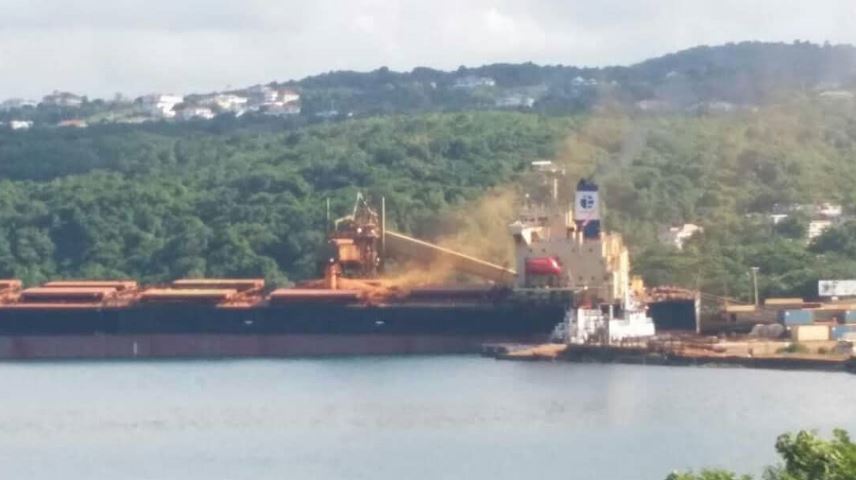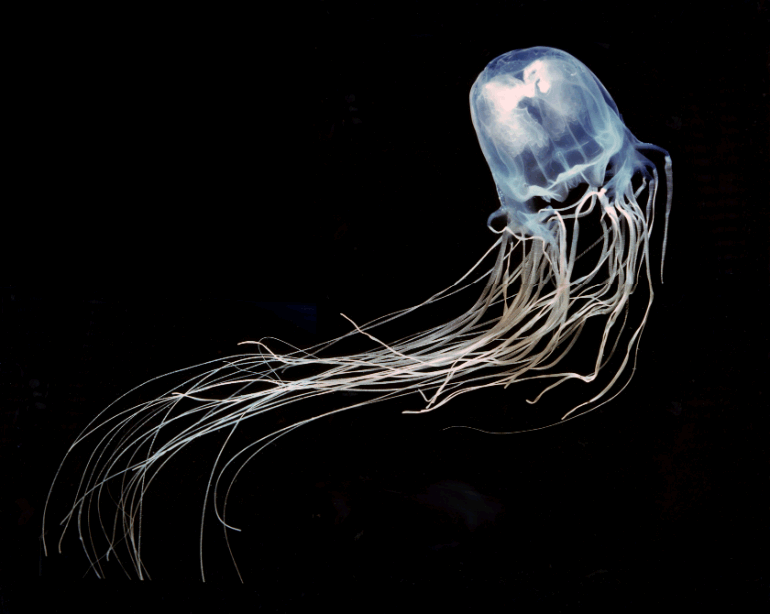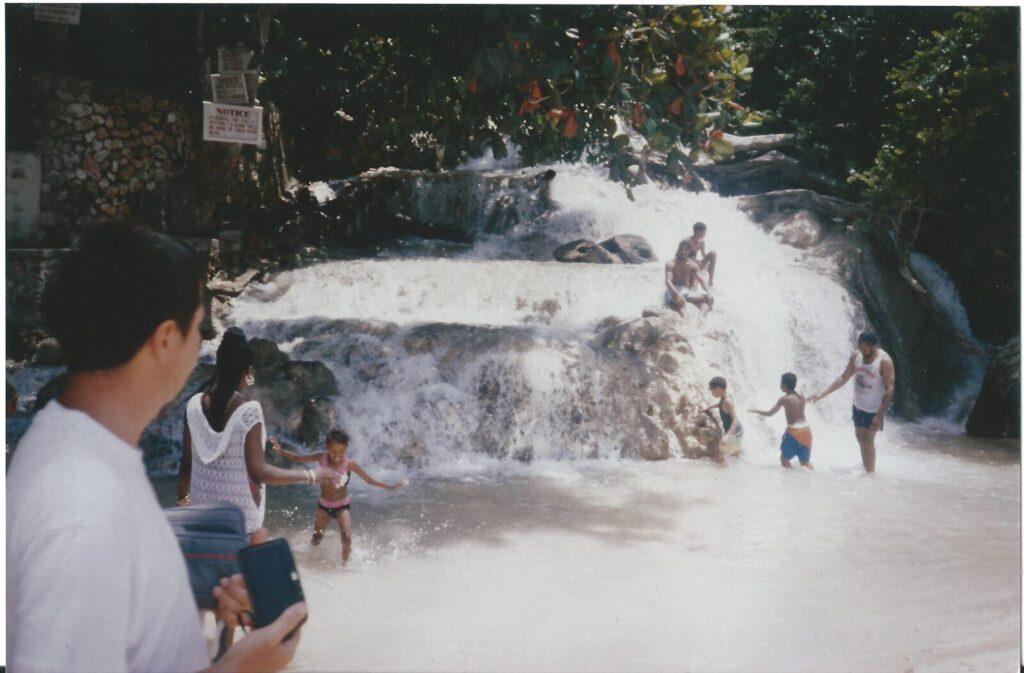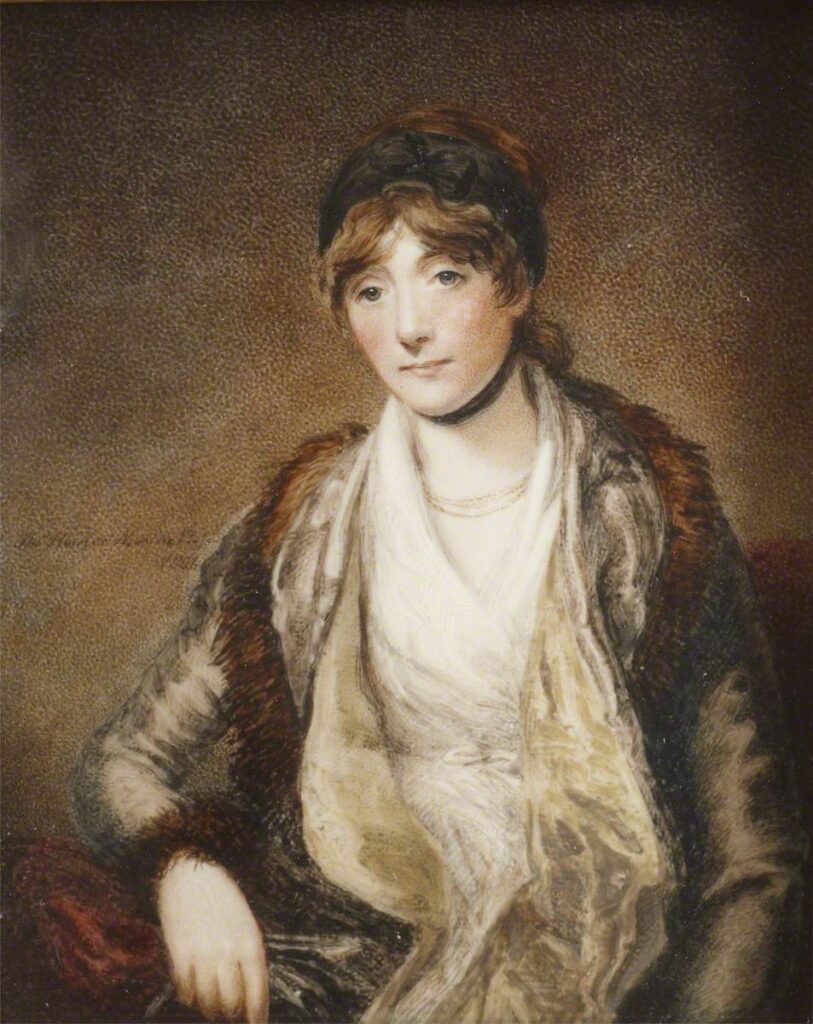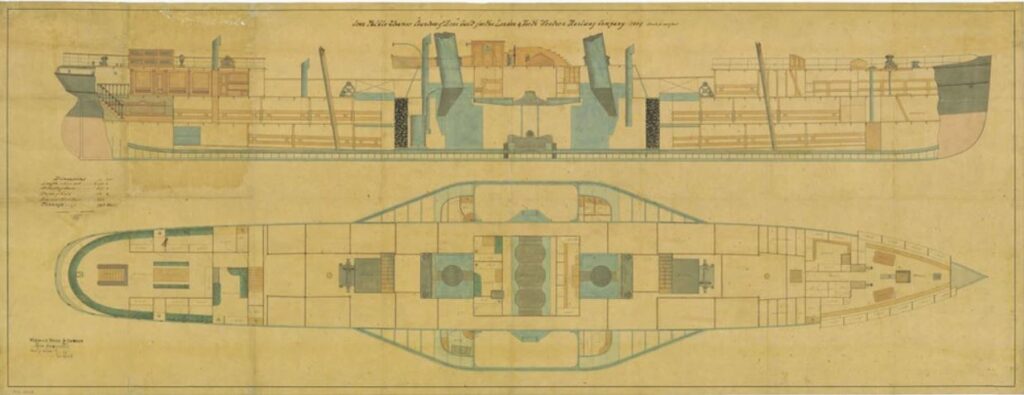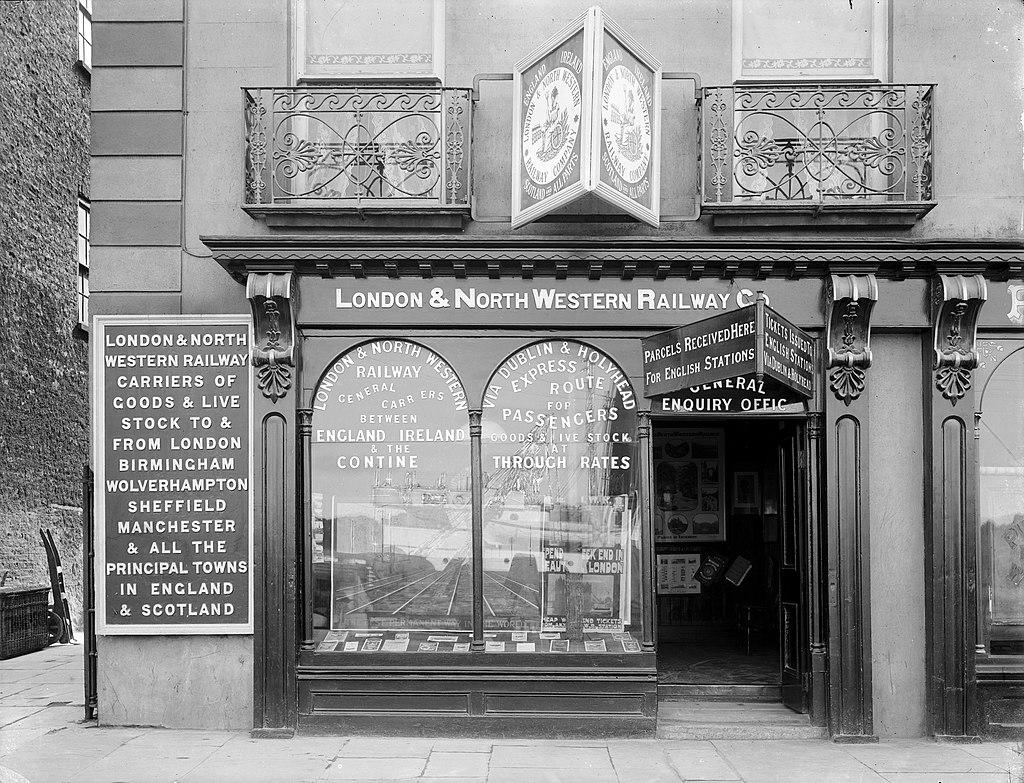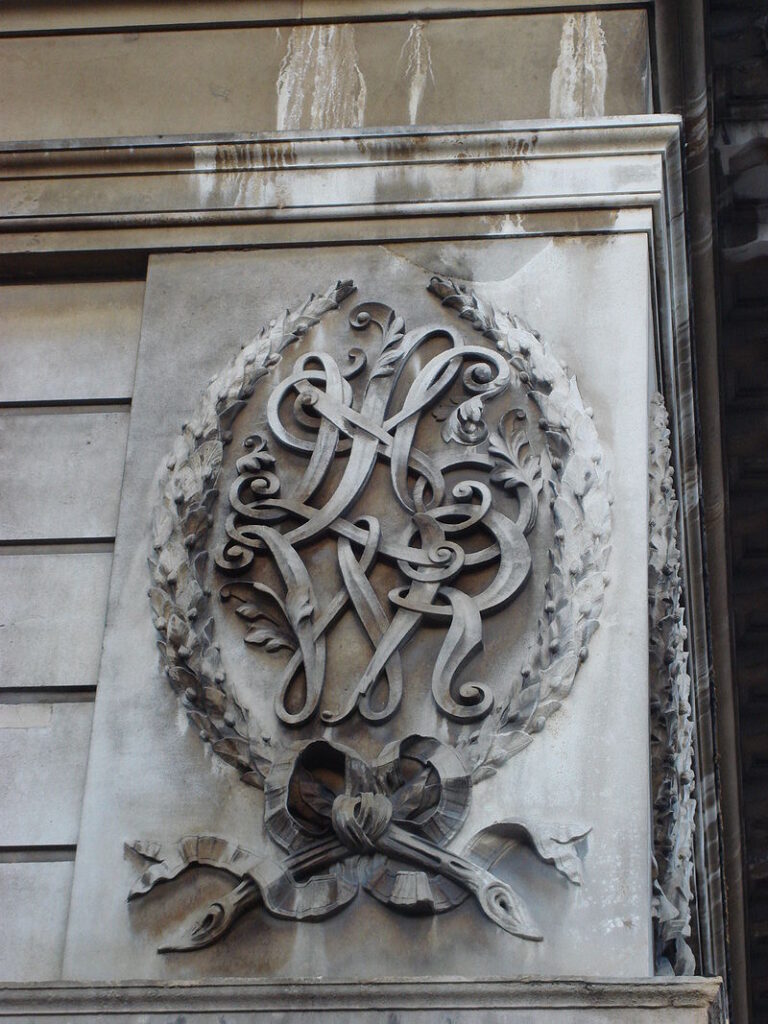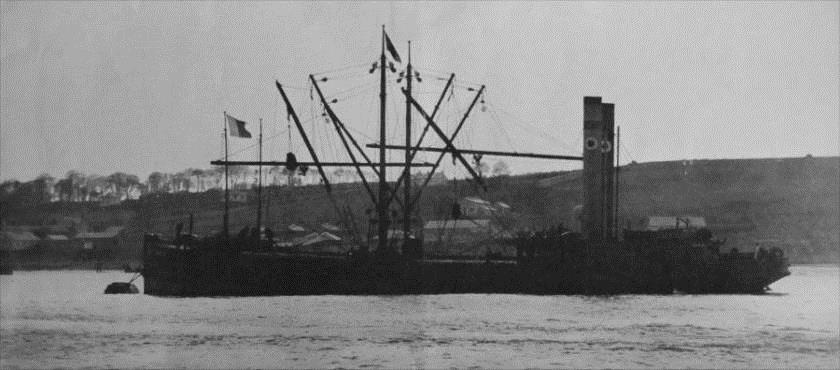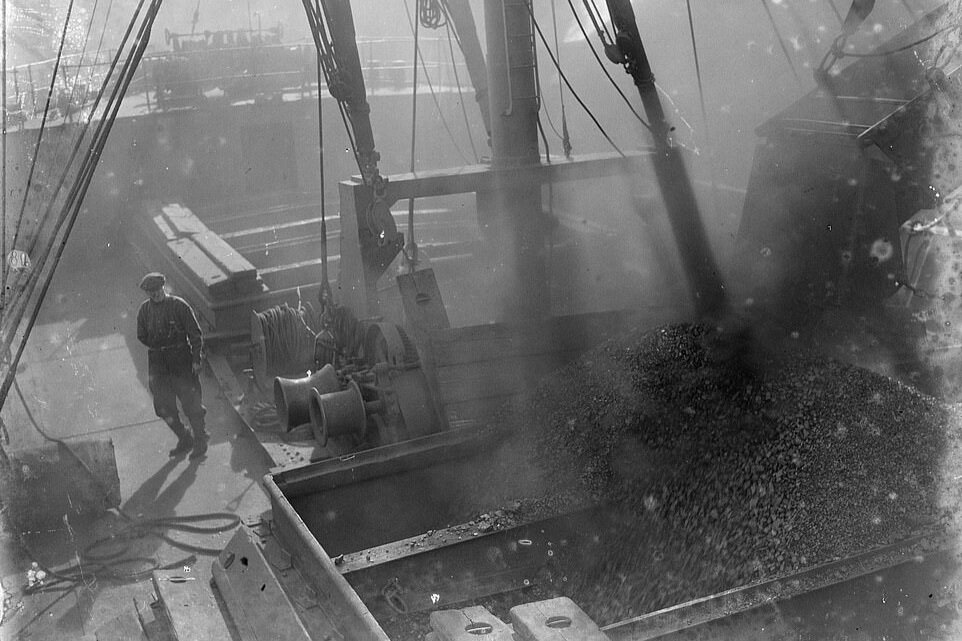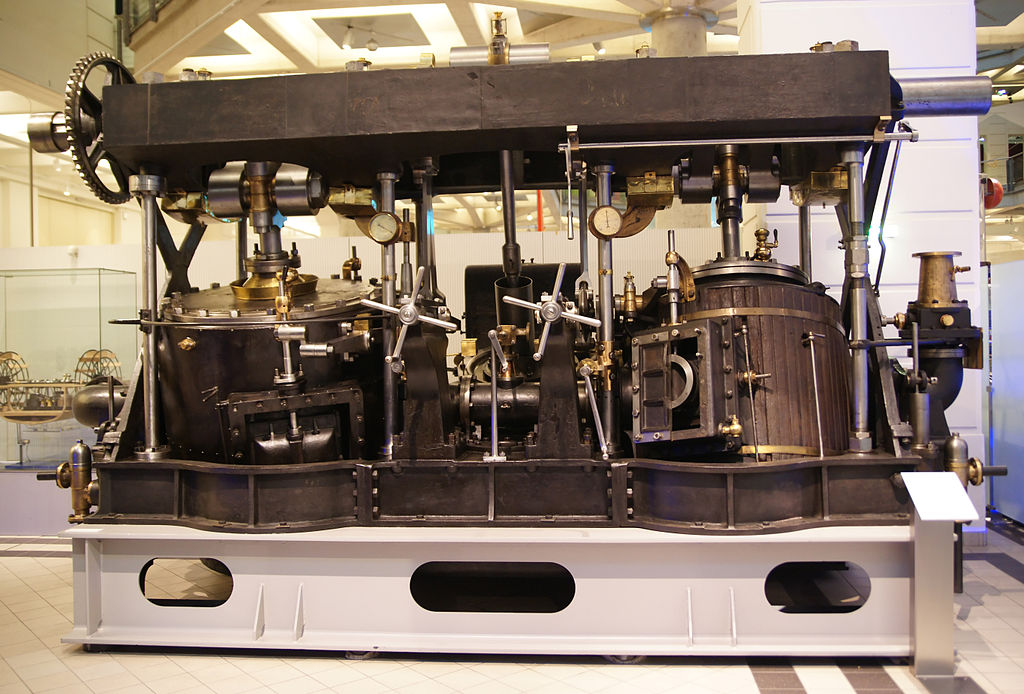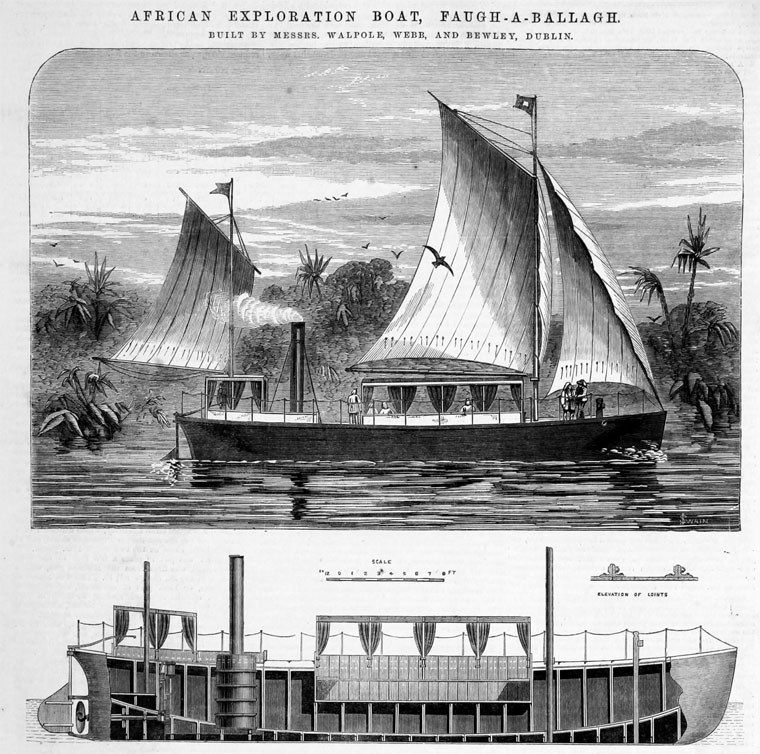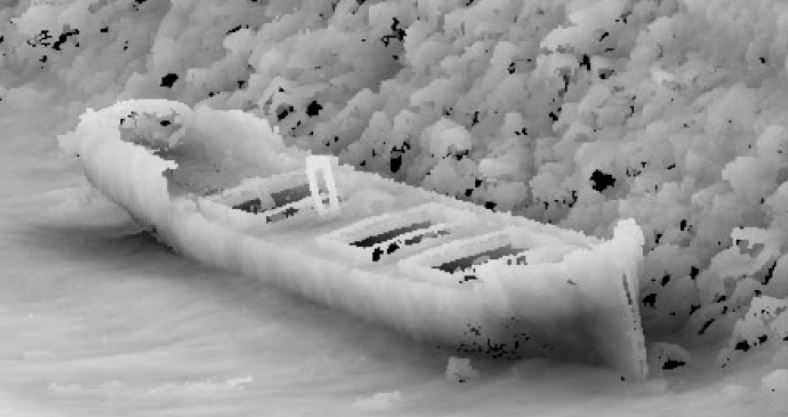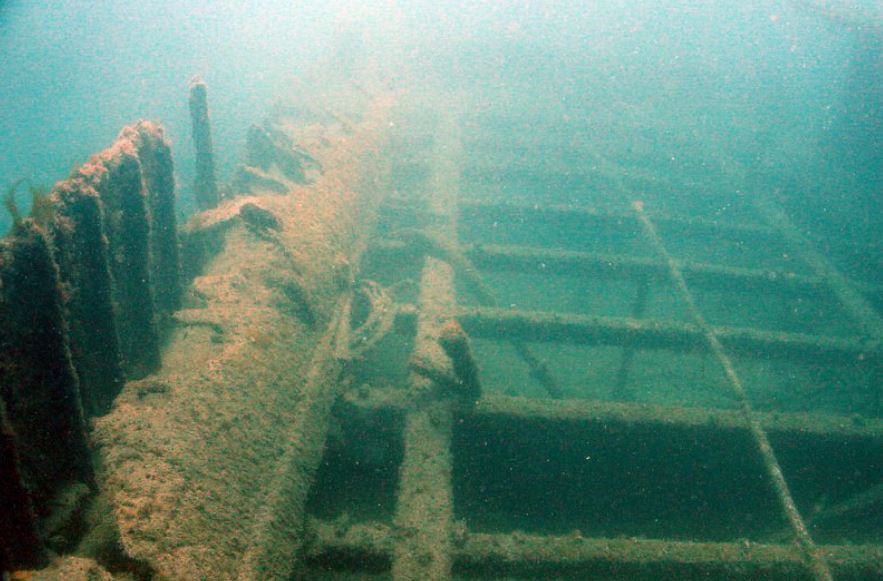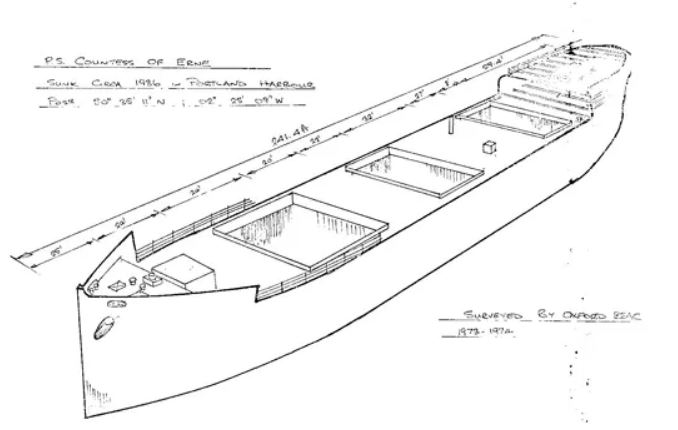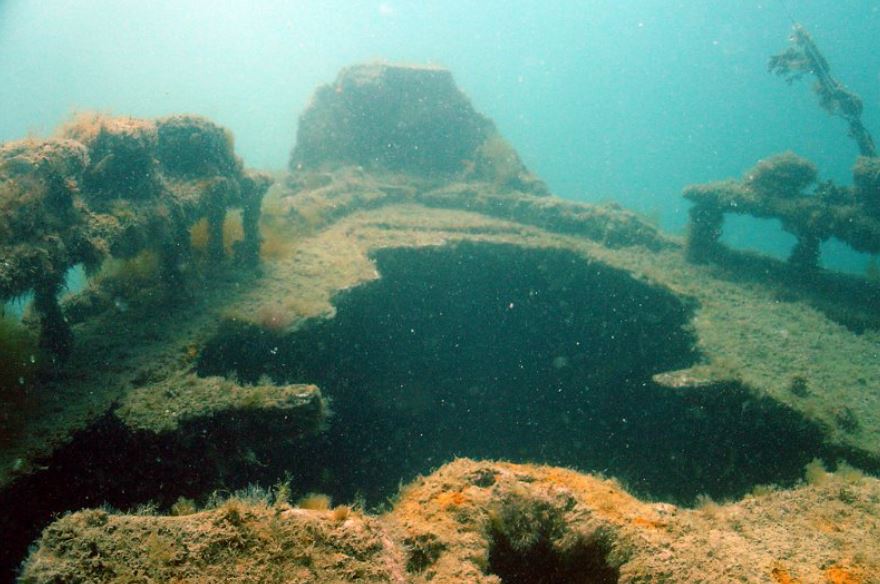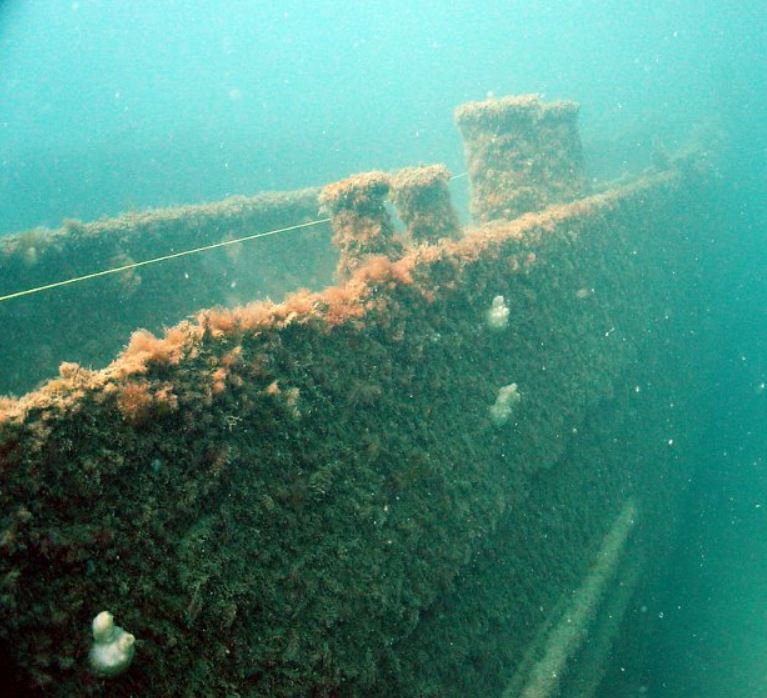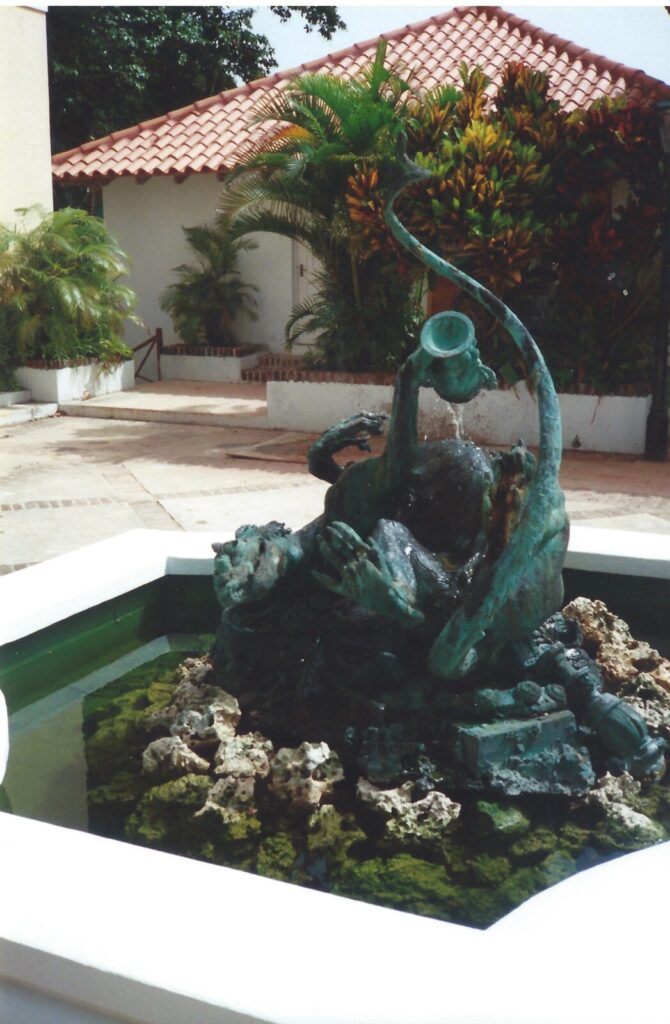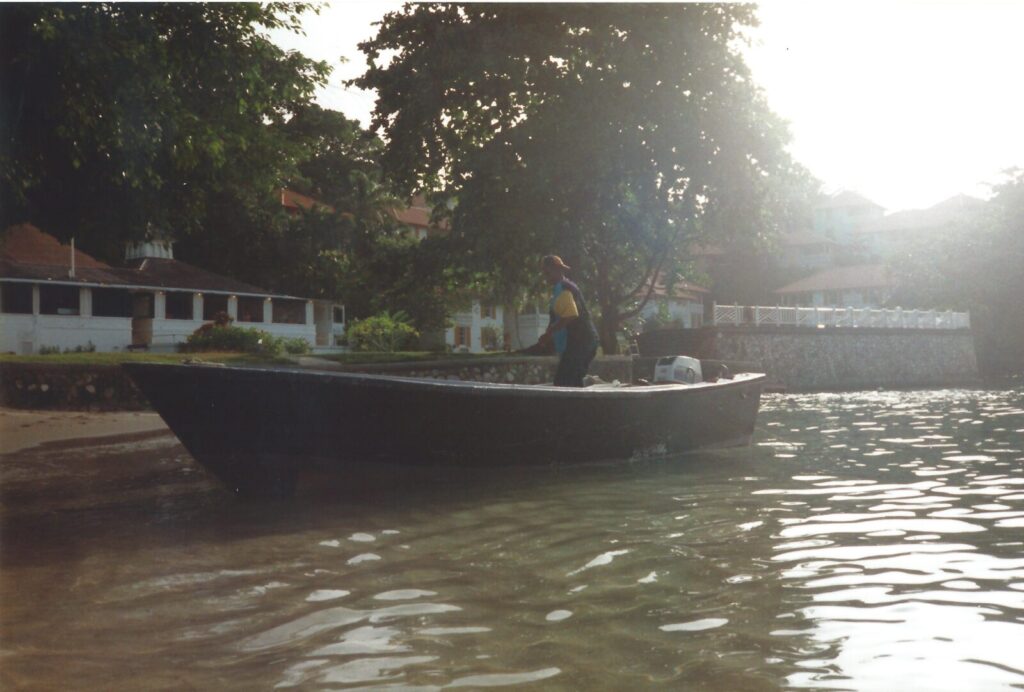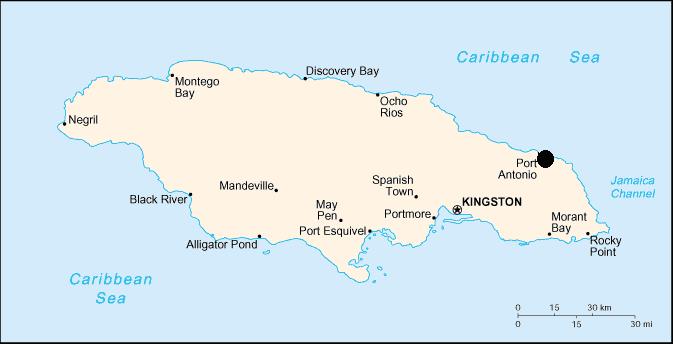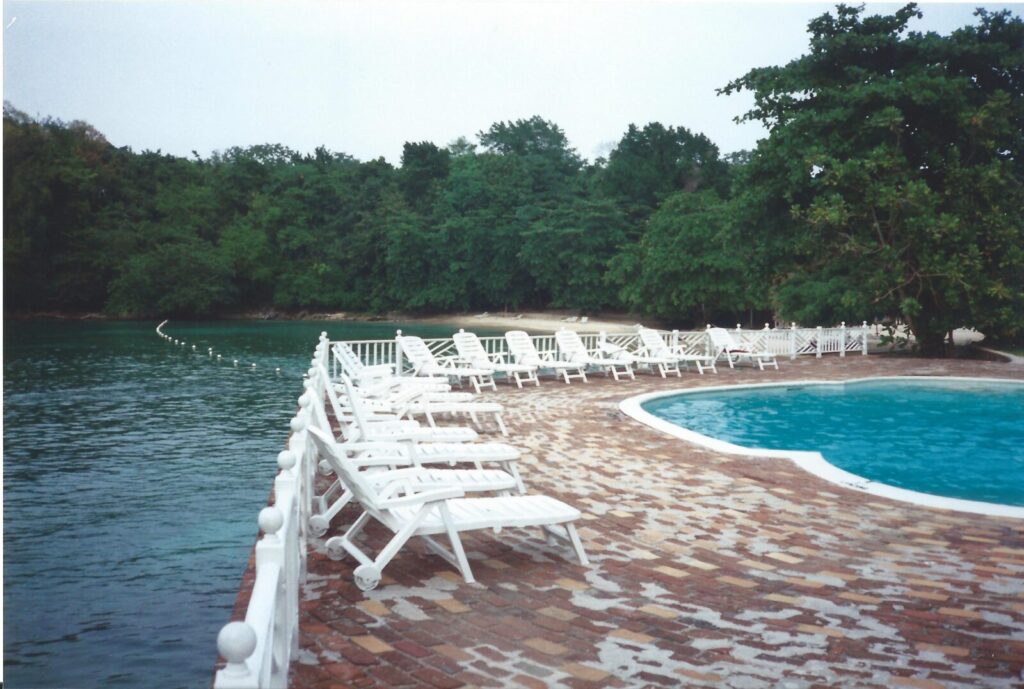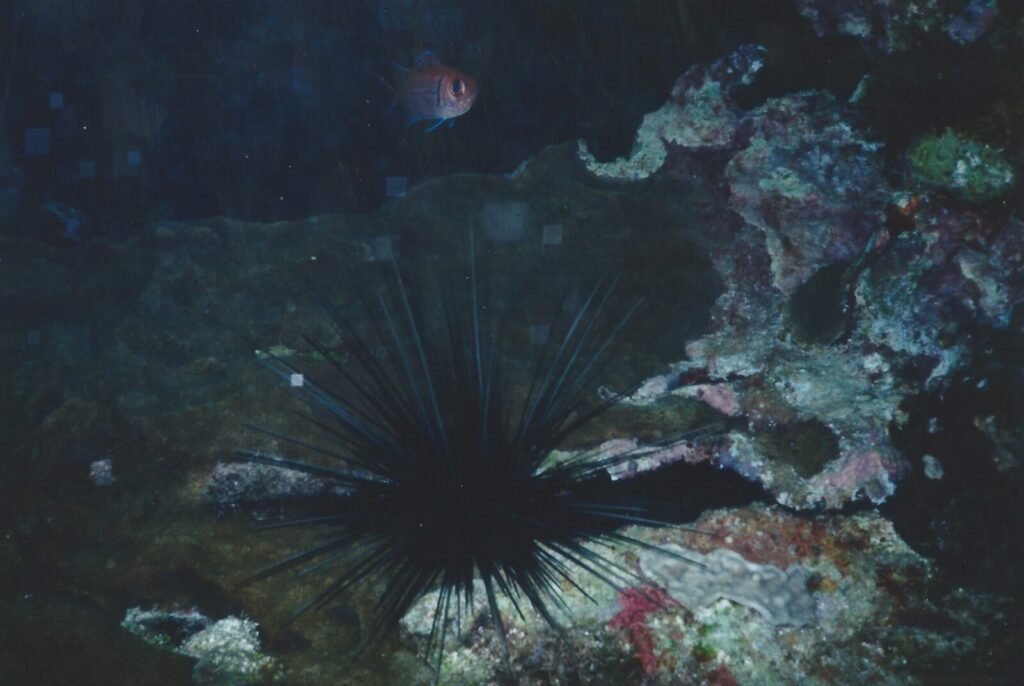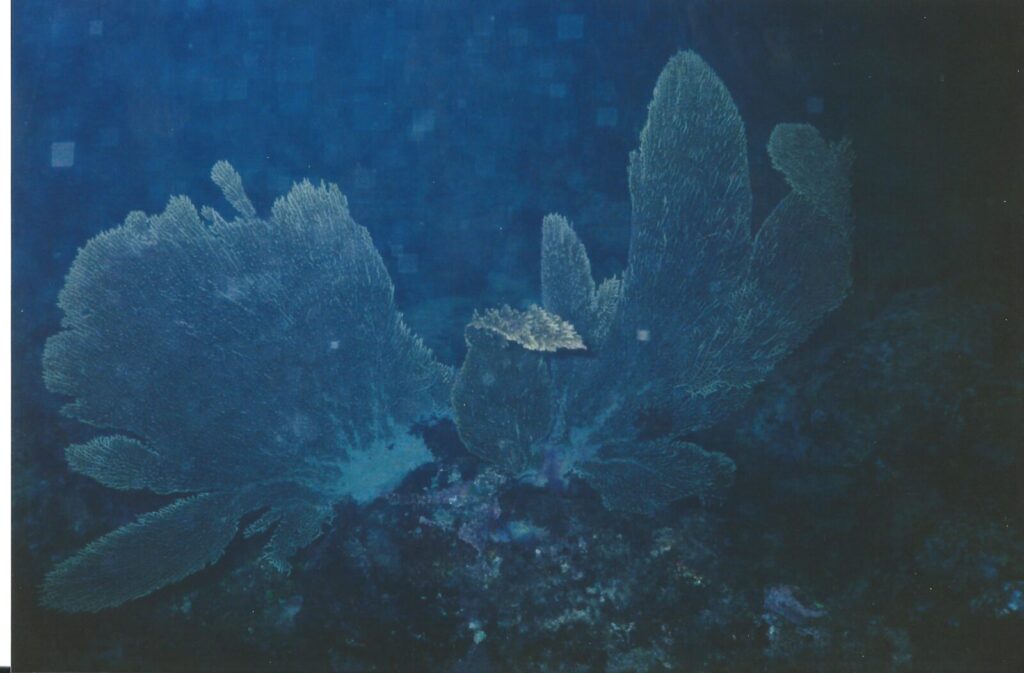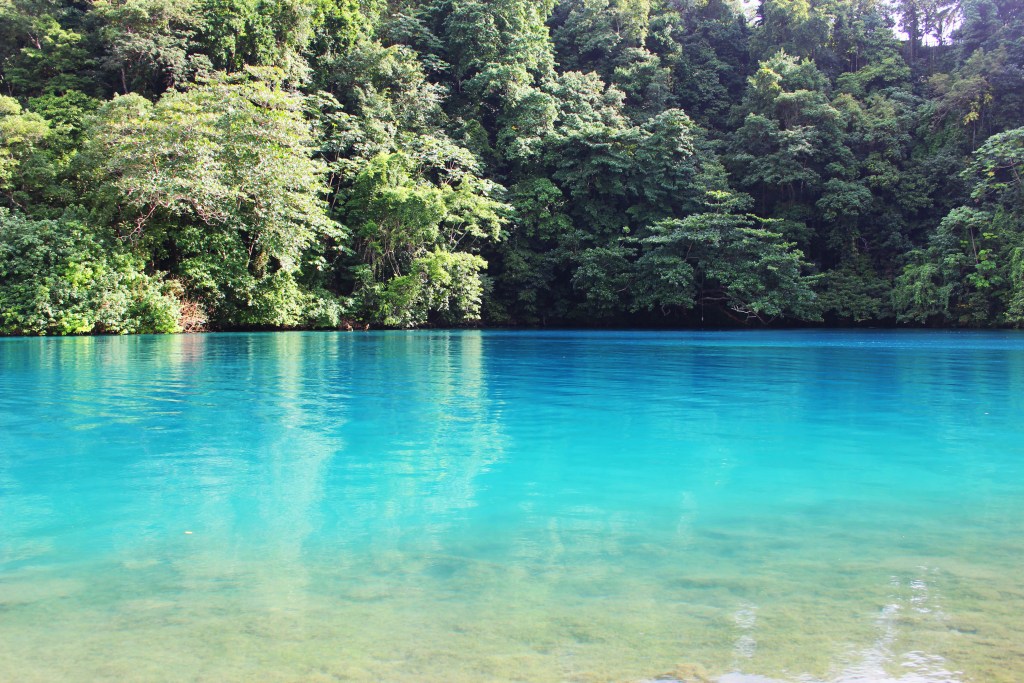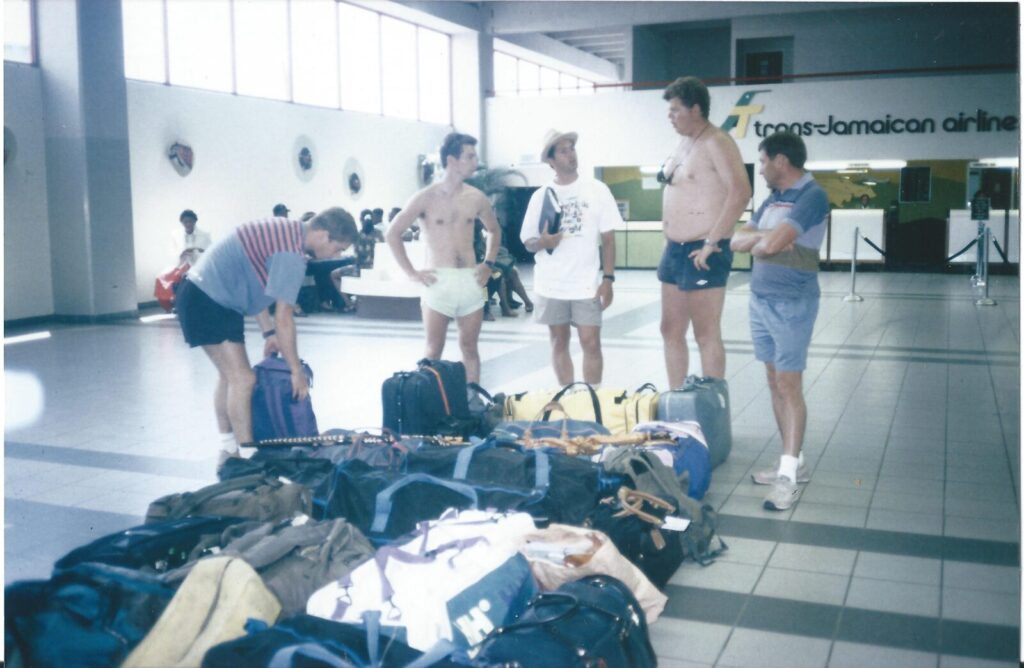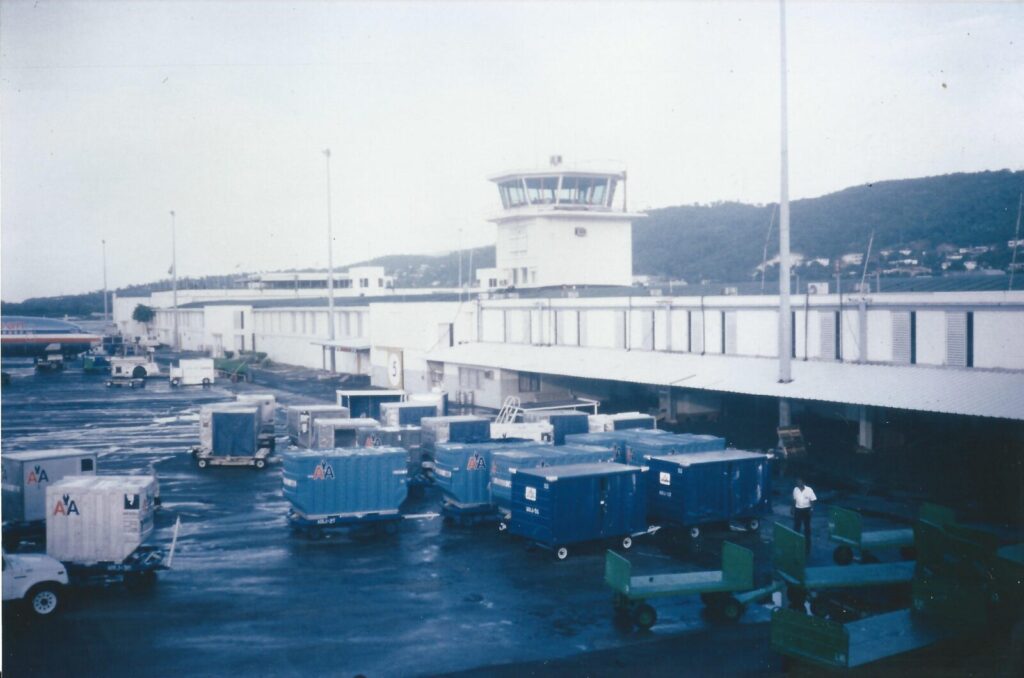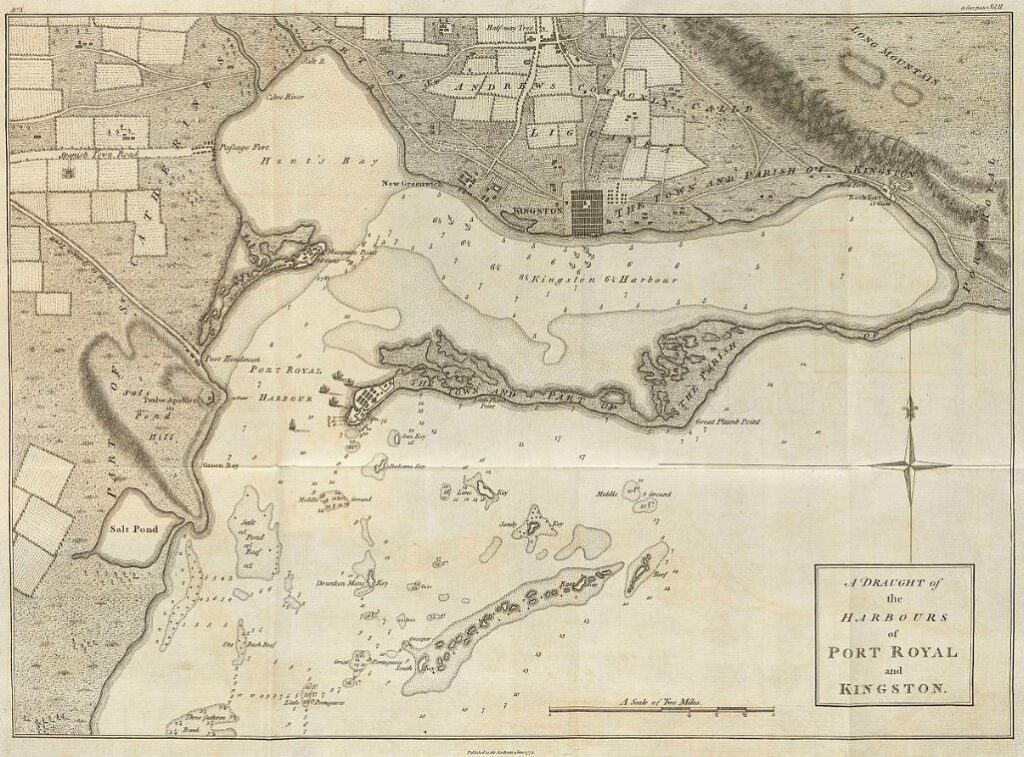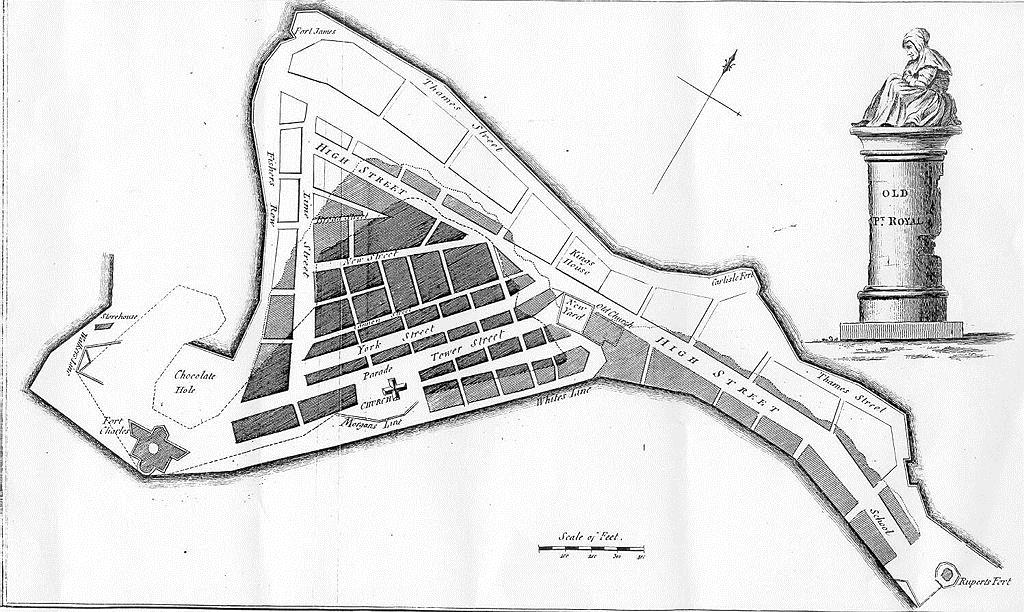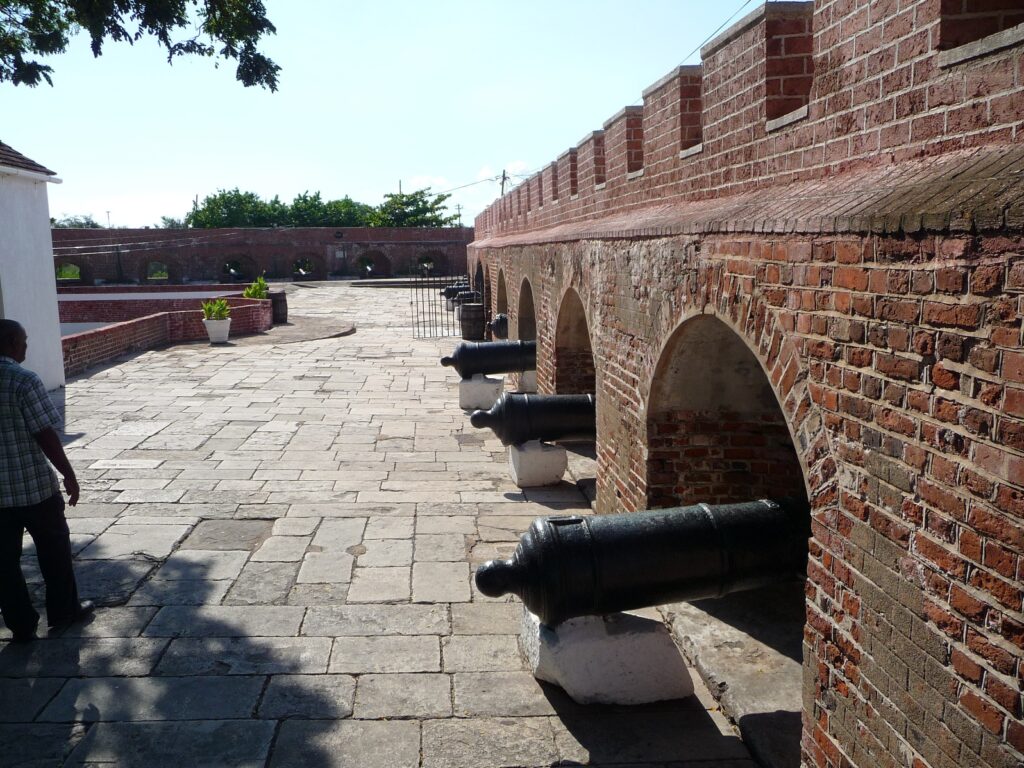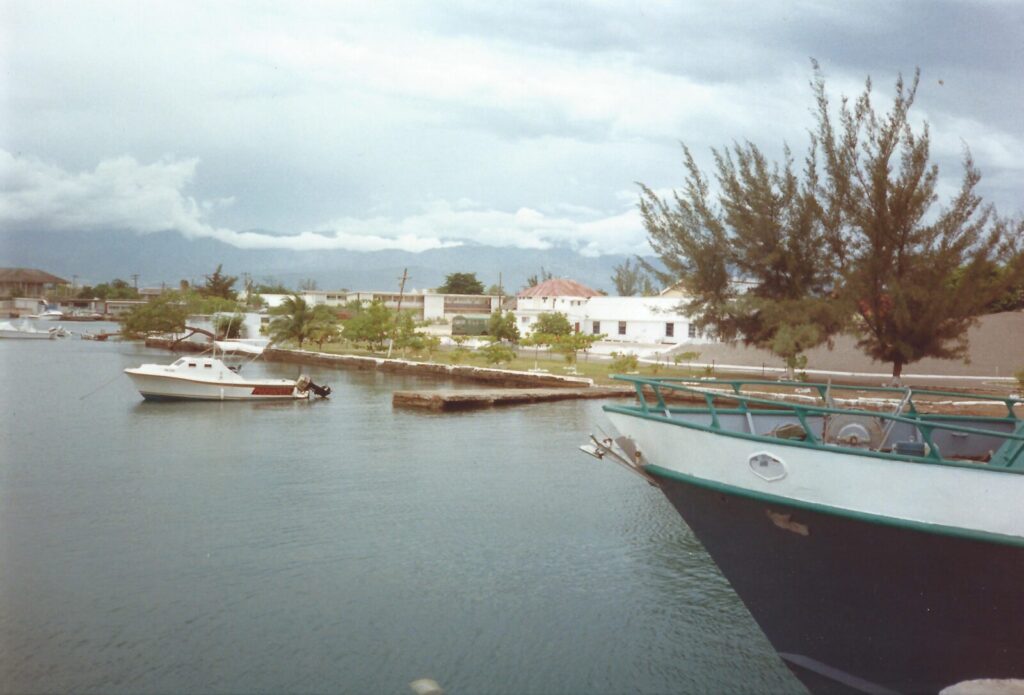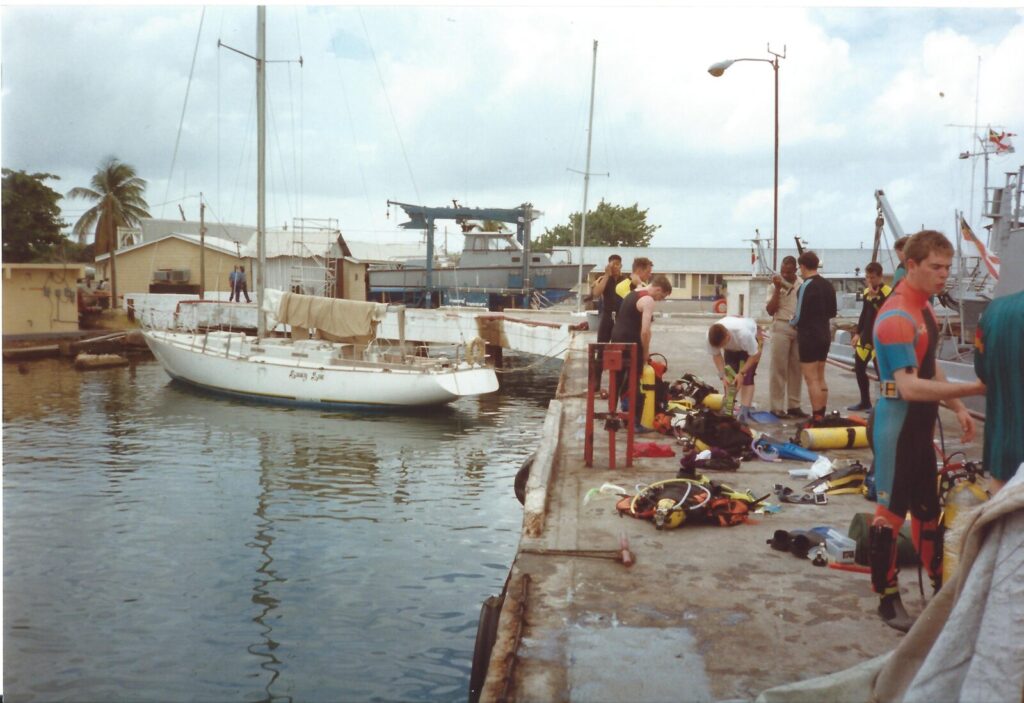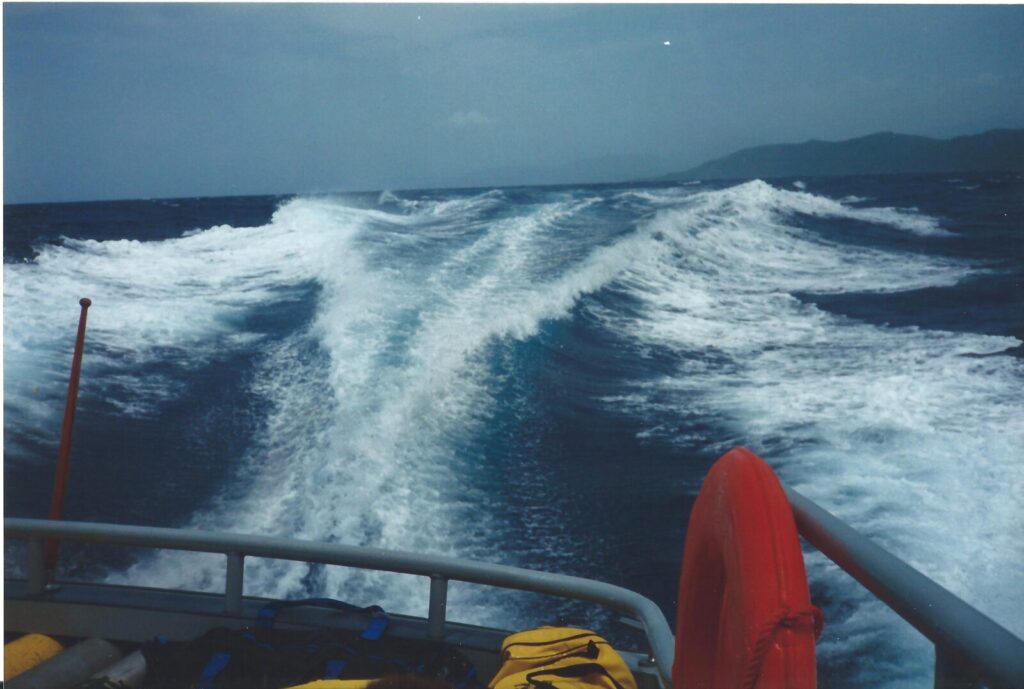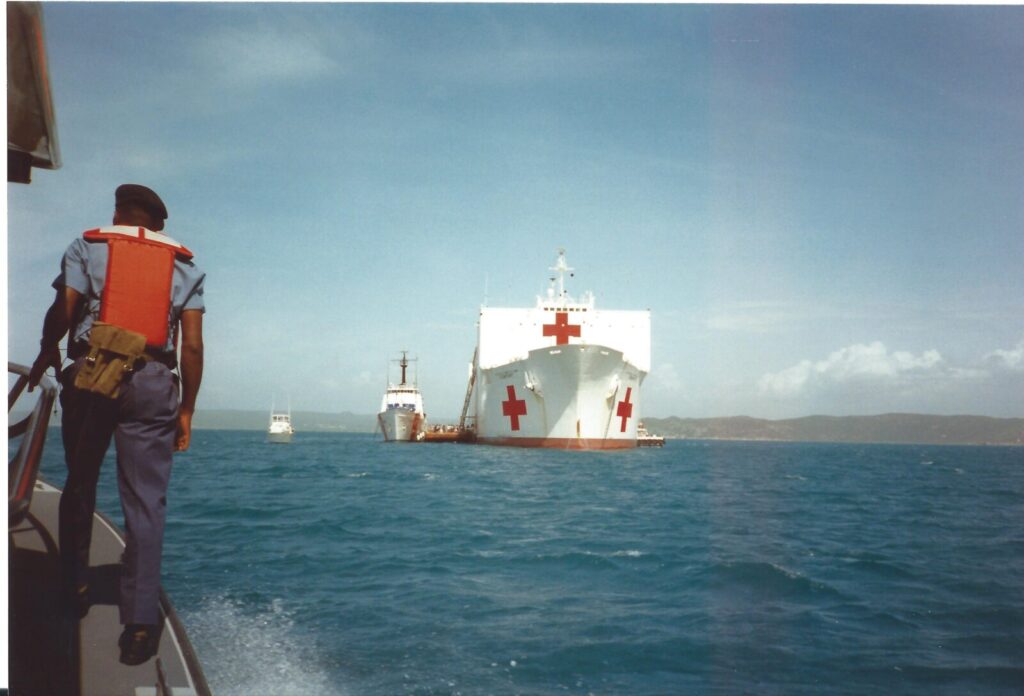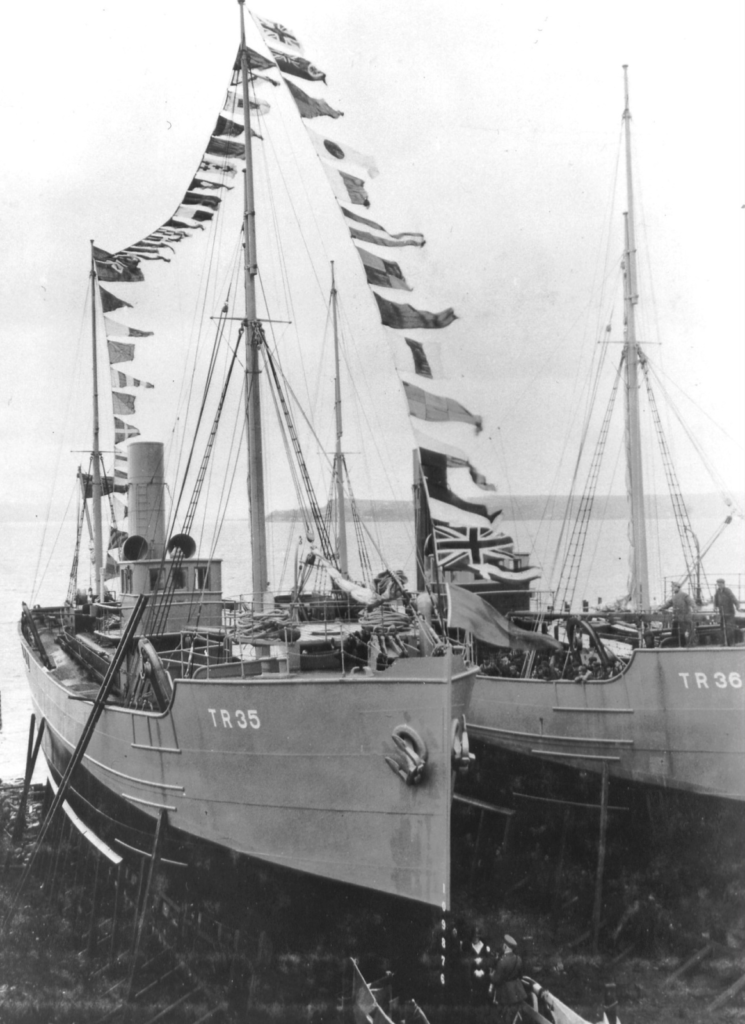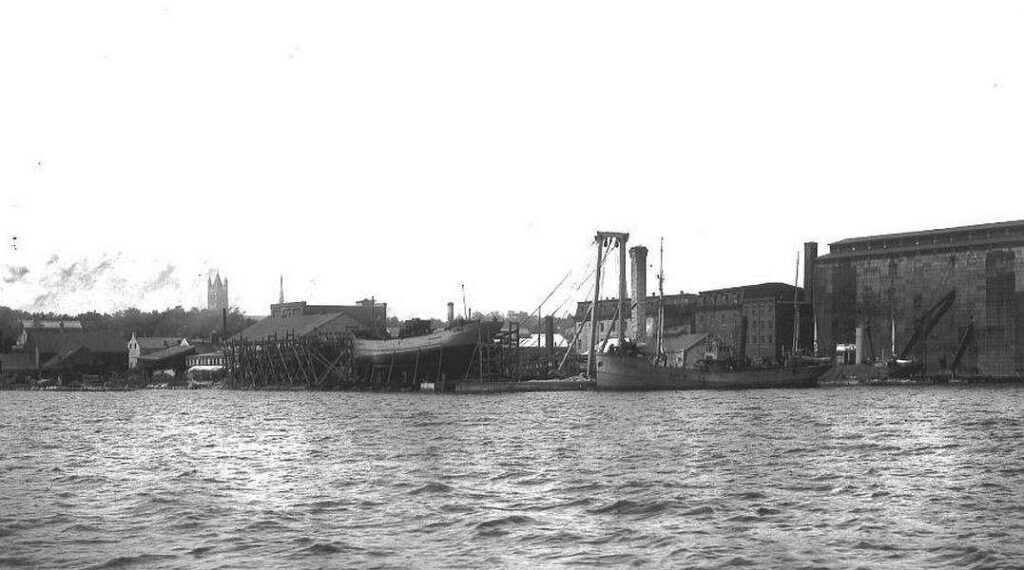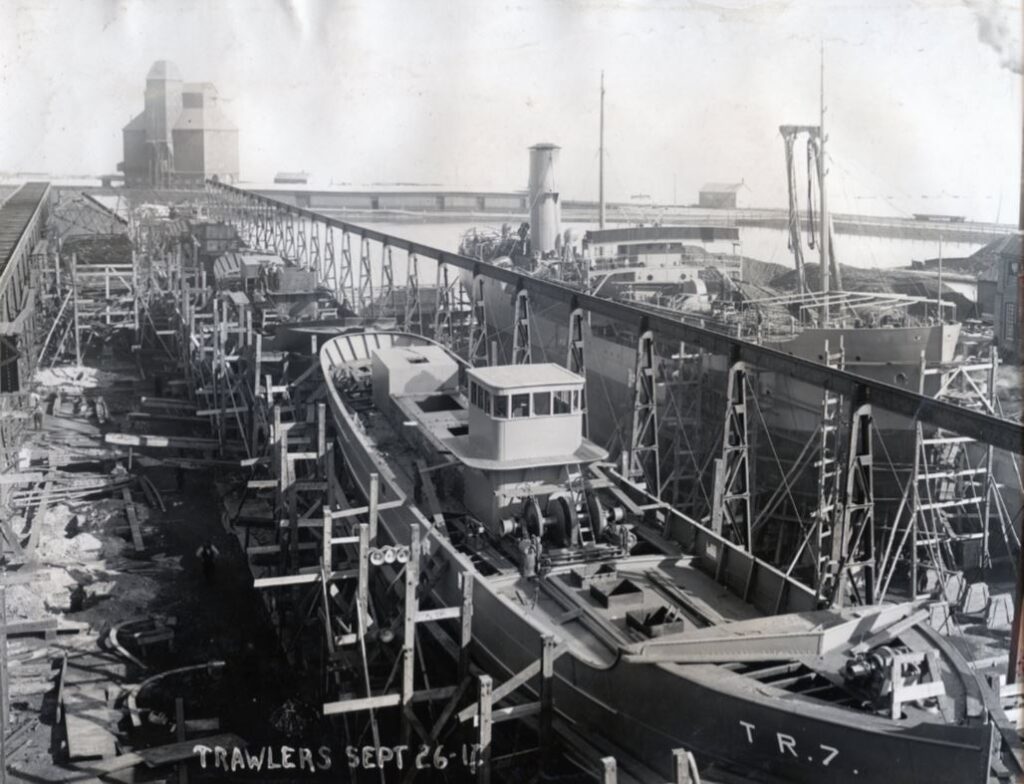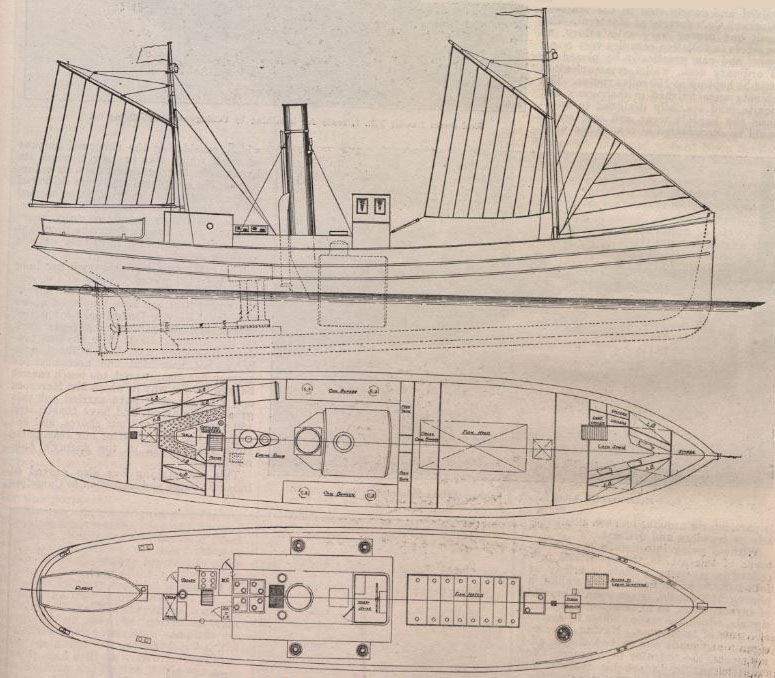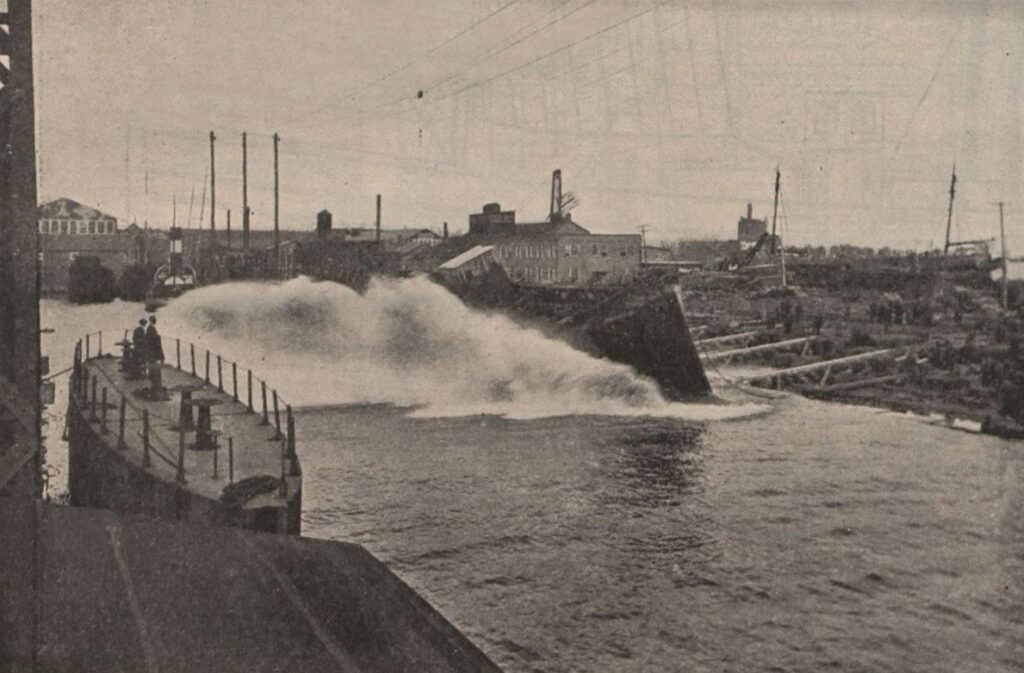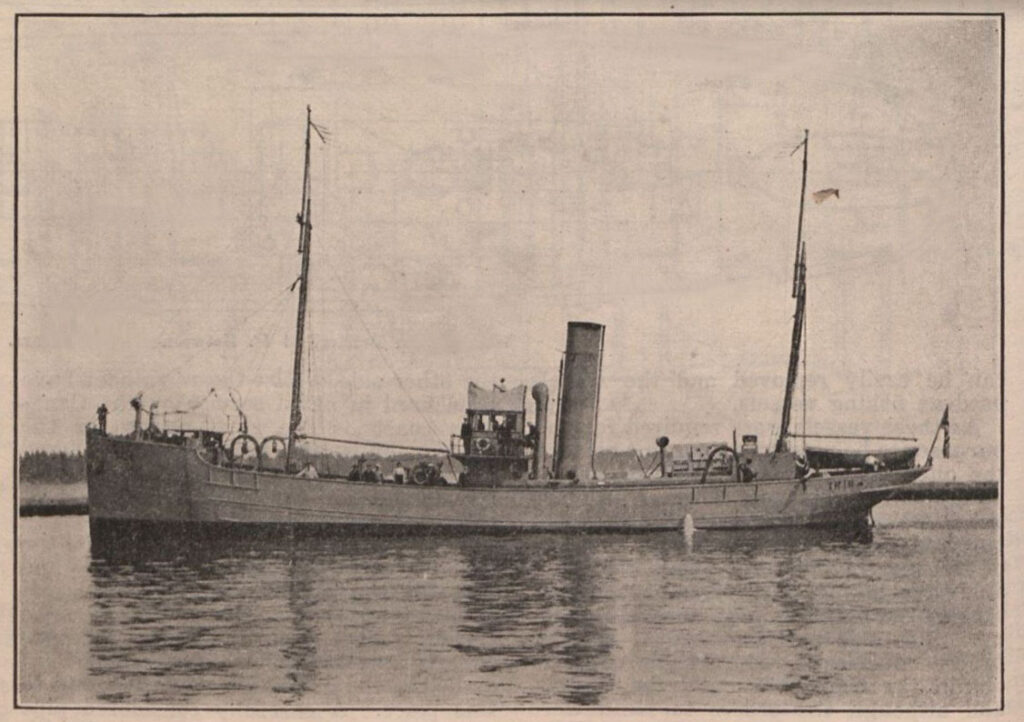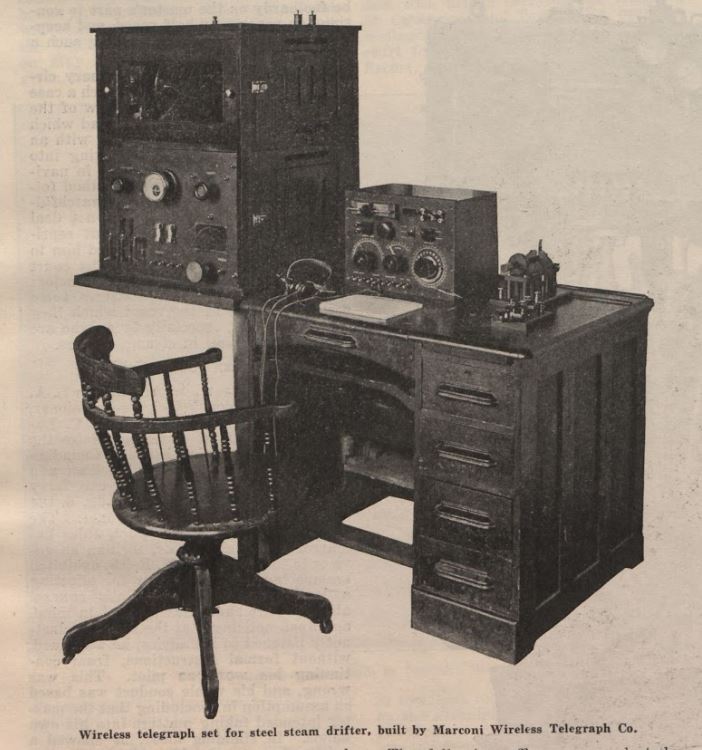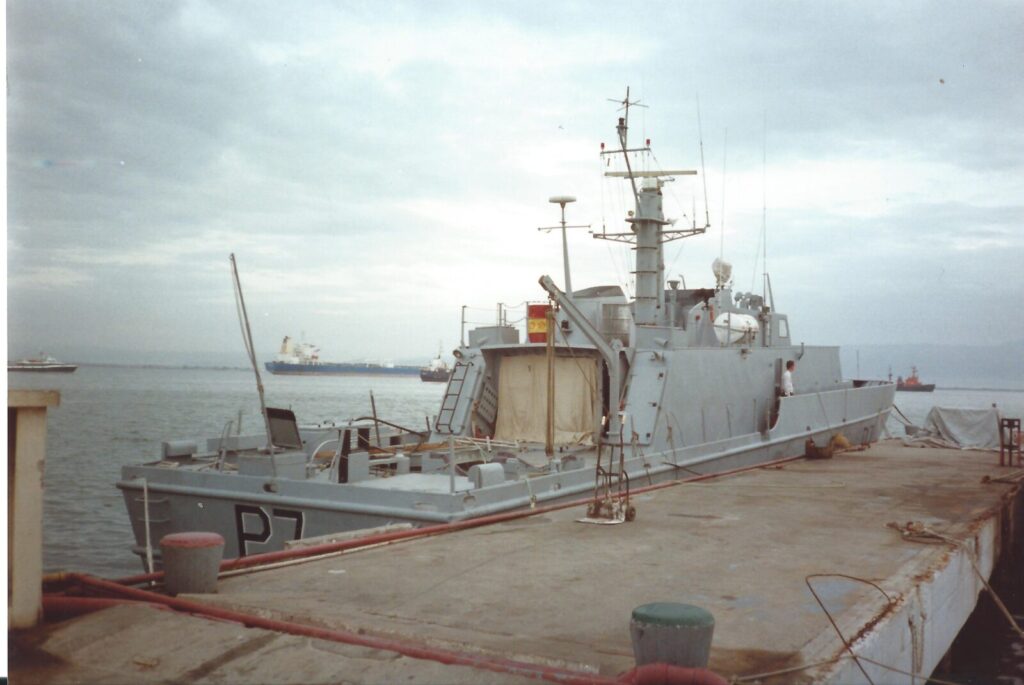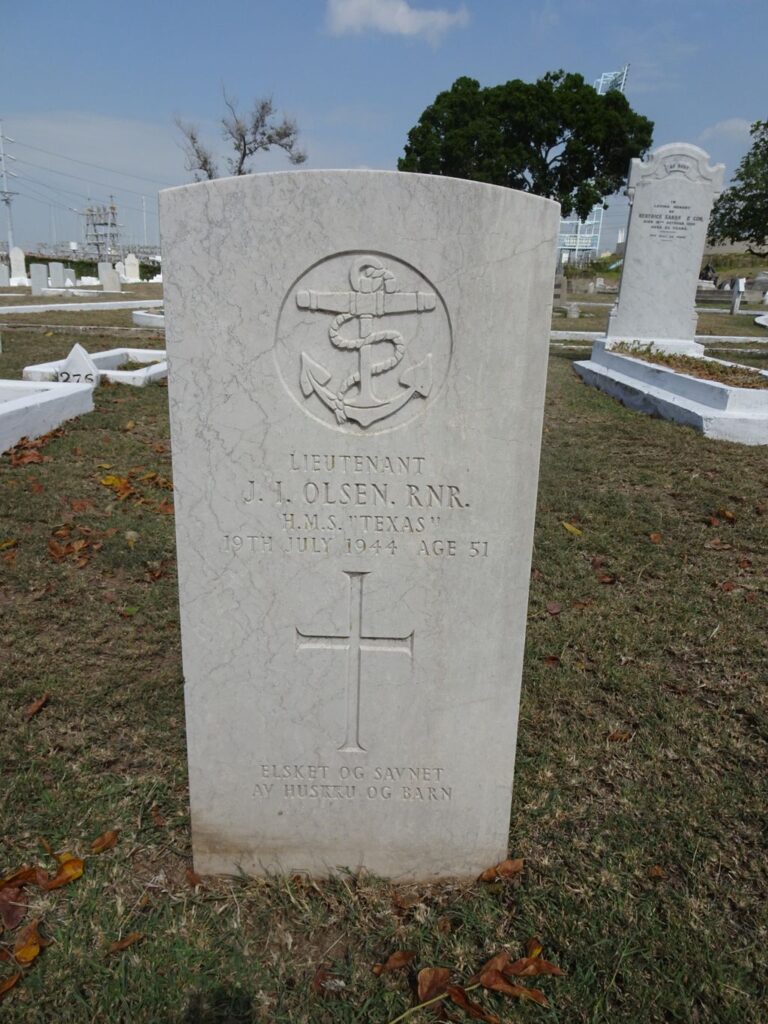Southern Craftsman Phase 1
Exercise Southern Craftsman was underway, the MV St Brandan had done her job well, we were off the shores of Weddell Island and could use St Brandan’s crane to off-load inflatables and all the kit we needed for Phase 1 of our expedition diving the Falkland Islands. The crane cut our work in half, we were ashore despite having to make multiple journeys in what seemed like no time at all, the secondary benefit, the outboards of the two little inflatable craft got tested and warmed up and our boat handling was settled in a little to the local conditions. It was a quarter mile journey from boat to shore, although I wasn’t really sure why the skipper didn’t run up against the little quay at Weddell settlement where we would be staying….The St Brandan was flat bottomed and the quay was designed for mid-range ships that re-provisioned the island fairly regularly, but whatever, I enjoyed the work, loading and stowing kit and balancing the little craft that would be our work-horses for the next 3 weeks or so in and around the South Atlantic Ocean, and the inlets and bays of Weddell and New Islands and, eventually Port Stanley
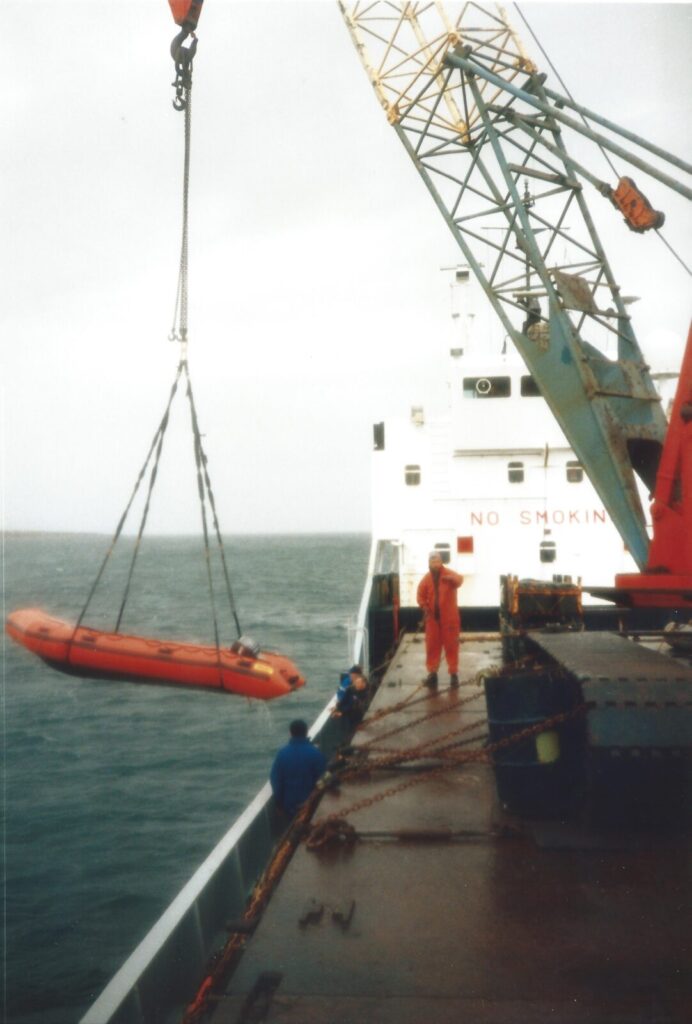
The settlement at Weddell Harbour is sparse to say the least, a combination of a couple of barns, then used to shelter the Island’s owner’s large and impressive RIB, the main residence, and an impressive wood and brick farm-style house and the bunk-house, which would serve as our Island base for the Two weeks we were diving around the island. I spent some time looking at the history of Weddell Island, in the 1800’s the buildings were wool processing factory’s, the main revenue of the settlement, (when it could warrant being called that) being wool and sheepskin, along with the subsistence farming necessitated by such a remote location with such storm lashed shores
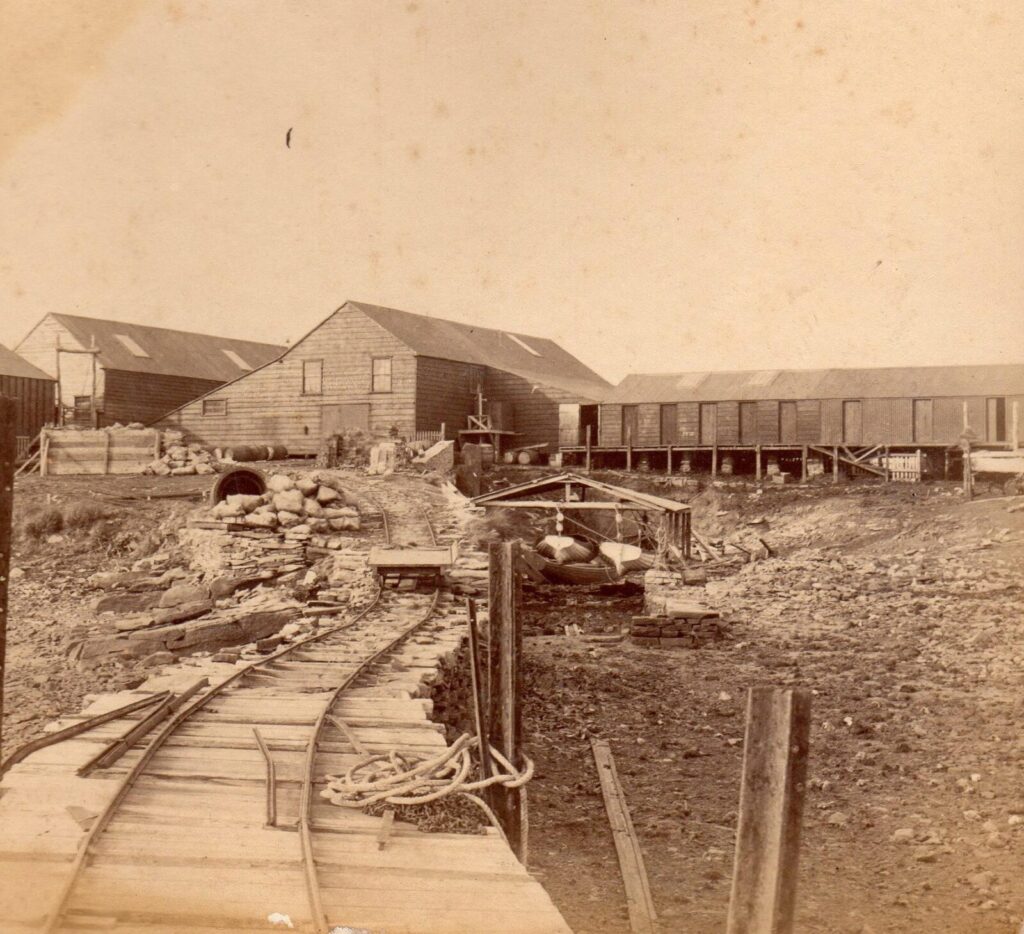
Astonishingly the changes seem minimal from 1889 to 1996, despite over a century having elapsed between the views! If nothing else, it shows a couple of things about the islands, they built well, for wooden sheds to survive the weather in the region in such good shape, for a century and beyond, is quite a feat. It also shows that the islanders re-purpose without much waste, whatever is there is re-used not just discarded or pulled down, although the actual sheep sheds themselves (on the Right of the sepia print) have now long gone
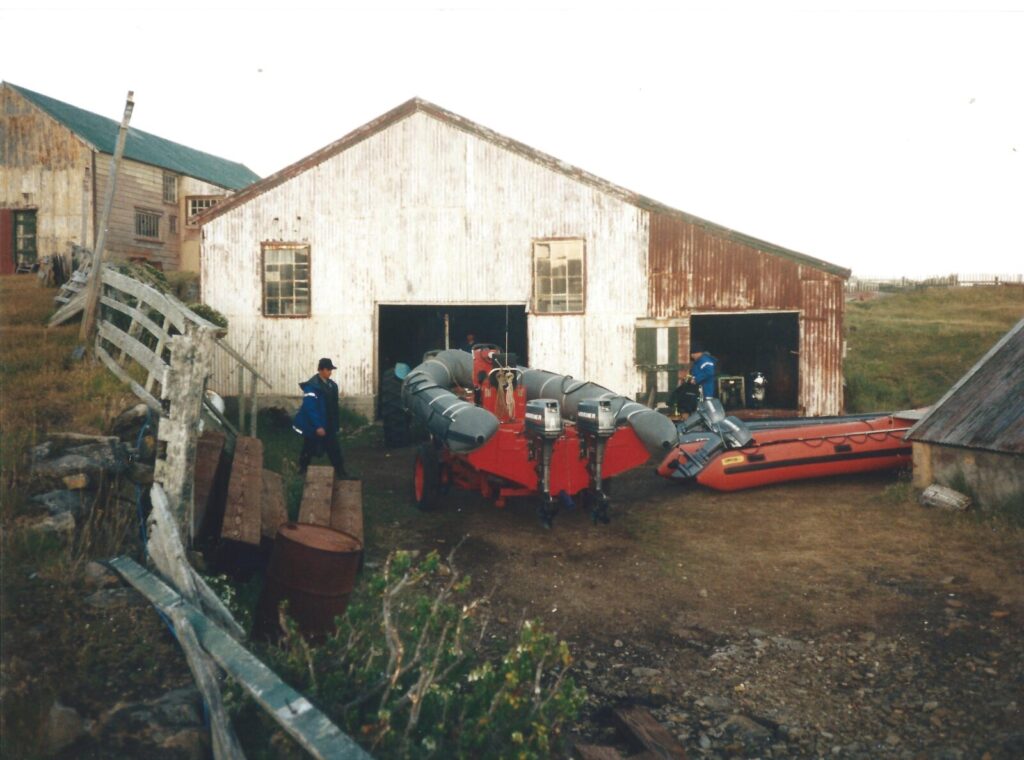
We spent our first day transporting our kit ship-to-shore and then up to the bunk-house. There was a lot to unload and most of the morning went just ferrying, the shore party then land-rovered the personal kit up to the bunk house, and settled the jerry-cans of petrol into the shed, along with cylinders and compressors and the remaining diving kit. The cylinders would all need filling as they had been, out of necessity and to meet transport regulations, emptied before we shipped them. The shore party set-about with a will, we couldn’t wait to get diving! My last dive had been a first, I’d been in the re-compression chamber at Fort Bovisands, for an insight into hyperbaric medicine, on the 11th December of 1995 following the completion of my BSAC Advanced Diver course, now would be another first, my first dive in the South Atlantic! My dive-log recalls: 05th January 1996, “Shore Dive – Gull Harbour – Weddell Island South Atlantic (Falklands) Shakeout dive through the kelp – longest I’ve ever seen – loads of squat lobster & then into an old wooden wreck (a Brig size) plenty of timber left to root round. Over to Port I think. W/Temp 10’ Viz 4-5m Air In 200 Out 150 Buddy Chris” You couldn’t make this up, our first dive on Weddell Island and we had stumbled across an old wreck, it turned out to be the Castalia, a former yacht once belonging to an Earl….. But that is for another story and as any who read this know, will be found in another place on here!
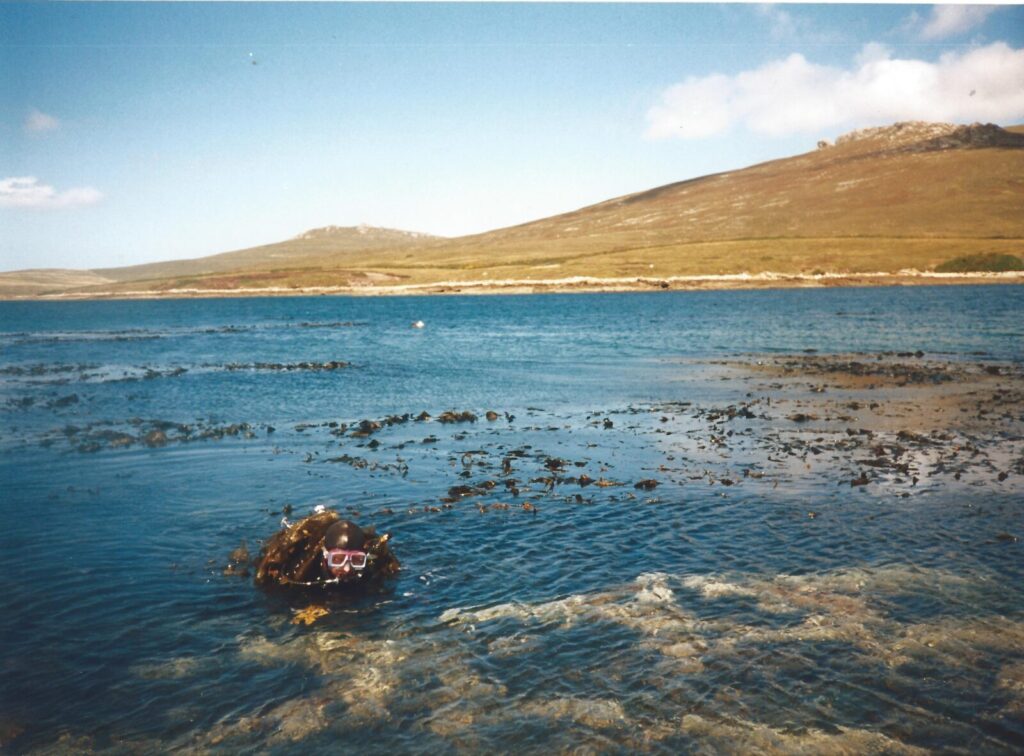
The next morning we were back into the water for some skills refreshers, another shore-dive in the shallows, the bottom in the area was a mixture of sand and rock, with Kelp in isolated areas acting as islands of life, it was in the Kelp you found all the life there was to see, it stretched to the surface as an oasis, forest like, offering hiding places for all kinds of marine life from juvenile fish and mollusks, to starfish, anemones, crab and larger individual fish and then, when you were lucky, the larger mammals like seals, huge eyed and playful, when their innate curiosity overcame their shyness and surprise at bubble blowing, noisy and clumsy things from another world, gate-crashing their serenity…….
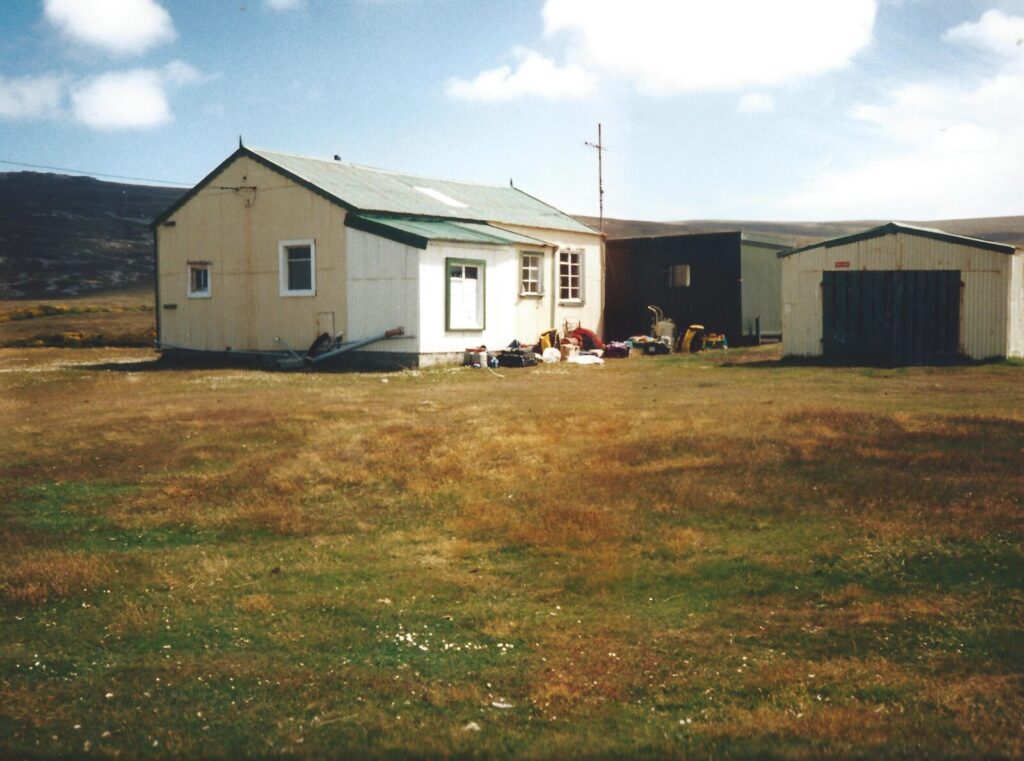
The next couple of dives were local and uneventful, I recorded them without much enthusiasm and I remember them being little to write home about, the log book says it all: “Shore Dive – Gull Harbour – W.I S.A Skills refresher followed by a bimble about – plenty of Crayfish but very little else – boring – Air In 200 Out 125 W/Temp 9’ Viz 3-4m Buddy Chris” that one followed later in the morning of the 6th January ’96 with: “Rib Dive – Gull Point – Weddell – S.A Contour search for the “Weddell” turned into a bimble Some isolated Kelp “trees” & Unusual Starfish. A Dolphin & 2 Penguins on the surface but weren’t interested below W/Temp 9’ Air In 200 Out 110 Viz 3m Buddy Chris” On these occasions the wildlife at the surface outweighed that under the water, it was quite something to be accompanied out in the inflatables by the odd Commerson’s or Peale’s Dolphin and to see Penguins was surreal, not something you see on South Coast dives back in the UK! And we were starting to get the inflatables out and spread our wings a little, moving steadily and more confidently around the island, I wanted a lot more of this, I didn’t come here for shore diving!

The next dive was that afternoon on the Castalia, another look at her and how she sat in the water, on this occasion we found her transom and there were still brass letters showing on the wood sat there since she had been blown ashore in a storm in 1893. Don used the opportunity to do some survey work on her remains and we ran a centre line for a video run down her keel as a guide for the video team. Castalia had an interesting back story and not a little intrigue too, I enjoyed the dives we did on her even though she was close in and hard up to the shoreline, she was an atmospheric dive and that was made even more so in the fading twilight of dusk that evening
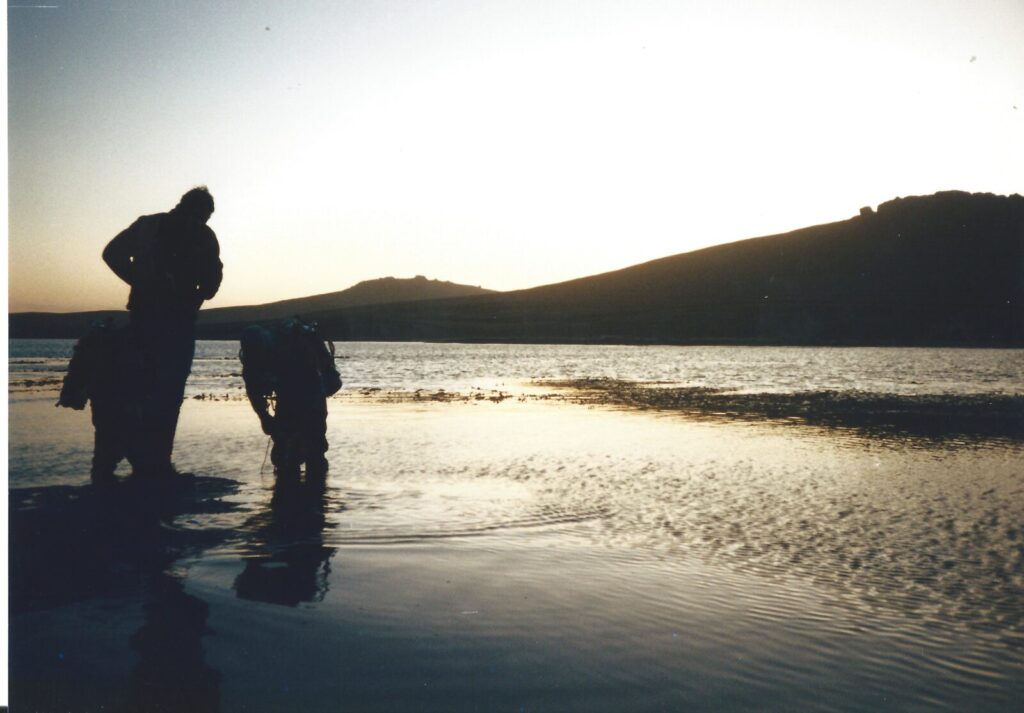
08th January saw us taking the inflatables out to Harbour Island, a short trip down the sound from Weddell Settlement to Harbour Island, about ½ a mile down the channel leading from Weddell harbour, gradually extending the distance as we gained confidence in the outboards and the performance of the inflatables. This wasn’t the place to take undue risks, there was no one out this far to come and help, essentially we were on our own. Don had deliberately made the choice of two inflatables to limit the chance of a single failure becoming catastrophic, we took every dive seriously, there was an O2 kit on each boat and all of us were trained O2 administrators with BSAC lifesaver awards, apart from Two Sports divers One on each boat, the maximum Don would permit gaining “adventurous” dive experience on this trip
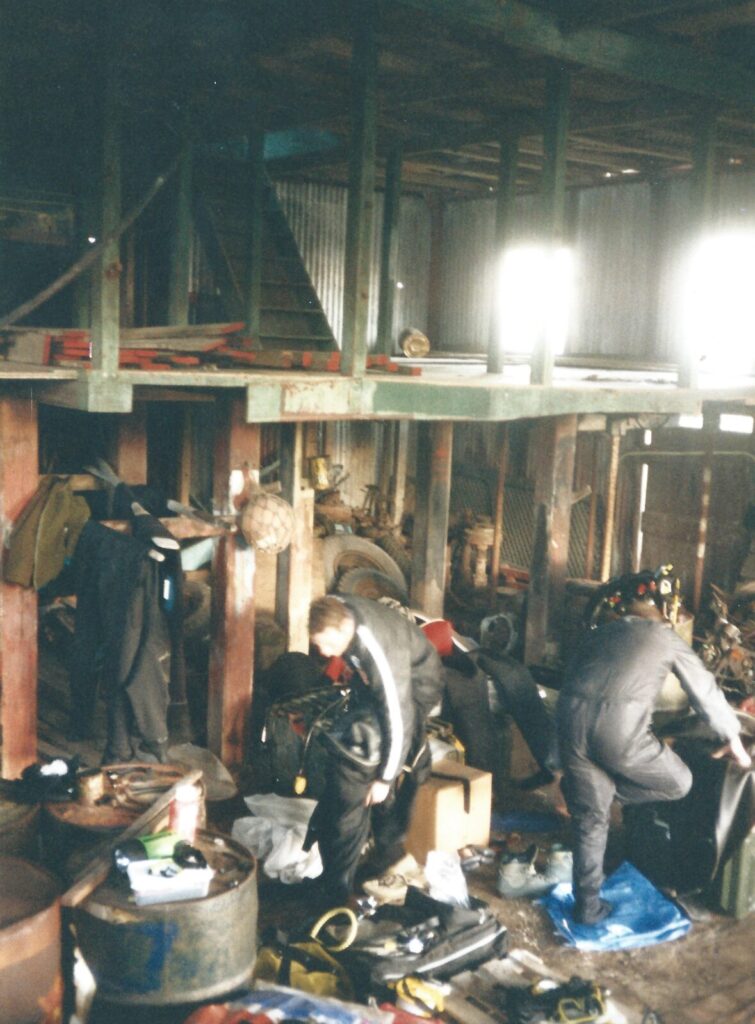
The next dives were decent, a bit more fun, and the log book records: “RIB Dive – Harbour Island – S.A. Scenic bimble round the gully’s – plenty of life – Anemones & Starfish & Squat Lobster & Small fish – Mellow W/Temp 9’ Air In 200 Out 110 Buddy Percy” that was our morning dive, things were getting better the further out we got, it was encouraging, the next dive was at Circum Island and went like this: “RIB Dive – Circum Island – S.A. Scenic bimble again – new area – One lovely Nudibranch White and Clear, plenty of Queenies Mellow – W/Temp 12’ Air In 200 Out 130 Buddy Percy” I can’t account for the difference in temperature on this dive, 4 degrees over a dive at pretty much the same depth between Harbour and Circum Islands, it was odd but I generally looked at the gauge “whenever”, there was no “set” time so it shouldn’t be taken as definitive, perhaps I’d looked at my gauge shallower on the second dive?
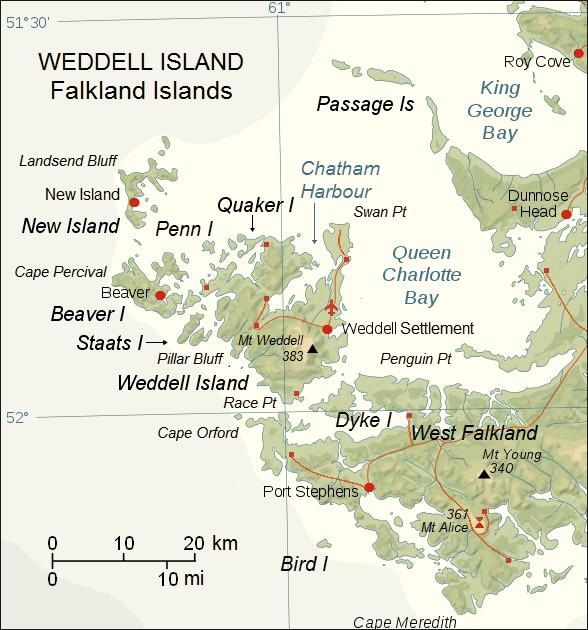
The next Two days on Weddell Island were blow-outs, we knew they would happen, this was an area where sailors spoke in reverend awe of the weather and conditions, Two days, just as we were beginning to spread our wings was a bit of a blow to morale though…. The 11th saw us back in the water, the first team laid out rope lines so video could be taken for the Natural History Museum, and our dive was dedicated to retrieval, the log book says: “RIB Dive – Harbour Island – (S. End) S.A. Retrieving ropes used for lining out video path – all sent up on delayed SMB’s No Problems. Couple of Commerson’s dolphins played around the boat as we exited with a couple of Magellan’s Penguins. W/Temp 9’ Air In 200 Out 150 Buddy Mike” I found I enjoyed “working” dives quite a bit, the challenges of doing anything underwater made you focus and seemed to give the dives a greater meaning, not just a bimble, but a bimble with purpose if you like….. Our afternoon dive on the 11th was at the opposite end of Harbour Island and was logged as: “RIB Dive – Harbour. I. (N. End) S.A. Exploring another site – Isolated rock outcrops & huge Kelp fronds millions of Crayfish (tiny) & then the delayed went up a 7’ Seal/Sea-lion came and inspected us at 6m, so we pushed another 5 mins watching it perform – what a wonderful creature!! W/Temp 9’ Air In 200 Out 140 Buddy Mike” My first experience of a seal underwater, not just off the RIB or hauled out on the rocks, I loved it, sleek and Grey under the water and literally a “ballerina-like” grace in every move, from that day to this I have always relished diving with these amazing creatures!
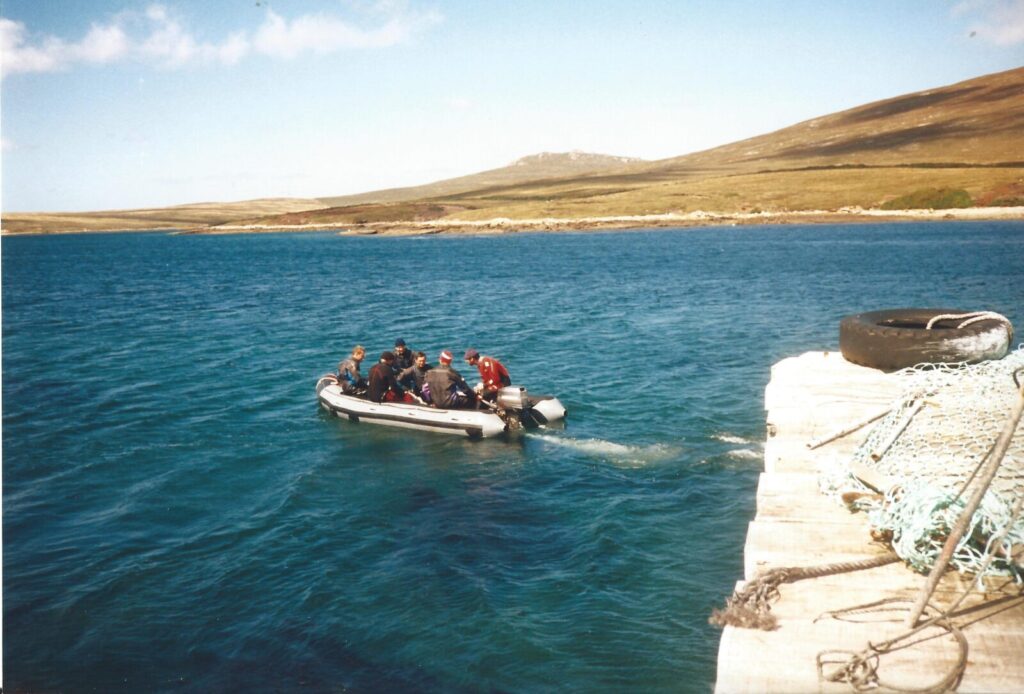
12th of January we were back out and off to another new site, this time Smylie Rock, there were plenty of local names for the various formations around each Island, named for their appearance, or events that happened local to them, naming protocols long lost for the most part, some of the stacks and features were named for their current appearance and some from way-back when, we gave up asking what the background was as the locals often really didn’t know, some of the names probably go back to the “Cape Horner” days…. The log for the 12th Jan says: “RIB Dive – Smylie Rock – Weddell – S.A. Hunt around new site – plenty of micro-life two lovely blue-black banded Crayfish & some Brittle-stars (Orange” – Surfaced near Sea-Lion colony – Huge Male & couple of females. Commerson’s dolphins played surfing on inbound! W/Temp 9’ Air In 200 Out 140 Buddy James” and the afternoon dive was noted short & sweet: “RIB Dive – Harbour I (S.W. End) S.A. Photography with James on Camera In & out of Kelp forest – very atmospheric. Life again was macro – but pretty & lively W/Temp 9’ Air In 200 Out 150 Buddy James” Now I sell this dive short and remember it well at the time, the Kelp was magnificent, the dive truly did feel like we were in a tropical forest, but it is hard to describe the feelings, you are essentially winding your way through vast areas of the same thing, there isn’t a great way to describe the light playing through the kelp fronds scattering like some vast disco-ball across the sea-bed when you write up a dive-log. I remember emerging into what looked like small forest glades where kelp was a little more sparse in a patch, only to have to push through tight knit “trunks” to pass on and continue the dive. It was truly a surprise to see how deep this kelp went, our deepest dives were 30m by decree as we had no re-compression chamber on the islands, the nearest being in Buenos Aires…..and not a good idea to end up asking to use in the circumstances, but you could see the kelp descending well beyond our sight into the depths which meant they stretched at lease to the 40m mark!
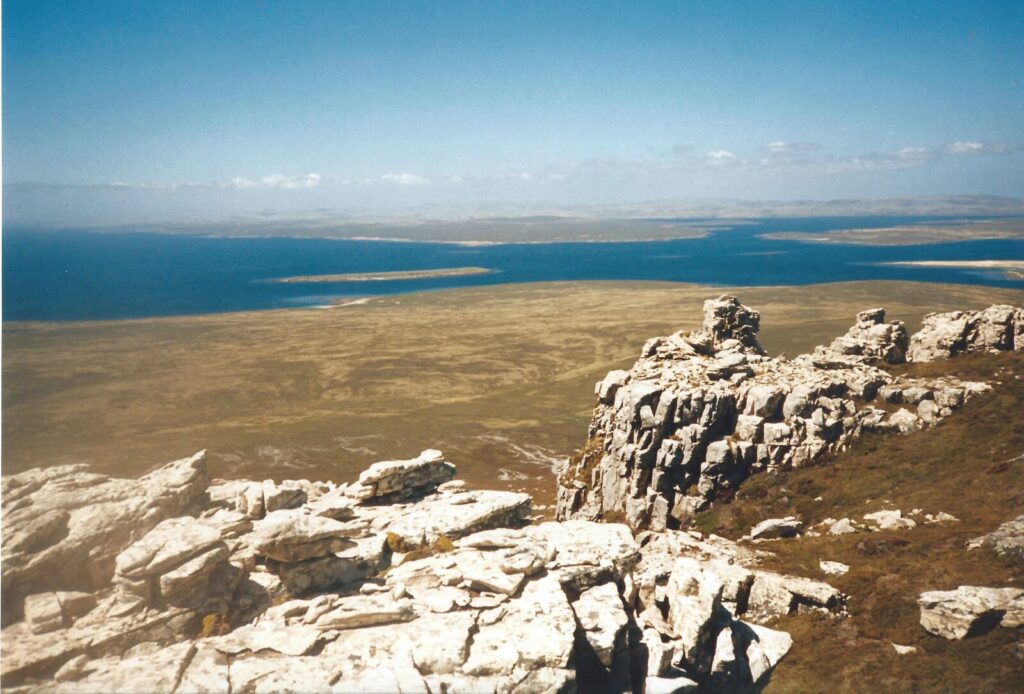
By now I had seen a good deal of what was on offer and was enjoying the adventure of the whole experience, the marine life was special, the nudibranchs we were seeing were small for the most part, but the colours were beyond anything I’d seen before, brilliant Whites, translucent stripes, banded with electric Yellows, and Cobalt Blues, and Brittle-stars, some were quite huge and brilliant Red in colour, and all the sizes in between, the Falklands was indeed a haven for marine-life but our next dives were collections, bagging specimens for the Natural History Museum and I knew I wasn’t going to like it much. I hate condemning creatures of any sort to death, even in the name of science. The dive log records: 13th Jan ’96 “RIB Dive – Harbour .I. Weddell S.A. Collection work for British Antarctic Survey Group. Taking samples on a bearing at 5m intervals & lift bagging to the cover boat. Visited by a Seal at 5m which brought a friend to 10m to play round us – a magnificent pair of creatures friendly and inquisitive W/Temp 9’ Air In 210 Out 140 Buddy’s Simon & Ross” That afternoon we had another treat in store: “RIB Dive- Harbour .I. Weddell S.A. Diving with Commerson’s Dolphins that had been playing with and round the boats! Close enough to touch – magical creatures!! W.Temp 9’ Air In 140 Out 100 Buddy’s Simon & Ross” I loved Dolphins, they often rode our bow waves on the way out or back from the dives and to get them in close whilst we were underwater was special, this was a fantastic dive for all the brevity used in the description and I wished for as many more like it as I could get!
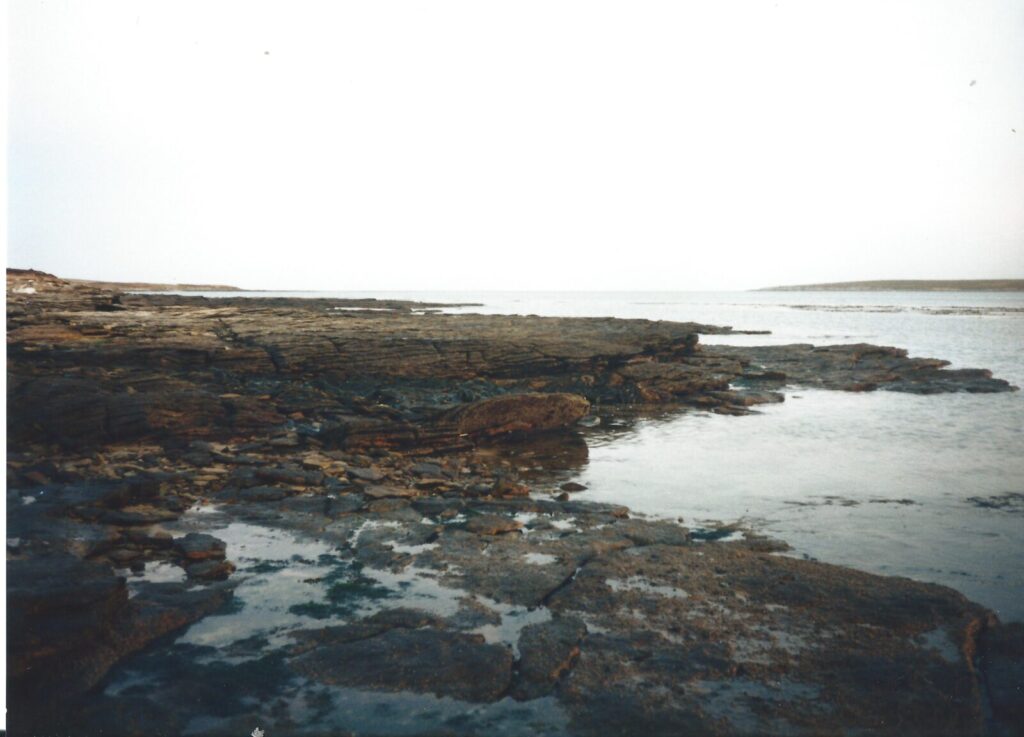
We only had a couple more days on Weddell Island and by now we had seen what we were going to see I thought, the next day on the 14th had been set aside for some skills tests for the Dive-Leader qualification for our Two Sport Divers. The dive was uneventful, which is exactly how it should be considering the skills we were practicing! I wrote it up briefly: “RIB Dive – Weddell Island – S.A. C.B.L Skills Dive for D.L. W/Temp 9’ Air In 220 Out 200 Ross/James” Controlled Buoyant Lift (C.B.L) a way of surfacing an unconscious or incapacitated diver using his own buoyancy control device, controlling his or her ascent to the surface, where further rescue can be undertaken. This we did from 15m and although valuable as practice, something no-one wanted to have to do for real! Given the skills we were performing we only did the one dive that day, it could have been the weather was not too encouraging as well, I do not remember clearly. The next day we were headed out to Mark Point at the top end of the channel, it was a good haul out there but it was worth it as the log records: “RIB Dive – Mark Point – W.I. S.A Diving in a kelp forest – a wonderful dive – like flying through a tropical rain forest. So much life – nudibranchs, Brittle-stars, Starfish & Pin Cushion Stars – Brachiopods everywhere we looked, thousands of Hermit Crabs (tiny) & all wonderful colours especially the Squat Lobsters! 10m Viz W/Temp 9’ Air In 180 Out 125 Buddy Ross” The dive was a good one and we decided to go back there in the afternoon which I logged as: “RIB Dive – Mark Point – W.I S.A Back to the Kelp Forest but further South. Just as wonderful but the Sun didn’t give such brilliant shafts of light as before – the mood was more eerie & dark but winding in – out up and over the Kelp was great the life was just as plentiful but we played with a large Octopus this time and saw more small fish & Two good sized ones – marvellous. W/Temp 9’ Air In 225 Out 175 Viz 5m Buddy Ross” It was clear, Weddell Island had saved its best marine-life dives till last, now what would New Island bring……..
